
NOVEMBER 2O24

A handful of highlights from this year’s event


NOVEMBER 2O24

A handful of highlights from this year’s event
Leaving the limelight as chairperson behind FUTURESCAPE 2024
WINTER KIT SPECIAL Equipment and tips ahead of the colder months

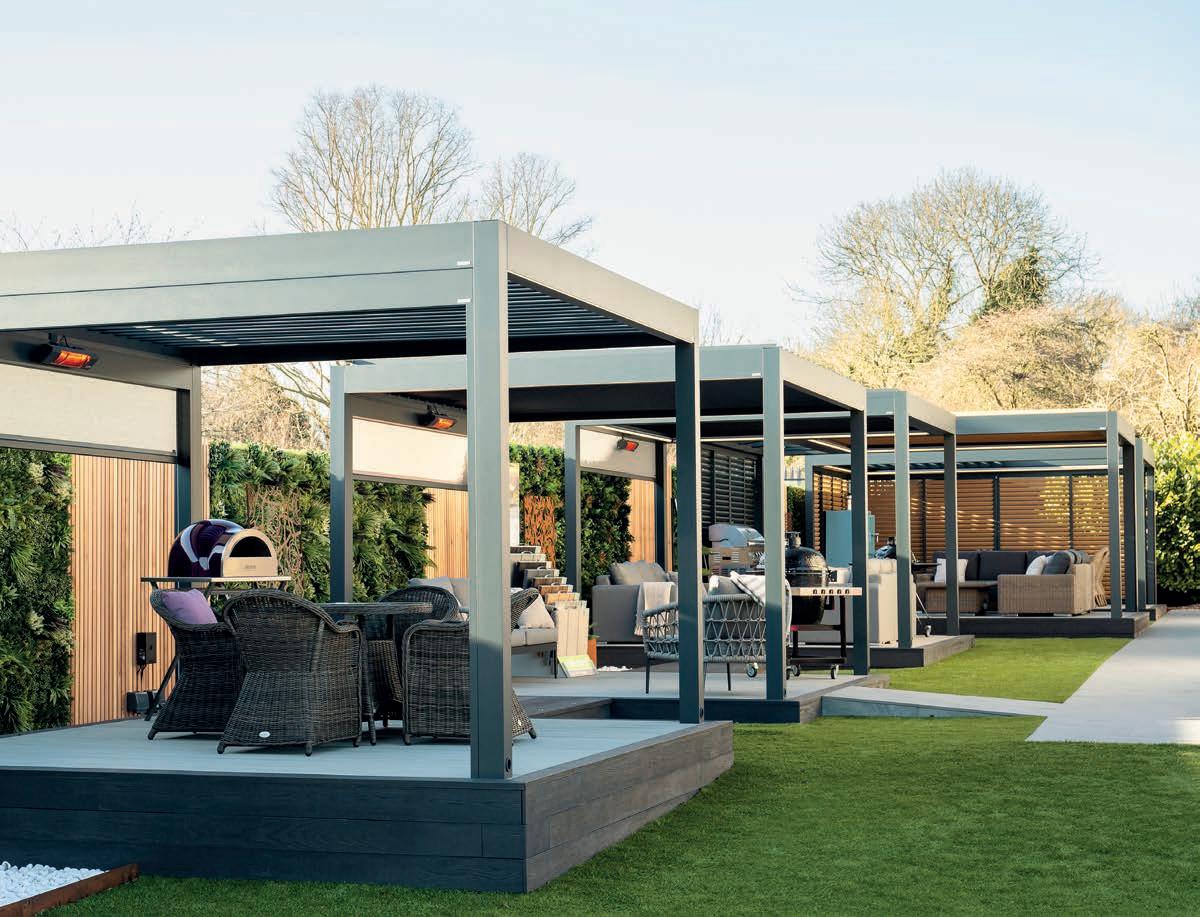

t
trade@cbsolarshading.co.uk
cbsolarshading.co.uk/trade
Eljays44 Ltd, BizSpace, Courtwick Lane, Littlehampton, West Sussex, BN17 7TL
Tel: 01903 777 570
Features writer – Bethany Vann bethany.vann@eljays44.com Tel: 01903 959 394
Editorial assistant – Aidan Williams aidan.williams@eljays44.com Tel: 01903 777 570
Senior subeditor – Katrina Roy katrina.roy@eljays44.com Tel: 01903 777 570
Senior designer – Kara Thomas kara.thomas@eljays44.com
Sales executive – Lewis Everle lewis.everle@eljays44.com Tel: 01903 777 588
Sales executive – Ollie Finch ollie.finch@eljays44.com Tel: 01903 777 579
Horticulture Careers – Ollie Finch ollie.finch@eljays44.com Tel: 01903 777 579
Managing director – Jamie Wilkinson jamie.wilkinson@eljays44.com Tel: 01903 777 589
Divisional director – David Griffiths david.griffiths@eljays44.com Tel: 01903 777 584
Content director – Nina Mason nina.mason@eljays44.com Tel: 01903 959 393
Commercial director – Luke Chaplin luke.chaplin@eljays44.com Tel: 01903 777 582
Subscription enquiries – Laura Harris laura.harris@eljays44.com Tel: 01903 777 575
Printed by Stephens and George Ltd
Published by ©Eljays44 Ltd – Connecting Horticulture. Pro Landscaper’s content is available for licensing overseas. Contact jamie.wilkinson@eljays44.com
Pro Landscaper is published 12 times per year by Eljays44 Ltd. The 2024 subscription price is £128. Subscription records are maintained at Eljays44 Ltd, BizSpace, Courtwick Lane, Littlehampton, West Sussex, BN17 7TL, UK. Articles and information contained in this publication are the copyright of Eljays44 Ltd and may not be reproduced in any form without the written permission of the publishers. The publishers cannot accept responsibility for loss of, or damage to, uncommissioned photographs or manuscripts.
Whilst every effort has been made to maintain the integrity of our advertisers, we accept no responsibility for any problem, complaints, or subsequent litigation arising from readers’ responses to advertisements in the magazine. We also wish to emphasise that views expressed by editorial contributors are not necessarily those of the publishers. Reproduction of any part of this magazine is strictly forbidden.
Pro Landscaper is proud to be an Accredited Supplier member of BALI
Pro Landscaper is proud to be an associate member of the APL

After months of planning and preparation leading up to the two-day event, this year’s FutureScape in association with CED Stone Group feels like it passed in mere seconds. For Pro Landscaper alone, the highlight reel seems endless. In our theatre, we revealed the name of the new green design tool in the works, launched a research project on apprenticeships from Lantra and the British Association of Landscape Industries, and shared that a new allyship toolkit is being developed by Access All Areas.
On top of that, we announced the winners of the Pro Landscaper Sustainability & Biodiversity Awards, as well as hosted a special event to mark the 10th year of Pro Landscaper’s 30 Under 30: The Next Generation in partnership with Green-tech.
FutureScape has grown exponentially over the last few years, even without the addition of its co-located shows. Across these, we featured our first show garden this year, held the first Landscape Performance Live powered by Hyphae Learning, and launched the new StoneScape Expo in association with Hardscape – there was even a pub in association with Pro Tiler Tools, which unsurprisingly proved popular!
The best part of FutureScape remains unchanged, though. It was first launched to bring together the landscaping industry, and that’s exactly what it continues to do. We feel privileged to create what we hope is a hub for new and familiar faces, with various sectors and stakeholders able to connect and help move the industry forward.
Thank you to everyone who helped to make this year’s FutureScape a success!

11
FutureScape 2024
The two-day show was bigger than ever, with a series of new features and memorable moments for the landscaping industry
18 Not at Your Expense
Kim Sones offers a range of practical tips for understanding and managing your business expenses
26
Let’s Hear It From:
Green Genie Brothers Ethan and Jake Thorne are getting their dream jobs thanks to their ever-growing Instagram following


33 A Hidden Gem
Rigden Studio Ltd has turned a Marlowbased courtyard into a year-round retreat, with Corten steel stealing the show
39 A Winding Journey
Paths weave through this plant-filled garden by Rother Garden Design & Build Ltd, leading to a secluded spot
47 Go with the Flow
The new Oudolf Landscape built by Blakedown Landscapes at RHS Wisley has reinvigorated a part of the garden
52 Turn Up the Heat
Give your clients a year-round garden by adding outdoor heating – Sam Moore offers a series of ideas and tips
59 Stepping Down
How do the chairs of associations step out of the limelight when their term comes to an end, and what support is needed when they do?
65 Winter Kit Special
From products to keep you warm to the equipment for site clearance and advice on tree maintenance for harsh weather
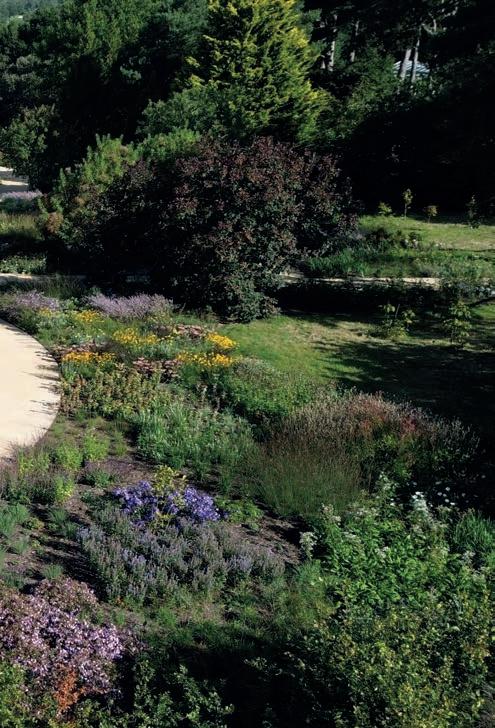
71
A Place at the Table
BALI’s immediate past chair Tess Johnstone shares why more women should consider putting themselves forward for the top role
78
In the Dark
Incorporated well, landscape lighting needn’t be part of the dark-sky movement to reduce light pollution, explains Neil Parslow
81
Stoned? Not likely
David Keegan puts porcelain paving at the top of the pile – it's a more sustainable choice than you might think
16
Pro Landscaper Sustainability and Biodiversity Awards 2024
The winners have been revealed – find out who took home the top prizes, including Sustainability & Biodiversity Leader of the Year

22 Take Back Control
Gareth Wilson shares his experience of designers supplying materials
75
Should we bother to plant trees to save the world?
More informed choices provide the benefits of tree planting, argues Lewis Normand

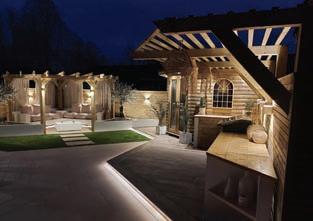

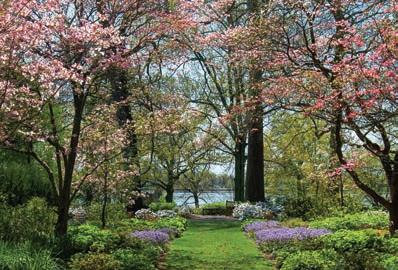
The Society of Garden Designers has announced the shortlist ahead of its annual awards ceremony taking place next February.
The awards will highlight the finest in garden and landscape design excellence. This year’s shortlist features 30 projects across 14 categories, each demonstrating outstanding creativity, innovation, and sustainable design. It has also awarded fellowships to Tom Hoblyn and Arabella Lennox-Boyd in recognition of their outstanding contributions to the profession.
Lennox-Boyd has been recognised for her contributions to horticulture
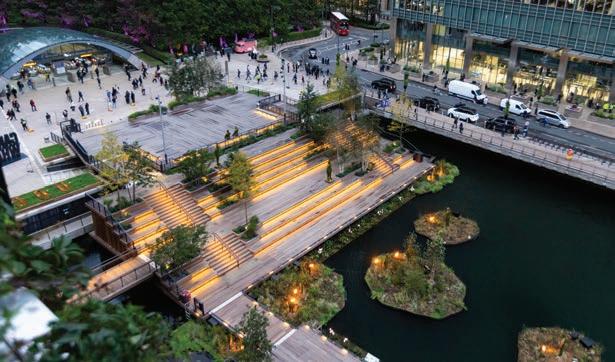
Canary Wharf Group (CWG) has unveiled the Eden Dock, created in partnership with the Eden Project, in a boost to the area’s biodiversity.
The green haven will have a significant positive impact on biodiversity, creating more opportunities for people to connect with nature.
The area now boasts floating forests, aquatic habitats and verdant new public spaces with extensive planting both under and around the dock’s waters.
“Three years ago, we partnered with world-leading charity the Eden Project to help address biodiversity loss in cities through the greening of Canary Wharf,” says Shobi Khan, CEO, CWG.
“Eden Dock is the first of its kind, a best-in-practice global example of how we can support biodiversity gain in cities and pioneer places where nature and people can both thrive.”
Howells was the masterplanner for the project, with landscape design by HTA Design. group.canarywharf.com
and design with numerous accolades, including the RHS Veitch Memorial Medal and an Honorary Doctorate of Design from the University of Greenwich.
Meanwhile, Hoblyn FSGD is an acclaimed landscape designer, horticulturist and plantsperson and has been recognised for his innovative approach to garden design.
His career spans numerous award-winning projects, with a particular focus on the use of natural landscapes to create contemporary and sustainable gardens. sgd.org.uk
The National Trust has appointed Sheila Das as the charity’s head of gardens and parks, to replace Andy Jasper who left the role in September.

Das will begin her new role in early January of next year, while Jasper left last month to become group chief executive officer at the Eden Project.
Having changed career in the early 2000s, Das studied at Kew Gardens, worked for English Heritage, and has been a garden manager at RHS Garden Wisley with responsibility for education, edibles, seed and wellbeing since 2015.
“I am so excited to be joining the National Trust as head of gardens and parks. Horticulture is in an exciting phase at present that offers so many opportunities to improve our relationship with our wider environment as well as enhancing quality of life for every one of us,” says Das.
“I look forward to working with the team of talented gardeners in such a huge range of gardens and parks and sharing the joy of gardening through these special places.”
Her time at Wisley has included major investment projects including the development of the Hilltop landscape which features gardens for wildlife, wellbeing and food. nationaltrust.org.uk
ANN-MARIE POWELL HONOURED BY GREAT FOUNTAIN
Ann-Marie Powell says ‘it’s an honour’ as her studio is picked to reimagine the planting scheme for the Great Fountain Garden at Hampton Court Palace. Its next phase is to focus on sustainability and biodiversity, which Powell’s studio will work on to create a new permanent planting scheme.
Powell says: “What an honour to work on such a historic site! It’s a bit surreal to think we’re contributing to the ongoing story of this iconic palace.”
The studio will be working with the gardening team at Historic Royal Palaces for the project, which aims to have practical changes start in autumn 2025.

The aim of the project is to “create a garden that’s not only vibrant yearround but also kinder to our planet,” says Powell.
“We’ll be including more perennials, naturalised bulbs and shrubs that will reduce carbon emissions and boost soil health.”
ann-mariepowell.com
Land Use Consultants (LUC) has revealed a 20% increase in turnover for 2023, as it announced its latest financial results.
Gross profit also rose by £4m, while overall profit rose by close to £50k to £620k, however, administrative expenses rose by £3m.

However, it did acknowledge that some of its markets struggled with rising costs and difficult political conditions.
“2023 was a year of continued commitment to our clients and our values,” says Jon Grantham, managing director of LUC.
“However increased staff costs and challenging conditions in some of our markets led to a lower profit than the previous year. We felt a slowdown in certain sectors of the construction industry, as projects were impacted by factors such as rising construction costs. Public sector budget cuts and uncertainty surrounding the general election also played a part.”
landuse.co.uk
The HTA has followed up its statement about the ongoing situation at the Sevington Border Control Post with a letter to the new Defra minister, calling for urgent action.
The HTA initially spoke out about the situation on Wednesday criticising Defra for a lack of communication, as there have been suggestions – since refuted by Defra
– that 11 trucks have been held at the Sevington BCP. Defra did issue a statement after an enquiry from Pro Landscaper the day after the HTA’s initial comments, although this did not address the complaints about communication.



KINGSBURY CREDITS WOODY PLANTS FOR COMMEMORATIVE GARDEN ROLE
Noel Kingsbury believes a desire to use more woody plants was a factor in him being recruited to select plants used for The Regent’s Park garden project, in honour of the queen.


PRO PODCASTER: OUR TOP EIGHT HORTICULTURAL PICKS
Yes, the horticulture industry has a lot of podcasts to let wash over your ears and smile as you take a well-deserved break – we delve into which should be your picks.


WORLD MENTAL HEALTH DAY: NURTURE GROUP AND TYLER GRANGE DISCUSS THEIR APPROACH
To mark World Mental Health Day, we reached out to the likes of Tyler Grange and Nurture Group to hear more about their approaches to the subject.
In the new letter, the HTA calls for urgent action, reiterating the negative impact that the introduction of the BCP system at the end of April has had.
The letter says: “Whilst we welcome the government’s stated mission to reset the relationship with the EU, including supporting a new approach to EU-UK SPS arrangements, inclusive of the area of plant health, urgent action on the here and now is needed.” hta.org.uk






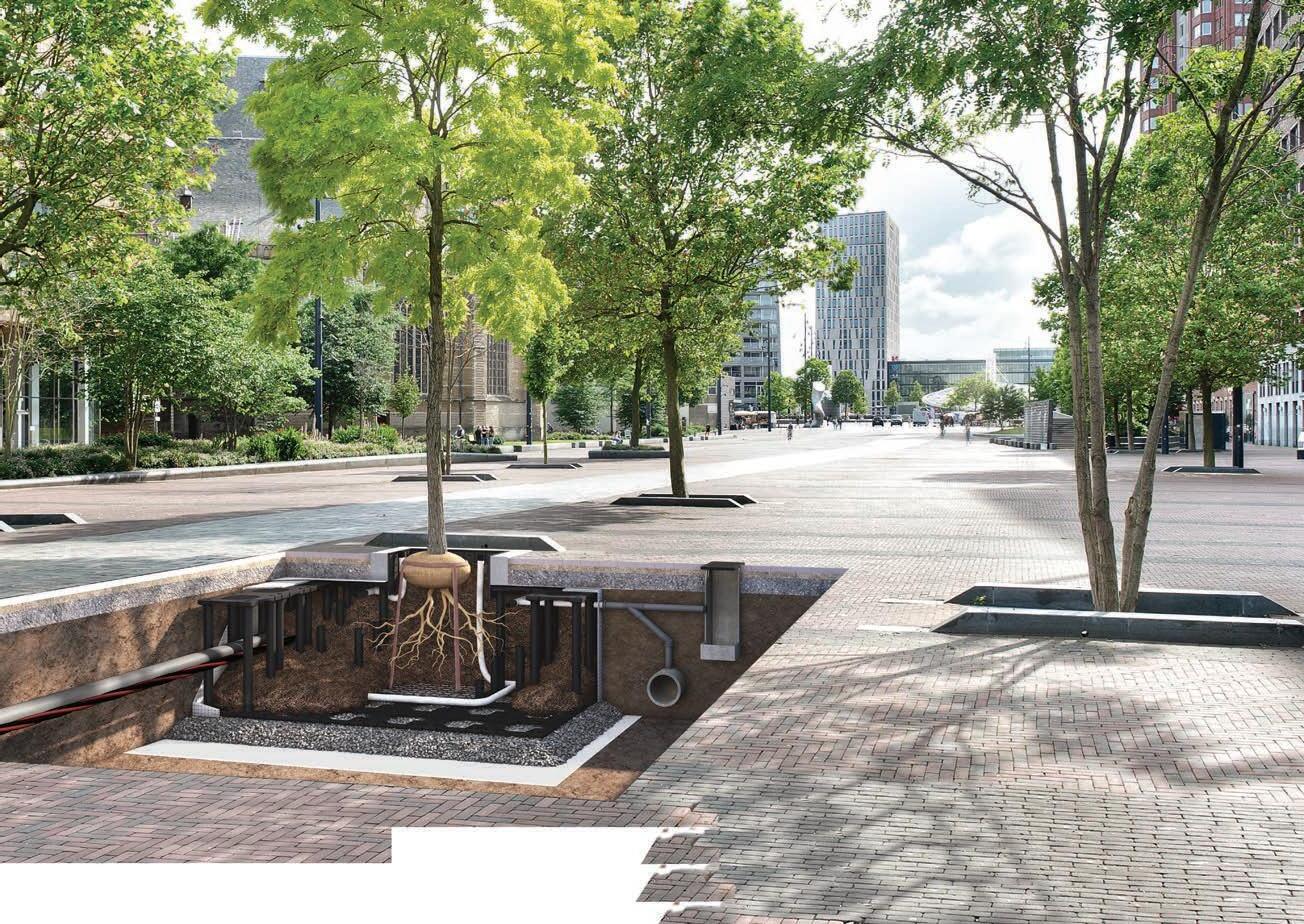
TreeParker is an urban tree planting cell system with superior functionality. The system can be installed in any tree planting space, even staggered or circular, making it easy to customise the tree pit design to your needs. It is manufactured by Treebuilders and distributed in the UK exclusively by Green-tech.
Order today by calling 01423 332100 or order online at www.green-tech.co.uk
sales@green-tech.co.uk
This year’s FutureScape in partnership with CED Stone Group was bigger than ever, and that’s on top of its co-located shows: the Outdoor Living & Wellness Expo, the Public Spaces Expo and the new StoneScape Expo in partnership with Hardscape. Here are just a few of the highlights from the two-day event, which took place on 15 and 16 October at the ExCeL in London .

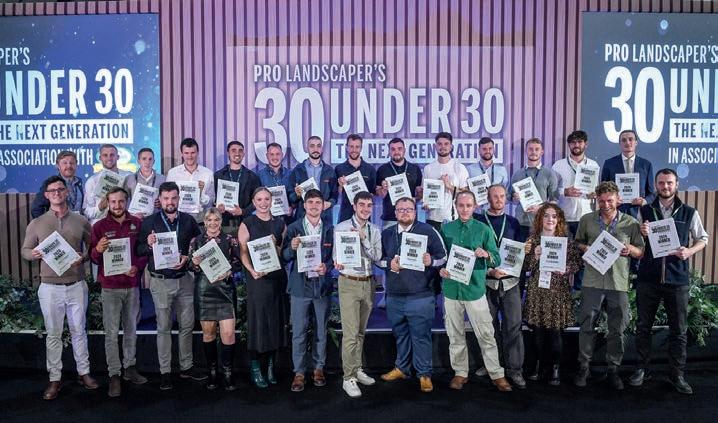
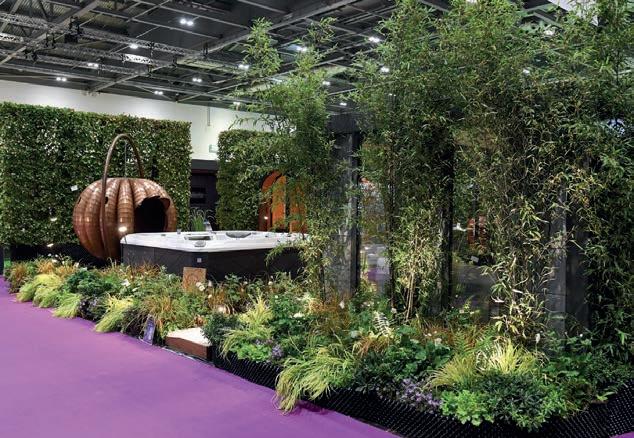
“Attending the event was a great experience for Addagrip. The footfall was strong, and it provided excellent networking opportunities for us to connect with industry professionals.”
Addagrip
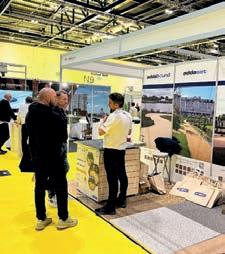
Public Spaces Expo in partnership with Hardscape and the Outdoor Living & Wellness Expo returned for the second year


“FutureScape 2024 was a fantastic opportunity to showcase Bury Hill’s qualityguaranteed soils and landscaping materials, catch up with clients, and form new relationships. The insightful seminars and live debates with expert speakers added great value. A big thank you to the organisers for a well-executed and successful event.”

Demonstrations took place in Landscape Performance Live powered by Hyphae Learning, as well as The Decking Hub in partnership with the Decking Network and sponsored by Millboard
The first StoneScape Expo in partnership with Hardscape took place, with a series of dedicated seminars as well as exhibitors
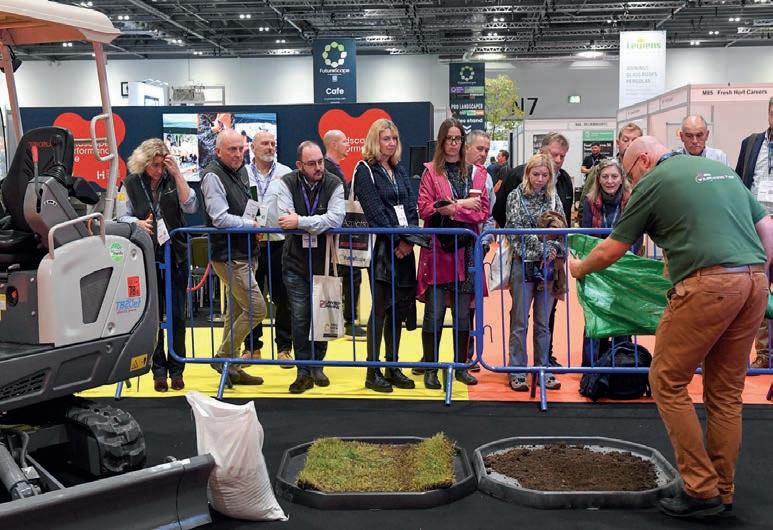

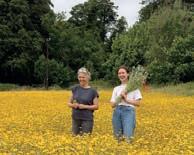
“FutureScape was an incredible experience for Meadowmania this year. We had the chance to connect with many of our existing customers while also meeting new ones, and left with an impressive list of leads. It was a fantastic opportunity to showcase how Meadowmania can assist landscapers, land managers, and gardeners in creating and establishing British native wildflower habitats. The energy and engagement at the show were outstanding, and we’re excited about the future opportunities it has opened up for us!”



The Business Theatre in partnership with Lantra covered everything from creating video content to managing growth to retaining talent
"Futurescape 2024 was the perfect place for landscape architects, property developers and garden designers to be introduced to our new range of stainless steel, glass and aluminium balustrade and railing systems. Our Easy Alu high-grade aluminium and versatile modular railings stole the show offering both aesthetic appeal and easy installation.”





"Participating in this exhibition was a great experience, not only for showcasing our innovations but also for forging meaningful connections. The opportunity to engage with industry leaders and likeminded professionals has opened new doors for collaboration and growth."
Lindum Turf

plants@work announced the winners of its Leaf Awards



“Studmarc were delighted to have debuted at FutureScape 2024, and what an experience it was! FutureScape enabled us to meet with existing customers whilst engaging with new prospects. Every moment was filled with exciting networking and educational opportunities. A big ‘thank you!’ to Eljays44 for hosting this event and it was great to see such a range of industry professionals pass through the doors. We look forward to seeing everyone again in 2025!”

“Burlington were delighted to attend StoneScape at the FutureScape Expo We showcased our range of high-quality British stones and landscaping products, alongside the launch of our new sustainable Burlington Terrazzo range, developed with our partners Andrews Tiles and Quiligotti.”


Hardscape hosted its own ‘village’ to celebrate its 30th anniversary

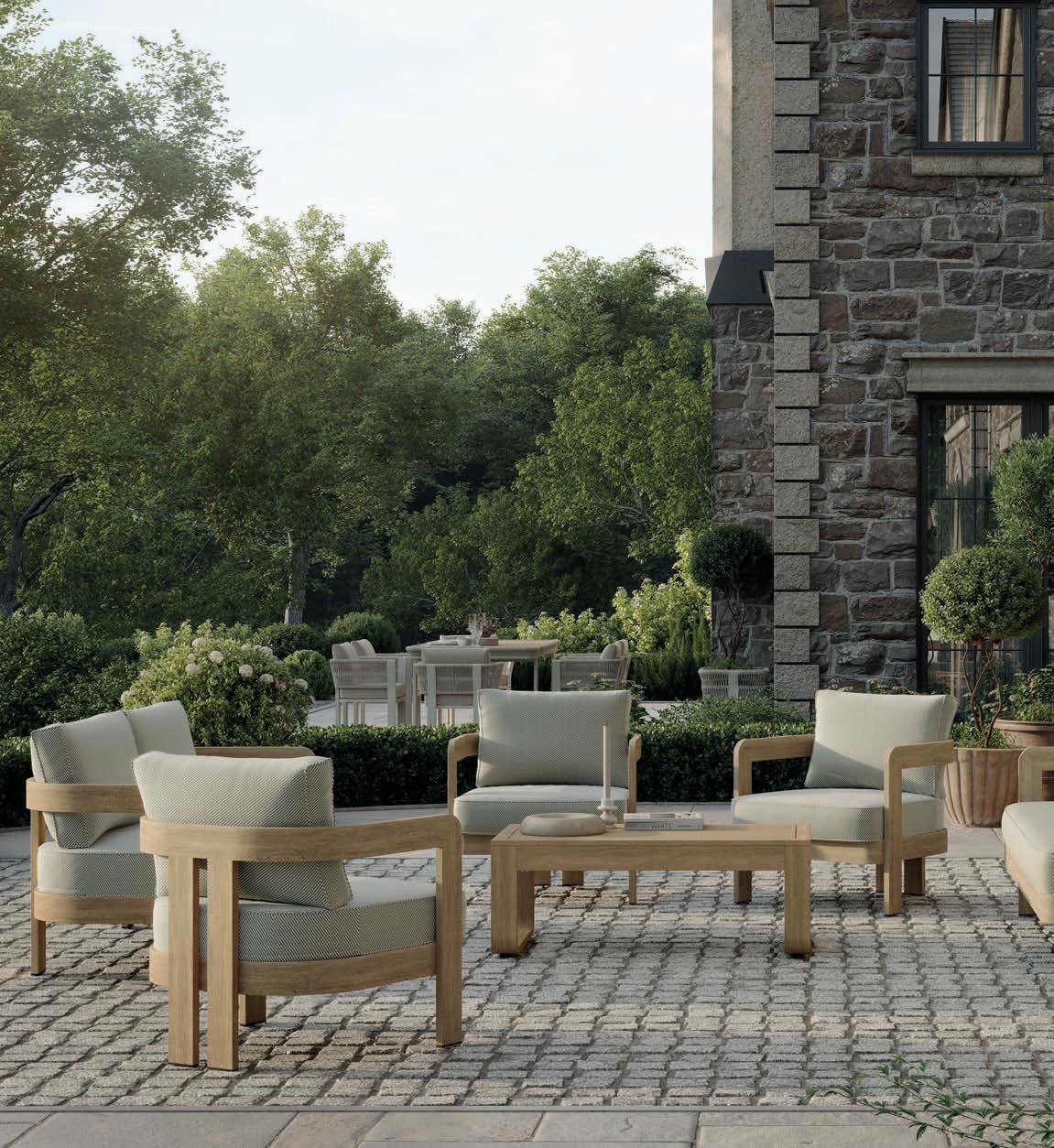



WINNER: SUSTAINABLE PRODUCT OF THE YEAR (HARD LANDSCAPING) – ROOTSPACE GENERATION 2 – GREENBLUE URBAN LTD

WINNER: DOMESTIC DESIGN PROJECT – CLIMATE POSITIVE GARDEN, PAISLEY – RACHEL BAILEY GARDEN DESIGN LTD

WINNER: LANDSCAPE ARCHITECTURE STUDIO – HTA DESIGN LLP

WINNER: LANDSCAPING COMPANY –GRADUATE LANDSCAPES LTD

WINNER: MAINTENANCE CONTRACT –CHINEHAM PARK – NURTURE LANDSCAPES LTD

WINNER: SUSTAINABLE PRODUCT OF THE YEAR (SOFT LANDSCAPING) – CARBON4GRASS RANGE –ORIGIN AMENITY SOLUTIONS

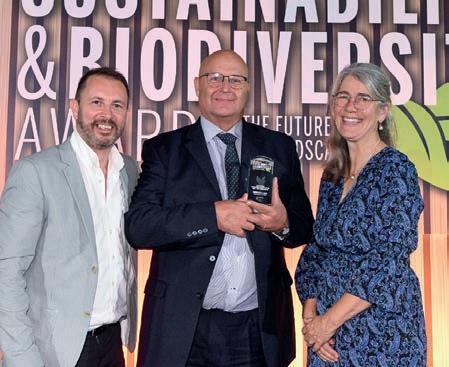
WINNER: COMMERCIAL DESIGN PROJECT – TEMPORARY INSTALLATION – ‘THE FREEDOM FROM TORTURE GARDEN: A SANCTUARY FOR SURVIVORS’ IN COLLABORATION WITH SENSELESS ACTS OF BEAUTY – EMMA O’CONNELL GARDEN DESIGN



WINNER: SUSTAINABILITY AND BIODIVERSITY
LEADER – KAY GEOGHEGAN –TYLER GRANGE GROUP LTD

WINNER: GROUNDS MAINTENANCE COMPANY – NURTURE LANDSCAPES LTD


WINNER: SUPPLIER – HILLIER NURSERIES LTD
WINNER: COMMERCIAL DESIGN PROJECT – ATELIER GARDENS, BERLIN – HARRIS BUGG STUDIO
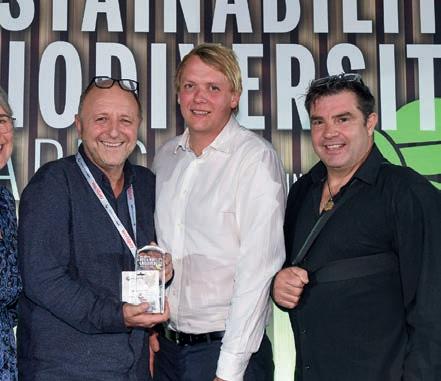
WINNER: GARDEN DESIGN COMPANY –RACHEL BAILEY GARDEN DESIGN LTD

DOMESTIC DESIGN PROJECT
IN PARTNERSHIP WITH NURTURE GROUP CLIMATE POSITIVE GARDEN PAISLEY – RACHEL BAILEY GARDEN DESIGN LTD
COMMERCIAL BUILD PROJECT
IN PARTNERSHIP WITH APEX SOIL SOLUTIONS
KNEPP WILDING ‘DOG WALKERS CAR PARK’ & KITCHEN – GRADUATE LANDSCAPES LTD
COMMERCIAL DESIGN PROJECT –
TEMPORARY INSTALLATION
IN PARTNERSHIP WITH BOOM & BONHEUR ‘THE FREEDOM FROM TORTURE GARDEN: A SANCTUARY FOR SURVIVORS’ IN COLLABORATION WITH SENSELESS ACTS OF BEAUTY –EMMA O’CONNELL GARDEN DESIGN
COMMERCIAL DESIGN PROJECT
IN PARTNERSHIP WITH PHOENIX AMENITY SUPPLIES ATELIER GARDENS, BERLIN – HARRIS BUGG STUDIO
MAINTENANCE CONTRACT
IN PARTNERSHIP WITH PROGREEN CHINEHAM PARK – NURTURE LANDSCAPES LTD
SUPPLIER


WINNER: COMMERCIAL BUILD PROJECT: KNEPP WILDING ‘DOG WALKERS CAR PARK’ & KITCHEN – GRADUATE LANDSCAPES LTD


IN PARTNERSHIP WITH TYLER GRANGE LTD HILLIER NURSERIES LTD
LANDSCAPE ARCHITECTURE STUDIO
IN PARTNERSHIP WITH GREENBLUE URBAN LTD HTA DESIGN LLP
GARDEN DESIGN COMPANY
IN PARTNERSHIP WITH BSW TIMBER RACHEL BAILEY GARDEN DESIGN LTD
GROUNDS MAINTENANCE COMPANY
IN PARTNERSHIP WITH EGO POWER PLUS NURTURE LANDSCAPES LTD
LANDSCAPING COMPANY
IN PARTNERSHIP WITH HILLIER NURSERIES LTD GRADUATE LANDSCAPES LTD
SUSTAINABLE PRODUCT OF THE YEAR ( HARD LAND SCAPING ) IN PARTNERSHIP WITH ADTRAK ROOTSPACE GENERATION 2 – GREENBLUE URBAN LTD
SUSTAINABLE PRODUCT OF THE YEAR ( S OFT LANDSCAPING ) IN PARTNERSHIP WITH GREENBELT GROUP CARBON4GRASS RANGE – ORIGIN AMENITY SOLUTIONS
SUSTAINABILITY AND BIODIVERSITY LEADER IN PARTNERSHIP WITH ENCLEAN BY CERTIS BELCHIM AMENITY KAY GEOGHEGAN – TYLER GRANGE GROUP LTD


Running a successful landscaping business means you already understand the value of hard work and delivering great customer service. However, to take your business to the next level, it is vital to focus on one key area: your numbers. Specifically, understanding your business expenses can help you reduce your tax bill, reinvest smartly, and grow even further. Here are some practical tips to help make your business expenses work for you.
Track every expense accurately Every pound you spend on your business should be accounted for. This includes everything from equipment, fuel, and materials to office supplies, marketing, and even business meals. Keeping track of these expenses ensures you do not miss out on tax deductions, and it gives you a clear overview of where your money is going. Using accounting software to record and categorise your expenses will reduce the time you spend organising your expenses and help you understand how profitable your business is.
Think outside the box
There may be business expenses you are not yet taking advantage of
Business expenses are not just costs; they can be opportunities to reinvest in your business’ growth. Whether you are upgrading equipment or investing in new technology, these expenses are not only tax deductible but can also increase your efficiency and profitability. Consult with your accountant on the timing of large purchases. Making strategic investments toward the end of the tax year (providing the business is making a profit) could result in an immediate deduction while setting your business up for growth in the coming year.
There may be business expenses you are not yet taking advantage of. Have you come across Trivial Benefits or Relevant Life Insurance? If not, it is worth discussing these with your accountant or downloading our free guide on Limited Company Expenses. This guide covers allowable expenses which qualify for tax deductions, including some lesser-known options that could benefit your business.
If you are managing part of your business from home, the home office deduction can be a valuable way to reduce taxes. This applies to a portion of your rent, mortgage interest, utilities, and other home-related expenses, provided that you use a specific area of your home exclusively for business purposes.
While managing your expenses yourself is possible, hiring an accountant who understands the landscaping industry can be a game changer. A professional can help you identify all
available deductions, structure your finances efficiently, and advise you on tax-saving strategies specific to your business. A specialist accountant can also help you plan for the future by providing financial forecasts and offering advice on how to reinvest profits back into your business for long-term growth.
Understanding and managing your business expenses effectively is a critical step in taking your landscaping business to the next level. By maximising your deductions, keeping clear financial records, and reinvesting strategically, you can use your expenses to fuel your growth while reducing your tax burden. Make sure your expenses are working for you, and you will see the benefits in both your bottom line and the long-term success of your business.

Kim photograph ©Sarah Cockerton Free Limited Company Expenses Guide QR Code:
Sones, owner of
Accountancy Services Ltd, specialises in bookkeeping and accountancy for the landscape gardening industry. She is passionate about helping business owners to ‘know their numbers’ and use their knowledge to set goals to aid growth and make good financial decisions for their business. Instagram: @kimsonesaccounts Email: kim@sonesacccountancy.co.uk sonesaccountancy.co.uk


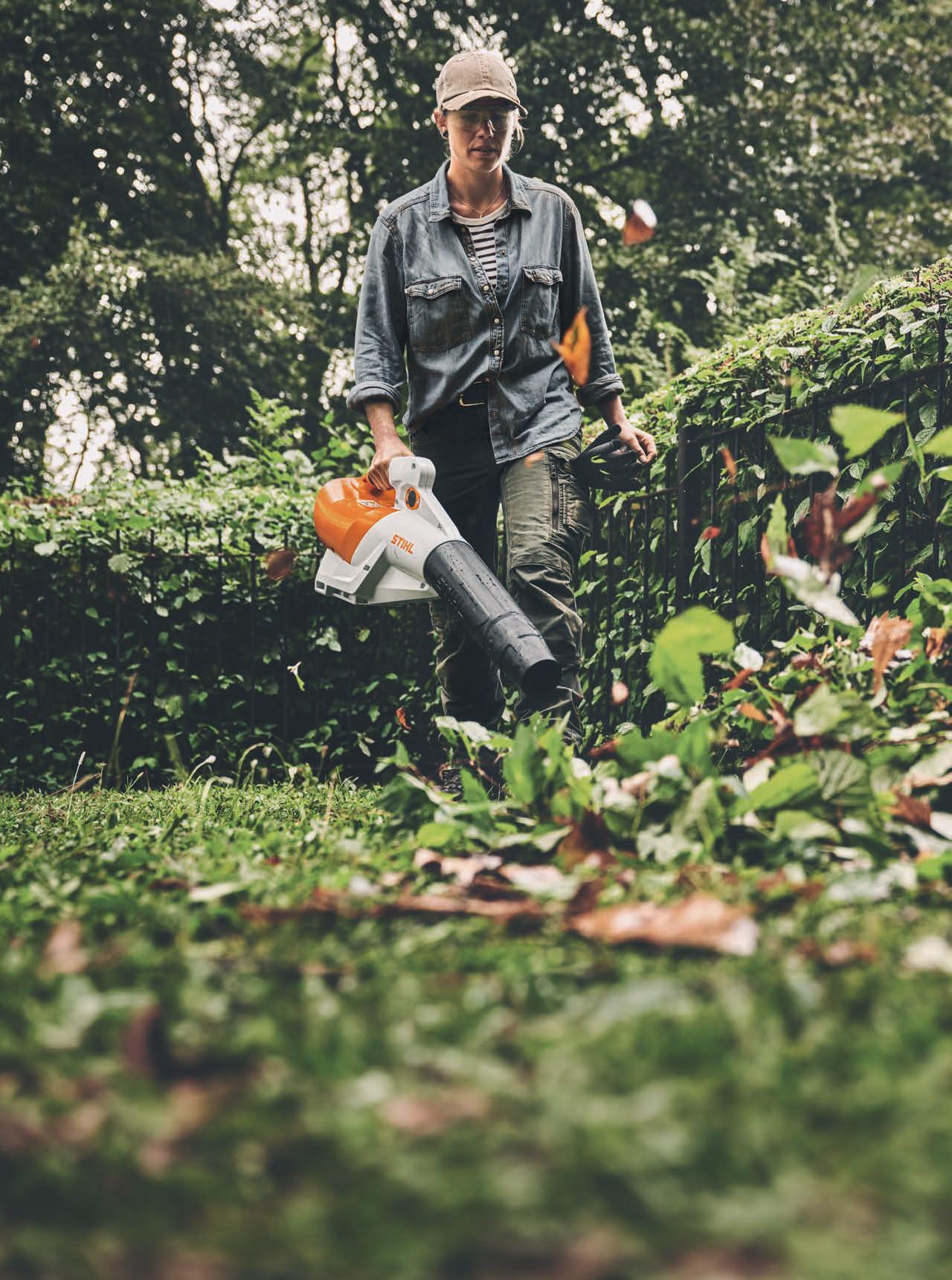
Experience unprecedented performance with STIHL‘s extensive range of professional grade battery-powered tools for commercial users.
IPX4 certification lets you continue working with confidence in the rain. Long-lasting smart batteries deliver consistent power throughout the whole battery charge. And fast chargers deliver quick recharge times so you and your tools are always ready for the job.


When the assets of business or part of a business are transferred to a third party, both the employer and employees face important questions about the future of their contracts and terms of employment. Understanding how employment contracts are impacted is crucial for ensuring a smooth transition. Compliance with the relevant legal regulations are also key to ensuring employers do not breach their legal obligations and avoid claims, such as unfair dismissal.
The Transfer of Undertakings (Protection of Employment)
Regulations 2006, commonly referred to as TUPE, play a central role during this process. TUPE is there to protect employees' rights and ensure that their existing contracts remain in place after the move to the new employer.
What happens to existing employment contracts when a business changes hands, explains Oracle Solicitors’ Kai Sammer
individual’s detriment. Employees are not required to sign new contracts just because of the move, and the new employer inherits all existing contracts of employment. New contracts or updated terms can be offered later, provided the proper legal procedures are followed.
Self-employed individuals are generally not protected under TUPE; however, it is important to ensure that they are not “disguised employees” – that is to say contractors who, for all intents and purposes, fulfil the same roles as permanent employees and don’t have the same freedoms as genuine contractors, despite the label of “contractor.”
If the new owner offers a new contract or updated terms, employees have the right to review and negotiate these terms
When a company is acquired via transfer of shares, the existing employment contracts of the employees remain in place. When a business is transferred via a sale of its assets, the contracts of the employees working in that business are transferred to the new owner. This means that the terms, including salary, job role, and working conditions must remain unchanged and cannot be varied according to the
If changes to employees’ roles, salaries, or other terms after the acquisition are planned, these changes must be justified and comply with the TUPE regulations. Any alterations that negatively impact employees need to be carefully managed and communicated to avoid potential disputes.
If the new owner offers a new contract or updated terms, employees have the right to review and negotiate these terms. If the reason for any variation of contract is the transfer itself, this will generally be void under TUPE and may also be excluded from a settlement agreement in certain circumstances.
In Solectron Scotland Ltd v Roper (2004), the employees, who originally worked for BT, were transferred to Solectron. They were eventually made redundant on Solectron's redundancy terms. The employees were successful in claiming that BT's more favourable redundancy terms applied and had not been validly varied.
It's crucial to ensure that any business complies with TUPE regulations during the relevant transfer and communicates effectively with employees. Navigating an acquisition involves careful consideration from both sides. By understanding the key aspects of TUPE and maintaining open communication, both employers and employees can manage the transition effectively and minimise disruptions.
With it looking likely that Labour’s plans for a new Employment Rights Bill will include laws to “strengthen the existing set of rights and protections for workers subject to TUPE processes,” it is more important than ever that employers stay abreast of any developments in this rapidly changing employment landscape.

Oracle Solicitors is an award-winning law firm with a deep understanding of the landscape industry and expertise in employment, commercial, litigation, property and contract law. Oracle Solicitors, founded in 2002 has since grown to include offices in London, Belfast, Naples, Frankfurt, and Tirana, please visit: oraclesolicitors.co.uk
Gareth Wilson shares his experience of designers supplying materials and the associated issues
Many moons ago, I was involved in a project where the clients insisted on providing the materials. Agreeing to this was a big mistake. Despite my dad warning me of the implications, I was young, ginger-haired, headstrong, and ever so slightly stupid at the time, so I ignored him. My dad is now 80, and he still likes to remind me of that mistake 30-odd years later, along with other stories in his repertoire.
Recently, I stumbled across a similar situation where a contractor allowed the designer to purchase the materials. Needless to say, it brought back bad memories and reminded me of similar issues I and others have encountered.
stay busy and earn money. This fragments the project into a stop-start cycle, causing issues for everyone involved, especially if there are deadlines.
As a contractor, you're also missing out on profit margins from materials sourced through your suppliers
The big issue is that, as a contractor, you’re not in control. For example, you're relying on a third party to deliver materials on time – which is crucial, especially if your team is standing around with nothing to do. This costs you time and money. You also can’t be expected to wait around, which often leads to starting other projects just to
In the case of clients, they often opt for cheaper products, which can come back to bite you later. Cheaper products tend to lack longevity and often have quality issues. Relying on a third party to order the correct amount of materials and ensure that batch numbers match can always lead to problems. Having to leave the site to pick up materials costs time and money, and unless you document everything meticulously, it can lead to disputes at the end of the project when handing in your final invoice.
When it comes to planting schemes, plants purchased by a third party may not be suitable for the soil type or aspect. Clients and some designers often overlook these factors, leading to plants that don’t flourish or simply don’t last.
Supplier reliability and customer care can also be a problem if issues with the
products arise later. As I’ve discussed in previous articles, this can lead to all sorts of cost-related problems.
As a contractor, you're also missing out on profit margins from materials sourced through your suppliers.
The takeaway from this is – do not let clients or dubious designers dictate or control the purchase of materials, as this effectively takes over the running of your project. It often leads to failure and needless stress. The Society of Garden Designers (SGD) does not allow these practices for good reasons, and quite rightly so.

Leaving college at 17, Gareth has worked in the landscape industry since 1989. Progressing onto high-end projects, he has picked up seven RHS gold medals. He is a member of multiple professional bodies. He provides technical and product advice to large companies, mentors and trains contractors and garden designers in landscape construction and on show gardens logistics across the UK. Gareth also provides mediation services, he is a member of the BS7533:102 committee and is an industry awards judge.
gkwilsonlandscaping.co.uk
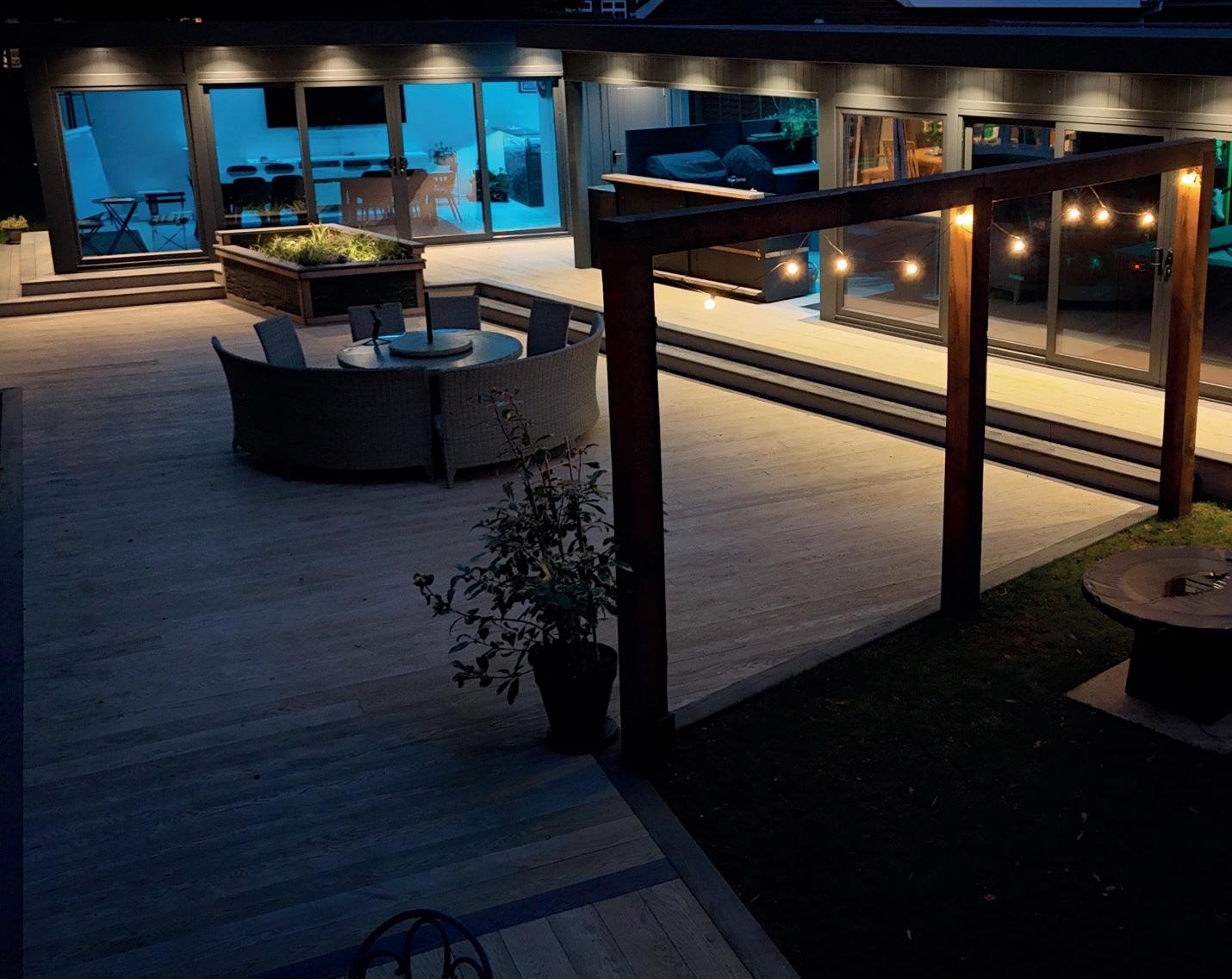

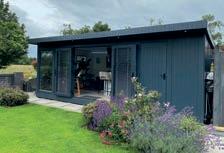
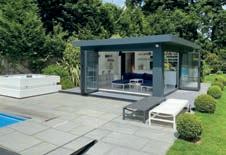


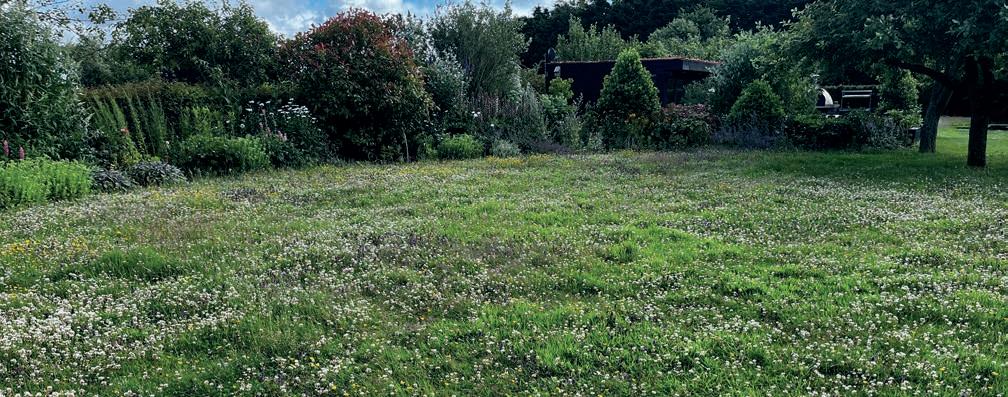
rassland’s latest wildflower product, Floral Lawn, is a pragmatic response to a problem commercial landscapers were coming to us with. They explained how the Species Rich Turf (SRT) being installed on front gardens and public spaces on new home development sites is garnering a high volume of critical feedback. In short, the house purchasers were asking for it to be replaced with “proper grass”.
SRT specification was an unintended consequence of developers trying to do the right thing and be environmentally responsible. Our landscapers were asking for a functional lawn but with an improved ability to contribute towards Biodiversity Net Gain (BNG) requirements.
Frank

managing director, has spent at least 30 years of his life trying to eliminate “weeds” from turf, and here am I trying to convince him of the benefits of getting as many “weeds” as possible back into turf.
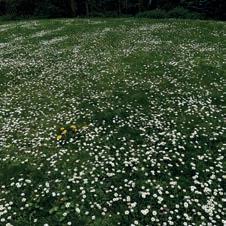
We collaborated with the incredible team at John Chambers Wildflower Seed – who were already aware of the push back against SRT – to design a product that looks like conventional turf but benefits a whole host of pollinating species by using low growing wild- flowers among the grasses.
Now, at this stage you have to understand that Simon, our
Somehow I managed to keep my job and we moved into research mode! So, three years ago, Simon and I started looking around at what was in the market place and if we could be resellers of someone’s wildflower products and use our efficient distribution fleet to get it out to our landscapers at a sensible cost. We found conventional production techniques to be incredibly
labour intensive and that huge amounts of plastic were being employed to produce the turf.
Generally, the growing medium was manually spread onto the single use plastic layer then seeded and irrigated at great cost throughout the main growing season. To harvest their crop, one producer had labourers cutting turf into slabs using a long string line as a guide, the resulting heavy slabs were then manhandled and stacked onto pallets! We were stunned, but quickly understood why the producers
had to charge so much for their product. We knew that somehow the whole process needed to be, and probably could be, automated to drive down costs.
We considered direct drilling various seed mixes into the soil and then harvesting and stacking the turf mechanically. This thought process lasted about five minutes before it dawned on us that the reason nobody was doing it was because it would be nigh on impossible to eliminate or control the unwanted species. After much thought, we arrived at the idea of using our turf as a carrier medium for the wildflowers in the mix. This has proved to be the game changer needed.
A lawn like wildflower solution has real potential in the marketplace and can drive BNG in a positive direction
We are now working with ecologists to establish that our mix can contribute to a positive BNG, but we are also looking to add in a few more super low growing wildflower species. We are convinced that a lawn like wildflower solution has real potential in the marketplace and can drive BNG in a positive direction. grasslands-turf.co.uk

Finding the perfect balance between aesthetics and functionality is crucial in lawn selection ...
Grasslands’ Floral Lawn® is a unique blend of charming wildflowers and non-agressive grasses that offers an unparalleled solution for creating captivating spaces that are both visually stunning and environmentally responsible.
Our carefully curated mix blooms with buttercups, daisies, low-growing clover and trefoil, creating a vibrant, pollinator-friendly lawn. Designed for reduced maintenance, it requires cutting only every 2-3 weeks, making it ideal for ‘No Mow May’ and beyond. This mix delivers a beautiful, family-friendly lawn that thrives in standard soil conditions.
Combining natural beauty with practical durability, Grasslands’ Floral Lawn® is the perfect choice for those seeking a refined, low-maintenance option that adds an effortless charm to any project.
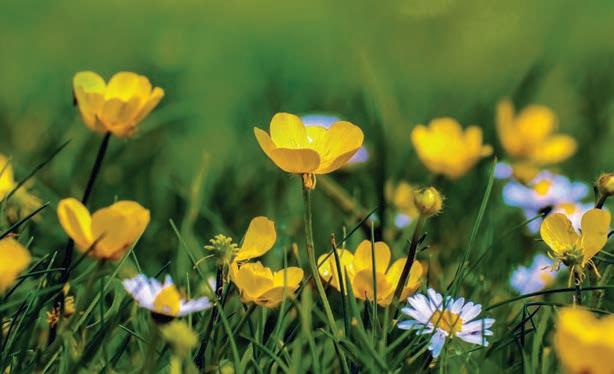

A highly desirable, naturalistic mix of buttercups, daisies and low-growing wildflowers.
Supports biodiversity by attracting pollinators, with no need for pesticides, weedkiller or fertilisers.
and Low Maintenance
The requirement to mow is far less frequent than conventional lawns. It’s perfect for ‘No Mow May’ and year-round beauty.
Resilient and Family-Friendly
Capable of withstanding family activities without compromising its visual appeal.
Ranunculus bulbosus
Lotus corniculatus
Vicia sativa
Bellis perennis
Ranunculus acris
Trifolium pratense
Prunella vulgaris
Trifolium repens
Introductory trade offer of £5.50/m2 + Delivery + VAT
Grasslands Turf Farm, Ashford Road, Romney Marsh, Kent TN28 8TH T: 01797 367130 E: orders@grasslands-turf.co.uk W: www.grasslands-turf.co.uk
Ten years ago, Green Genie’s business model might not have been possible. But for the last four years, brothers Ethan and Jake Thorne have been using social media as a catalyst to draw in bigger and bigger clients – and it’s working. Last year, they built a water fountain for grime artist Bugzy Malone, earning them a mention in one of the Mancunian’s songs as well as in his Instagram stories.
That’s just the start. This year, they released a design on their Instagram feed for a football pitch garden – we’ll leave you to speculate who the mystery client could be – and there’s another celebrity client in the pipeline that could propel them forward even further.
The duo’s following has skyrocketed since they started in 2020; they now have more than one million followers on Instagram. In one month alone this year, they gained 250,000. “It proves the snowball effect; when you start, you think you can’t do it – but you can,” says Ethan. “At one time, 10,000 was our biggest achievement – and that almost felt better than hitting one million because of how much work we put into that.”
1 Night view of a client's new serene garden retreat
2 Tiki bar and chill out area in client's back garden project
Green Genie has more than one million Instagram followers – and there’s plenty more room for growth, says the brothers behind it

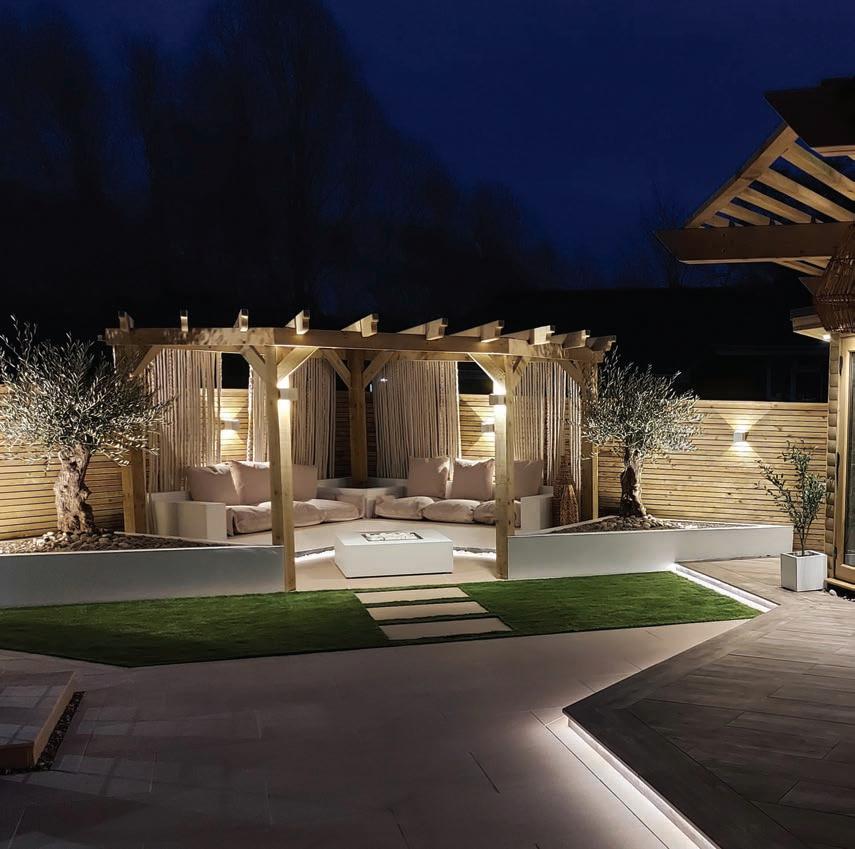
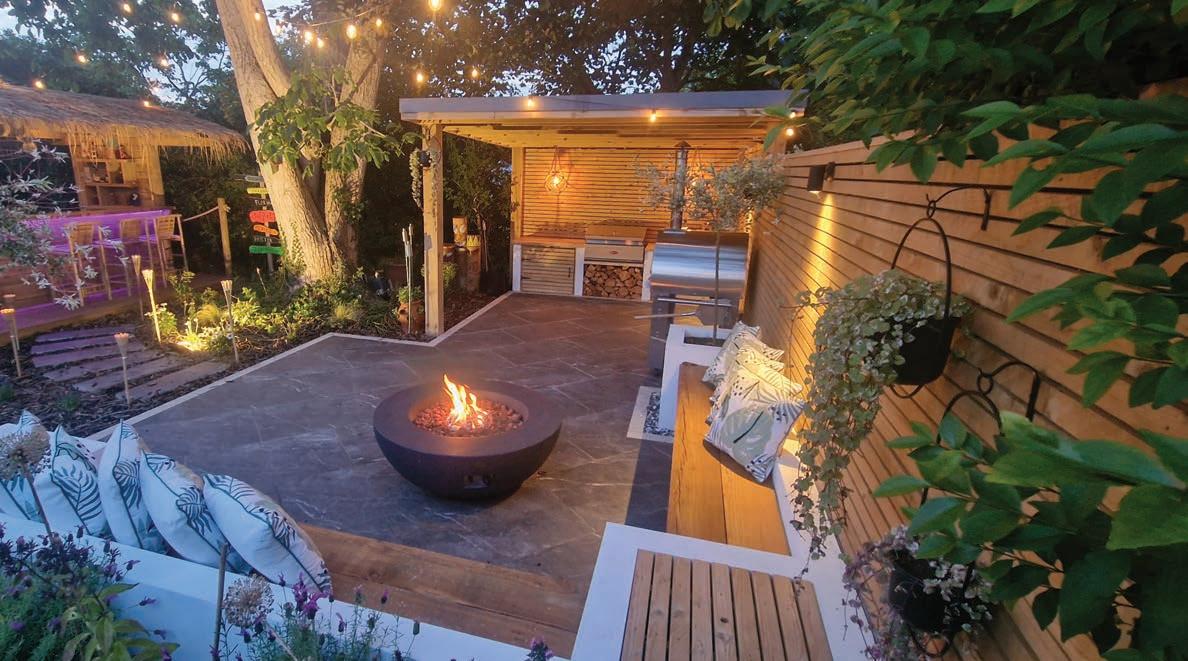
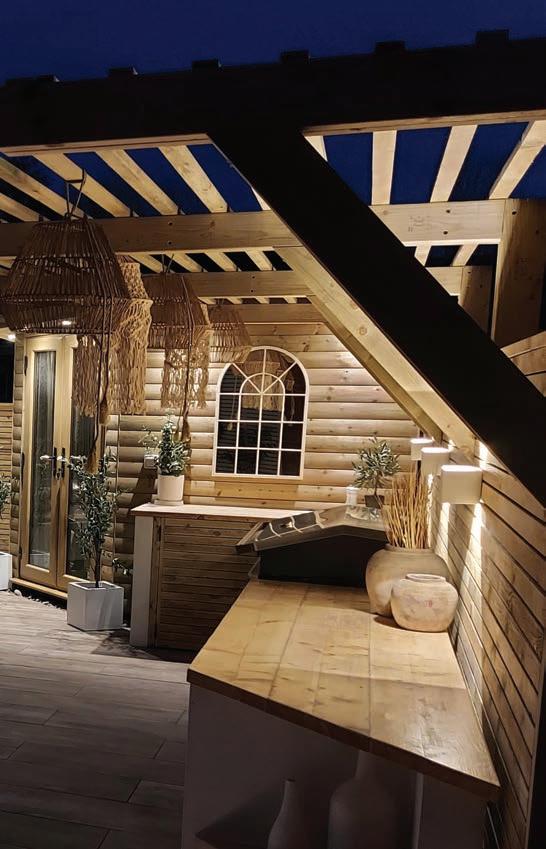

It’s not been easy, though. “When we first started getting into it, I’d be on my phone from six o’clock at night until one in the morning, and that was relentless for about two years.” That’s on top of building gardens during the day and his brother Jake designing gardens in the evening.
“People don’t see the hard graft; four years is a short time to get to where we are now with our social media presence,” says Jake. “But we’ve also got around 20 years each of landscaping behind us. The social media is the byproduct, which is growing quicker than we ever imagined. We just love showing people what we do.”
Social media is arguably not just helping Green Genie to flourish – it could have a wider impact on the industry too.“Social media has changed landscaping completely. People are seeing what landscapers do day to day; it’s allowed a bit more transparency,” says Jake. And its reach could help to attract the next generation.
“Over the week that Chelsea is televised, they have something like three million viewers. During Chelsea week this year, we hit seven million on one platform. Chelsea has been the pinnacle of design for years now, but the average age of viewers is probably 55, whereas ours are mostly between 25 and 35.
“We can fully appreciate that Chelsea is the epitome of what a garden is; and for people who want to be there, it’s amazing. But we’re going down a different route.”
May was also the month they gained a quarter of a million followers, with 26 million views across the month on Instagram, and Facebook and TikTok weren’t far behind.
“Social media has a different power to the pinnacle of the gardening world. We can inspire people on a different scale. They might choose to come into the industry our way – and then they might choose to go down the Chelsea route. Hopefully one thing we can push on social media is that landscapers are extremely skilled and underrated. I reckon it’s the hardest trade; you have to be multi-skilled.”
become a social media star’ because I don’t think that’s what we are. We’re landscapers with a massive following, which means we have a responsibility to show people how to do things the right way – but our way,” says Jake.
Social media has changed landscaping completely. People are seeing what landscapers do day to day; it’s allowed a bit more transparency
And their way certainly breaks the mould. Ethan – who runs the social media accounts, whilst Jake creates the designs – had no experience in marketing beforehand.“It wasn’t part of the business plan; it was just what we’d always done – take photos at the end of the job to put in a folder for the website.” But he started to enjoy it as well as realised its potential.“We knew we could do it – let’s show the world what we can do, to a wider audience.”
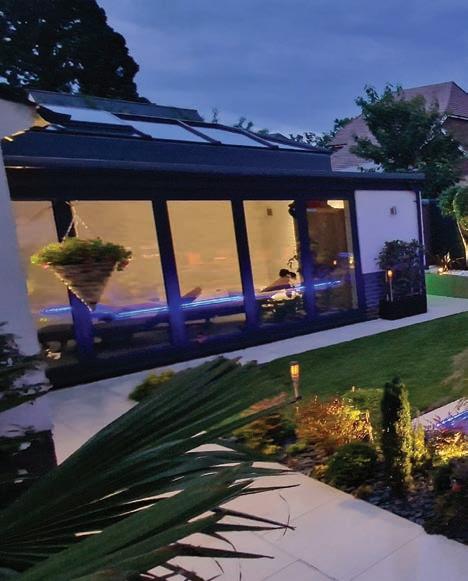
Those who choose to become ‘influencers’ as well will likely be growing their skillset at the same time, learning to film and run a social media account. Jake and Ethan aren’t quite ready to be called ‘influencers’, though – they're not fans of the word. That’s despite receiving messages from landscapers – some as far as Orange County in California – on a daily basis asking them to check out their work which has been inspired by Green Genie’s style.
“We don’t go around with an influencer flag. I’m not going to say ‘this is how you
He started taking photos of different stages of their projects, tagging local suppliers, which started to gain traction.“It's crazy. If I’d known then what I know now, even in the four or five years up to when I started, it would all be totally different again. But I suppose that's the whole point of the learning process.”
All Green Genie’s leads now come through its

social media – it doesn’t advertise locally or have branded vans. Its marketing is purely online –and that’s a key focus for the brothers. All the company’s projects are “steppingstones” to be able to work on their “masterpiece”. They see themselves more as artists than businessmen.

“Artists are not really driven by the money side; they’re driven by their passion for the art. And before you know it, someone like Banksy is spray painting walls around your area which are worth thousands – so, it’ll come if your reputation is that high anyway,” says Jake.“We’re not trying to blow people away with stupidly high costs; we’re trying to build the garden and everything else has come with that. The better the gardens, the better the finances – it has helped the business to grow.”
“Some jobs have made a profit; others have made a loss – but we always want them to do well on social media and for our portfolio,” says Ethan.
Bugzy Malone was arguably a gamechanger for the brothers. They’d reached out to him on Instagram and he eventually gave them the green light to work on his garden. He’d been partly won over by Ethan’s song choices for videos on their feed. Some landscaping companies might steer clear of using Wiz Khalifa and 50 Cent, but it’s paid off for Green Genie.
They’ve worked for other celebrities too, but Bugzy Malone allowed them to post about it, as well as posting about their work himself. It might have been on his terms, with them holding off sharing the finished project until his

latest album had been released, but it “blew up” their page even further.
Their ultra contemporary style is drawing in those looking for “really modern, low maintenance and clean cut” gardens.“But our interpretation of modern – we're still trying to build gardens the way we want to build them,” says Jake.
They’ve had to learn new skills along the way to bring these schemes to life, from lighting designs to laying porcelain paving. But the feedback from clients and followers shows it’s been worth the effort, and their order book is full for next year – though they’re trying to keep space in the diary for big projects that might come up. “We had to change our business plan so that we don’t book up back-to-back anymore,” says Jake.
“We had an old little red Ford Escort van and only one door opened – and sometimes you had to park it on a hill because you had to push it,” says Jake.
Every door that opens is bigger than we ever dreamt. I’m more than 20 years into my job and it feels like we’re just starting
But they gradually started to pick up their work and began to build a business – one with an arguably more traditional model, with teams and branded vans for Thorne Landscapes. Pricing proved difficult, though. “We were two young lads just starting out and there’s no rulebook.”
Their strength was their work ethic – “We’d work until nine o’clock every night, and Saturday and Sunday, and just accept that it is what it is and move on from there. We get up and we graft.” It earned them a reputation and they started winning more work – but they were

“overdelivering”. They decided to take a break, contracting full time for around 18 months. “Contracting is good, but everyone else gets the credit. We built two gardens that won awards, and we were never credited; no-one even knew we were there. We’d seen the designer once before the build and we’d never seen the lead contractor. So, when we were building a wall one day, I turned to Ethan and said,‘Come on, we’ve got to get back to it, what are we going to call ourselves?’ And he looked at me and said, ‘What about Green Genie?’”
Now, it’s just the two of them, and that’s the way they like it. They work well as a duo – they even lived together until last year and have run football teams together.“We’ve been in each other’s pockets our whole lives,” says Jake.
3 Stunning features with a playful touch
4 Colourful planting leading to seating area
5 Corner retreat for day and night use
6 Luxurious multi-purpose space
The brothers have come a long way from not being able to open a tin of paint at a weekend job as teenagers. As soon as Jake finished school, he started landscaping for his uncle – and believe it or not, he hated it. “I was so tired all the time, it was so physical.” That didn’t put Ethan off joining him the following year.
Their uncle’s business served as the “perfect blueprint” – “clean your vans and your tools, do everything the right way, lay proper bases." But the brothers were looking for more creative projects with a design element to them. So, they set out on their own, contracting for other firms.
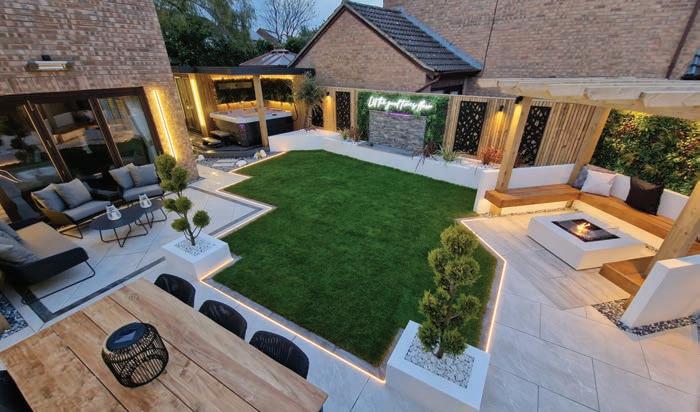
Our ambition is to build the best gardens we possibly can
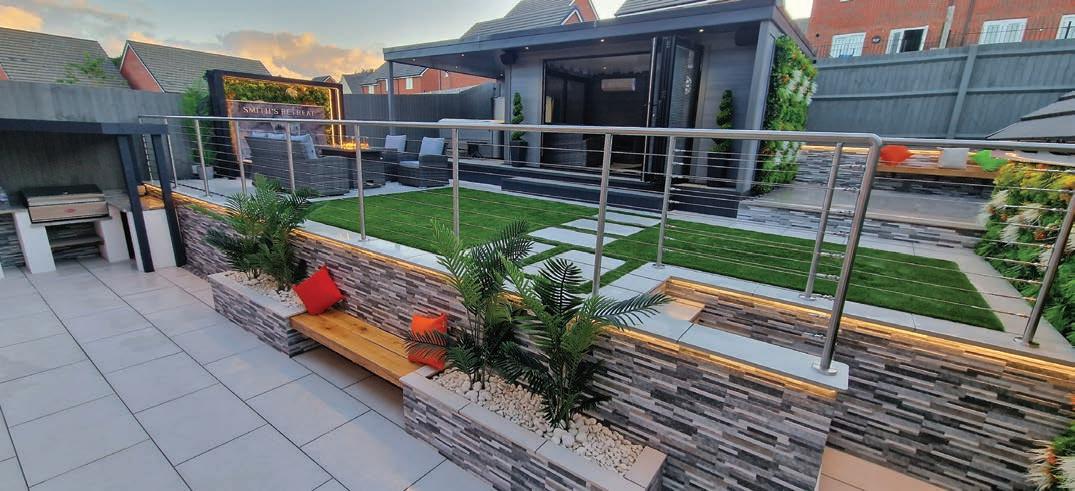
But they’re constantly being told that they need to hire more people.“And we know that, because we go home with bad ankles and bad backs, because we’ve dug every hole and laid every brick.”
“Then you’ll be designing at night, and I’ll be doing the social media,” adds Ethan. On top of that, Jake recently welcomed a newborn to the family with his partner.
“But we’re going to keep going, because we’ve already achieved so much more than we thought in a faster time,” says Jake.“We already
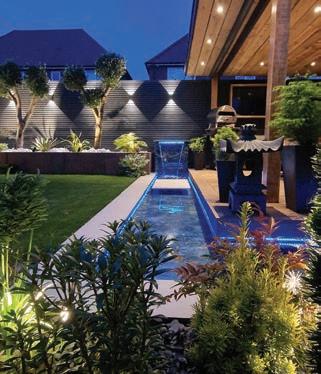
can’t believe where we are. Every door that opens is bigger than we ever dreamt. I’m more than 20 years into my job and it feels like we’re just starting – only that my body’s in pieces this time! But we’re going to go for it now and see what we can do.”
“It comes back to us saying that we want to be like artists,” says Ethan.“Clients are paying for two lads to custom build their garden from start to finish, just me and Jake. We’ll take them
the whole way through the process, from the design to jet washing the patio when we have finished.”
Social media has allowed them to up their day rates as well because demand is so high, and rather than the “hard sell” that they were used to under Thorne Landscapes, their clients are more trusting having seen what they can accomplish.“A big percentage of them actually send a budget and what they want before we even have a conversation,” says Jake.
They’re now looking to almost double their following to hit the two million mark on Instagram, as well as boost their following on TikTok and YouTube. Videos for the latter are filmed in landscape rather than portrait, though, so they’ll have to film twice and editing time will potentially double to post as often on this platform. But they’re determined to do it.
“We’re realising that we can give back to followers on our YouTube channel too by having how-to videos. We’re going to change how I talk to the camera and try to go through a full walk through,” says Jake.
But ultimately, this is just a means to an end. As they say, the Green Genie brothers are landscapers, and their social media helps them to win dream clients and build the gardens they want to build.“Our ambition is to build the best gardens we possibly can,” says Ethan. “We can get better work
because of social media; whereas before, if we didn’t have social media, we would have found it difficult without a designer on board or without contracting to get to that level. Now, we can be braver and bolder with our designs, and we can keep growing as a landscaping firm and do the work that we’re becoming known for. Our goal is to get the dream job to show everyone what we can really do,” says Jake.
There’s a project next year that they say will really showcase their skills.“People will start to see what we’re fully capable of, on a scale that most would say two lads wouldn’t even dream of going for.”
Whether it’s growing their following or building gardens, one thing is for certain –they’ll do it their way, and they’re only just getting started.
7 Outdoor entertainment area
8 Waterfall and lights adding atmosphere
9 Creative lighting and firetable for evening use

shop.uk.q-railing.com
shop.uk.q-railing.com
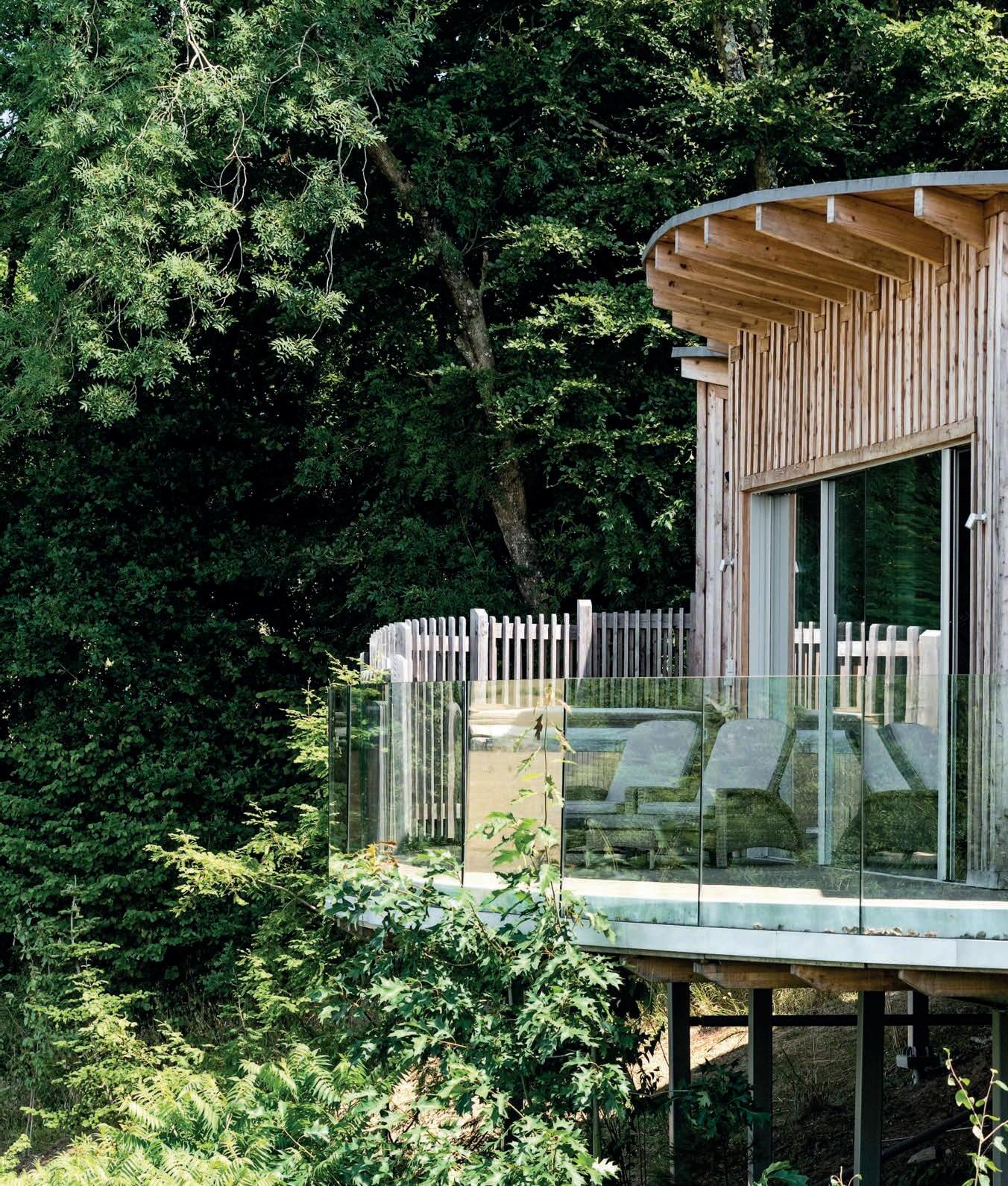
shop.uk.q-railing.com
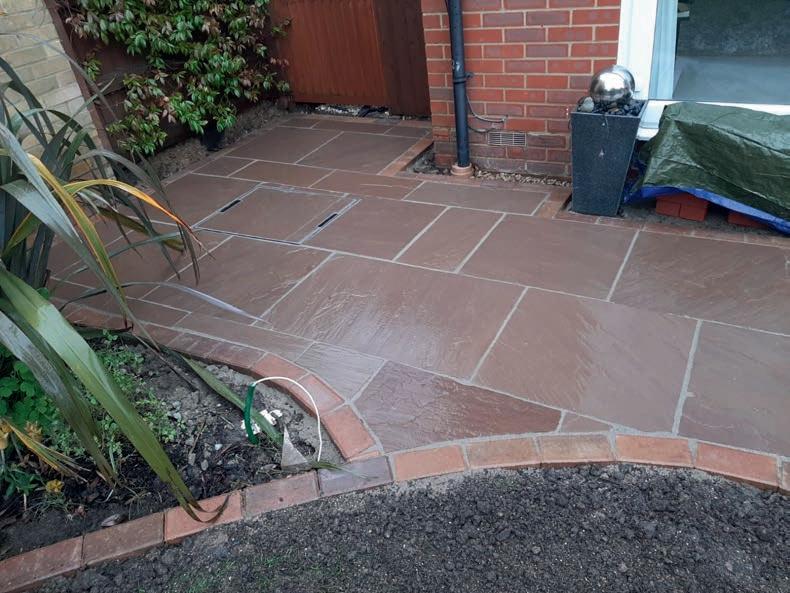
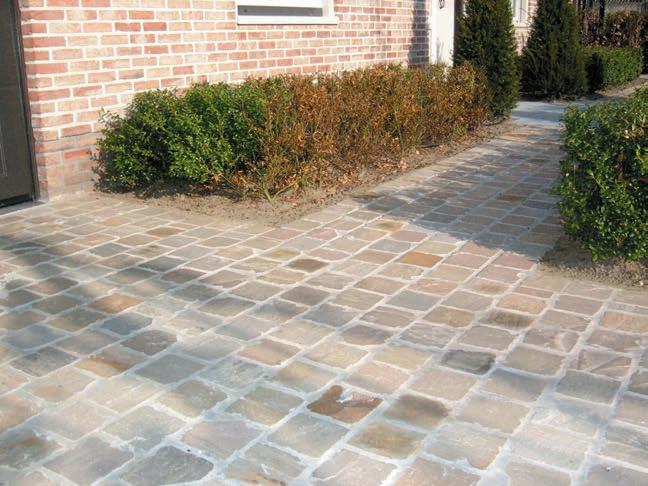
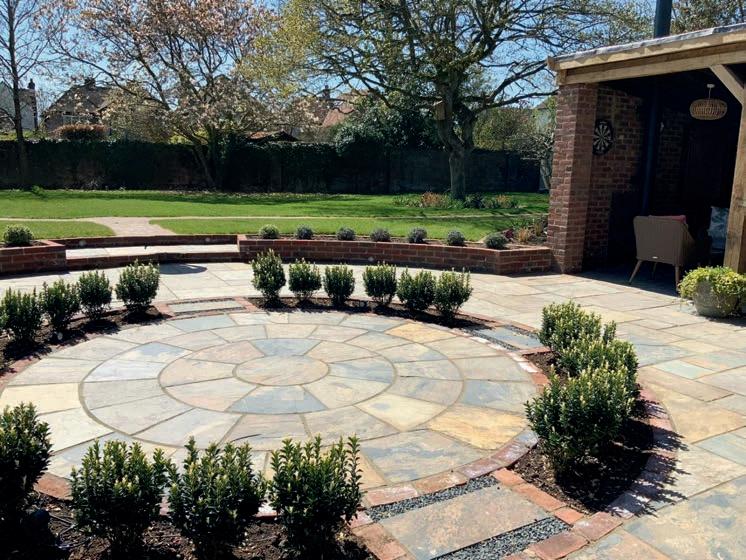


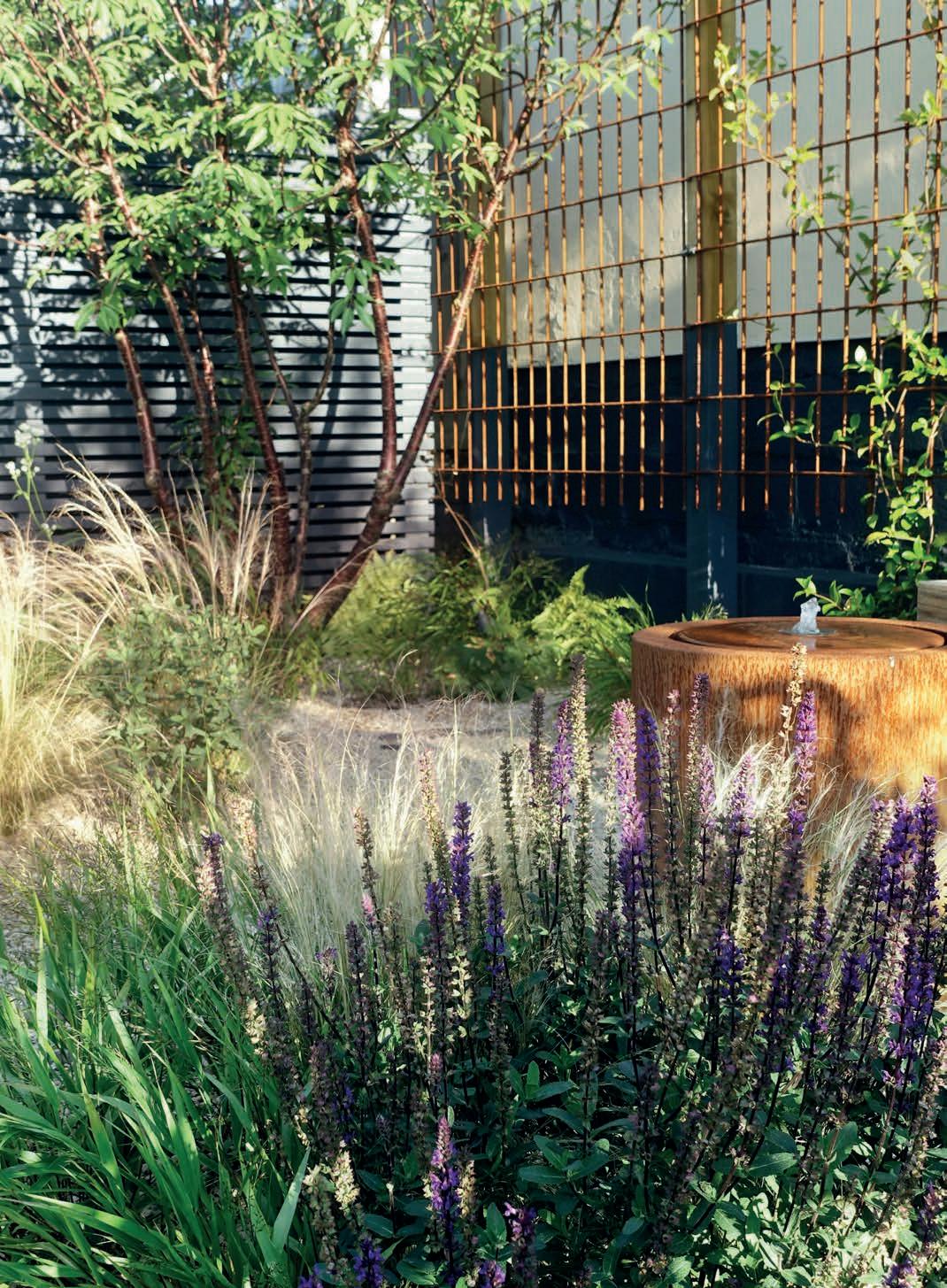
Rigden Studio Ltd was asked to create a tranquil garden for use during daytime and at dusk – a space to retreat to for a coffee when working from home, a space to host small gatherings of friends in the evening, and daytime barbecues at weekends. The client wanted the garden to function as an extension of the house during the summer months, with various dining and seating options that benefitted from the sun in early morning through to early evening.
The surrounding walls needed to be disguised, so that the space feels greener and less oppressive, less like it’s squeezed between two buildings, especially as the garage wall was on one side and the neighbouring house on the other.
There was also a request for shade to be created where possible, as the area could feel quite ‘baked’ in summer, and the client had already arranged to relocate an oil tank elsewhere on the site, so Rigden Studio Ltd did not have to accommodate this into the new design. Whilst increased planting was added to the brief, the client was open to losing the lawn altogether.
Rigden began by extending the existing terrace to fit a dining table, bench seating and portable fire bowl. A natural material palette was selected for the rural setting as the area is located on a limestone bedrock, with lumps of chalk visible in the woodland behind the site.
For Rigden, limestone was the obvious choice for paving slabs and gravel, with the self-binding and 8mm aggregate sourced from a local Oxfordshire quarry. Jura Beige paving was specifically chosen to help reduce the carbon footprint associated with global transportation.
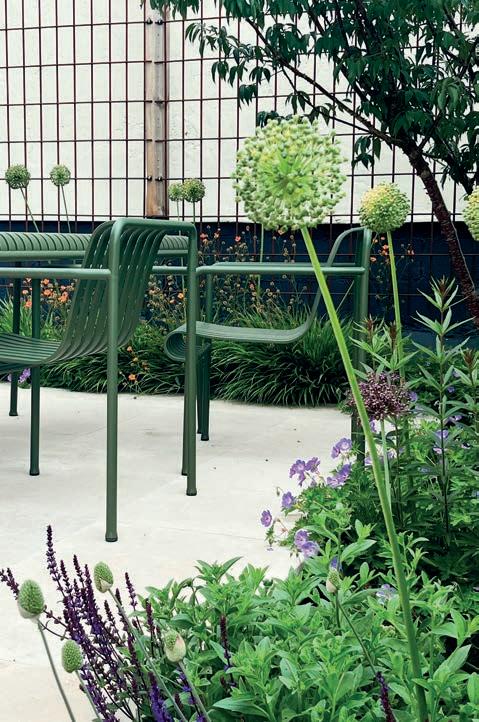
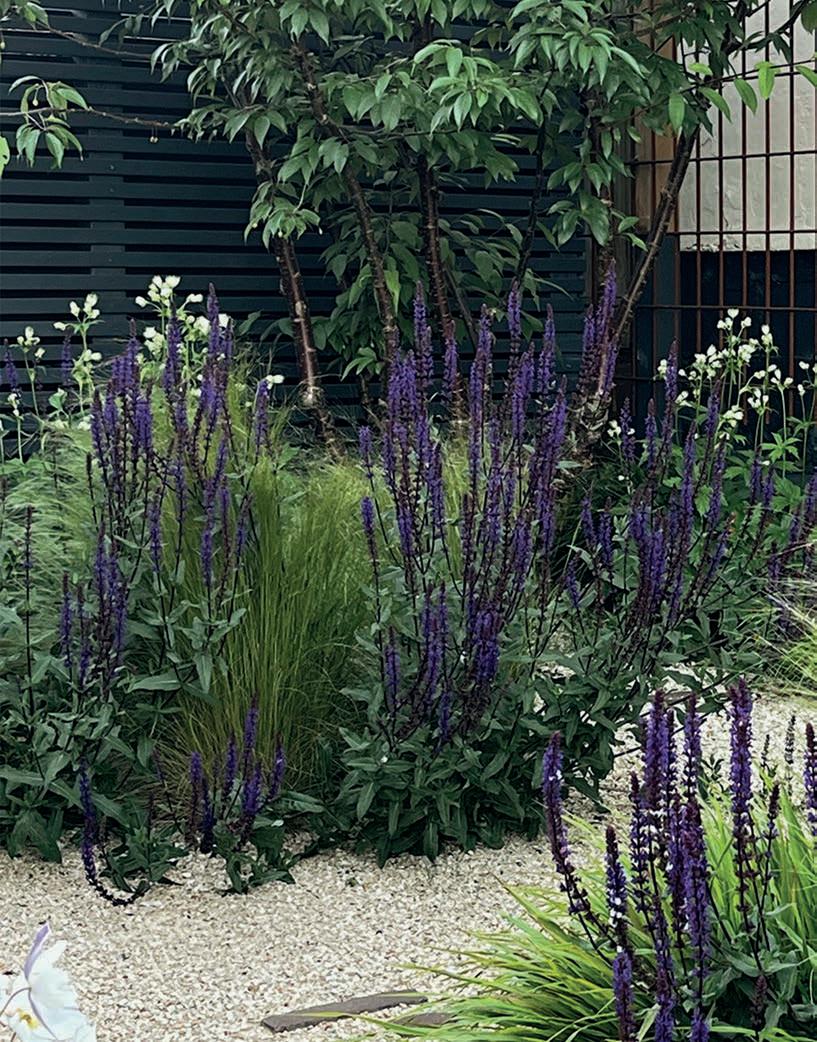

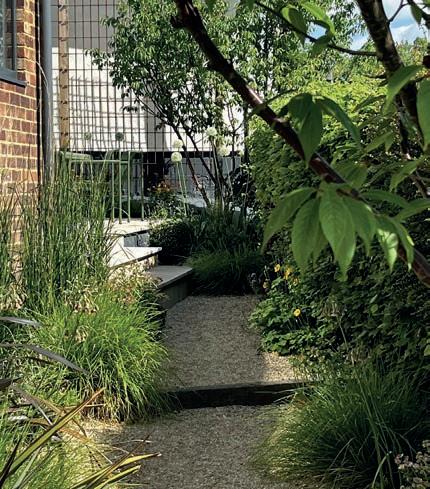
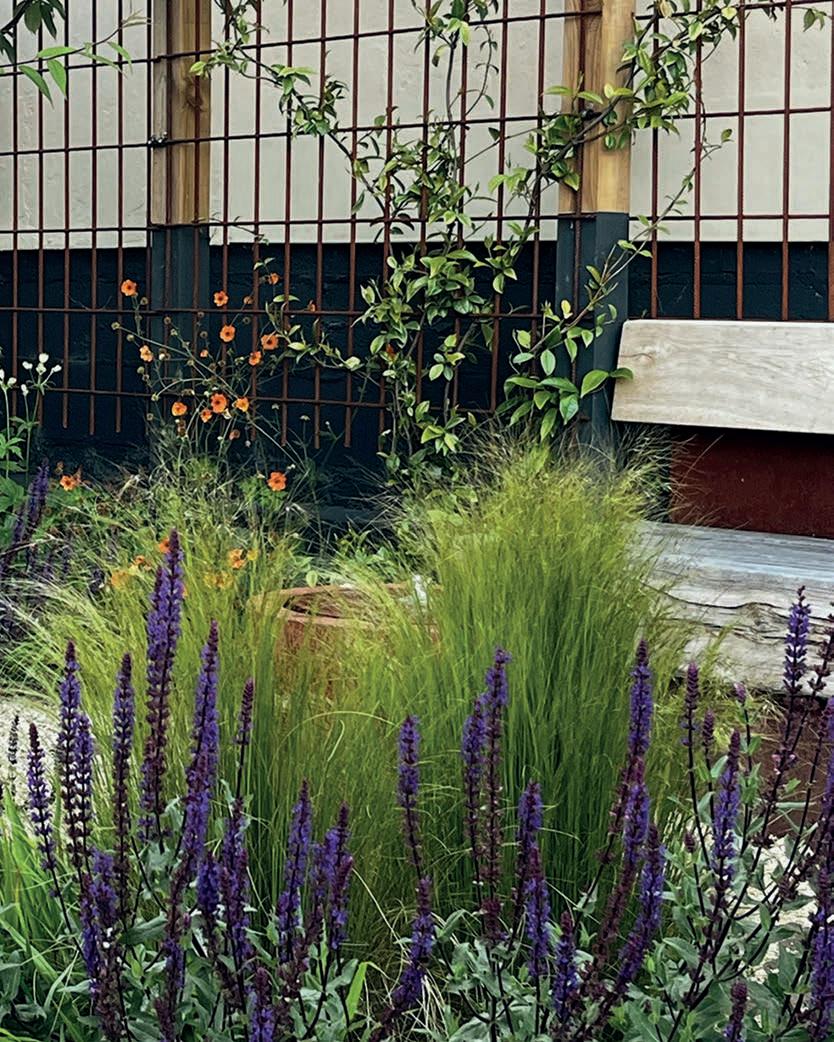
Two integrated benches, with seats also constructed from Jura limestone step profiles, were built by the walls of the house, by the kitchen door. They benefit from early morning sun and provide shade in the heat of the day.
The sawn limestone paver and stack-bond laying pattern gave a contemporary edge, referencing the rectilinear 1960s house. In contrast, tumbled brick pavers, chosen for a rural courtyard vibe, were used as decorative details within the gravel.
Remains of the local historic clay pits are evident in the landscape and therefore the brick used also references the historical
brickmaking industry in the area, complementing the local pub named The Brickmakers Arms.
a wow-factor through bespoke features like the trio of wall panels, the cut-out design inspired by a walk through the Beech woods behind the site, and the high-quality material palette, combined with the high ratio of planting.
The sculptural multi-stem trees provided much-needed vertical interest and subtle lighting transforms the space at dusk. The back-lit Corten panels wash light over the brick wall, the diffuse lighting beneath the limestone step treads and bench seats adds a warm glow, and the discretely up-lit tree stems cast delicate shadows over the painted wall.
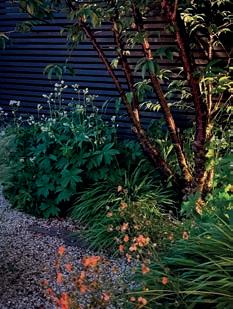
The rust coloured Corten water feature, wall screens and bench, as well as the rebar ‘trellis’ add a warmer tone.
Rigden painted the raised sides of the terrace a dark grey to keep costs down and provide a foil for the plant material as they are almost completely concealed by the adjacent foliage.
Dappled shade is provided by the new trees and the sound of the water table adds to the air of tranquillity. Rigden has achieved
The planting scheme was designed for its textural interest and limited colour palette, punctuated by two new multi-stem Prunus serrula trees.
The sculptural forms provide much-needed organic vertical structure and the copper stems tie in with the Corten steel, adding warmth and year-round interest.
The warm tone is carried through the planting, in the copper-tinged leaves of Dryopteris erythrosora and the zingy orange Geum ‘Totally Tangerine.’ Two varieties of Trachelospermum jasminoides will eventually form a green screen to mask both the wall of the house and the neighbouring property.
1 Courtyard garden in late summer
2 Courtyard garden in early summer
3 Limestone terrace surrounded by planting
4 Bespoke Corten triptych on NE-facing wall
5 Access to courtyard garden from south
6 Woodland edge planting and Prunus serrula

Plants were chosen by Rigden Studio to thrive in neutral to slightly alkaline soil and to benefit from the sheltered position. Part-shade tolerant ferns and grasses, like Hakonechloa macra and Molinia caerulea, are used to disguise the north-east facing brick wall – with cool blues and whites of Geranium ‘Rozanne,’ Anemone ‘Wild Swan’ and ‘Honorine Jobert’ popping against the lush greens.
Three clipped Ilex crenata balls provide yearround structure and a formal foil for the looser elements. The courtyard planting involved a degree of experimentation, combining Woodland Edge plants on the periphery with sunny, dry planting around the bench and water table. Due to the small space, the two planting types meet in some areas, creating an intriguing overlap. The area of full sun near the bench and water table lends itself to Mediterranean planting – movement and

translucency from grasses Stipa gigantea and Nassella tenuissima contrast with rich spikes of colour from Salvia nemorosa and Salvia ‘Amistad’ and a carpet of Thymus minimus
Subtle autumn colour was an important consideration for Rigden, and plants were selected to be a source of fodder or habitat for birds and insects, extending the season of interest for all. The biodiversity of the site was substantially increased through the variety of plant species, and numerous single flower heads to encourage pollinators. The new semi-mature trees will help with carbon sequestration and provide habitat for birds and insects.
To increase the sustainability of the project, the existing base for the terrace was re-used and spoil from the project utilised on site for the extended terrace footprint, to minimise the amount of spoil and material exported off and onto site.
The carbon footprint was considered when sourcing hard materials, with stone, aggregate, bricks, timber, and steel coming from within Europe.
The project was phased – with the design first undertaken during lockdown, and construction work completed in 2021.
There was a long lead time on raw materials for some of the bespoke elements, which delayed installation for a further eight months, and for budgetary reasons, the bulk of the planting scheme (except trees) was planted in early 2022, and a fresh layer of gravel added to complete the garden at this time.
But this project achieved what it set out to do –the courtyard garden feels like a hidden gem.
7 Bespoke Corten & oak bench with water table
8 Woodland edge scheme along NE-facing wall Photographs ©Rigden Studio Ltd
Hardscape construction
Thames Valley Landscapes thamesvalley landscapes.co.uk
Vande Moortel clay pavers Country Supplies countrysupplies.uk.com
Limestone aggregate Country Supplies countrysupplies.uk.com
Jura Beige
limestone pavers and step profiles London Stone londonstone.co.uk
Bespoke Corten wall panel triptych Stark and Greensmith starkandgreensmith.com
Corten water table The Pot Co thepotco.com
Multistem trees Deepdale deepdale-trees.co.uk
Rigden Studio, a garden and landscape design practice run by Tabitha Rigden, is located in The Chilterns, between Buckinghamshire, Berkshire, and Oxfordshire. Its gardens are characterised by clean, minimalist lines contrasting with loose, naturalistic planting schemes. Sustainability is a driving force from design concept through to build.
rigdenstudio.co.uk




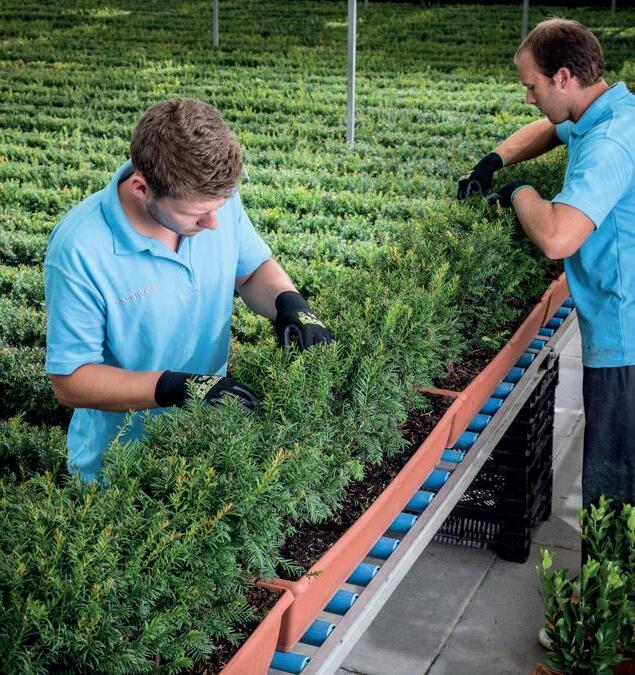

ROTHER GARDEN DESIGN & BUILD LTD
THE FRIENDSHIP GARDEN
Asked to deliver an elegant and tranquil space for its clients, Rother Garden Design & Build decided to create winding paths throughout this garden, guiding those wandering through it on a journey into a peaceful, calming place where they can escape the hustle and bustle of everyday life.
Situated at the heart of the garden is a secluded seating area which enables its clients to unwind to the sound of its stunning water feature; this creates the perfect place for them to sit back, relax and take in and appreciate the beautiful surroundings around them.

The clients explained to Rother Garden Design & Build in great depth that this is what they wanted from their garden, and so the team created a mood board of ideas which included variations of plants and colours, created sketches, drawings and designs. This enabled the client to have a clear vision of what the end result could be.
There were more than 4,000 perennials and over 100 trees and shrubs delivered to the site, which initially caused a few issues as these had to sit on site in exceedingly hot temperatures whilst the team tried to plant them as quickly as possible.


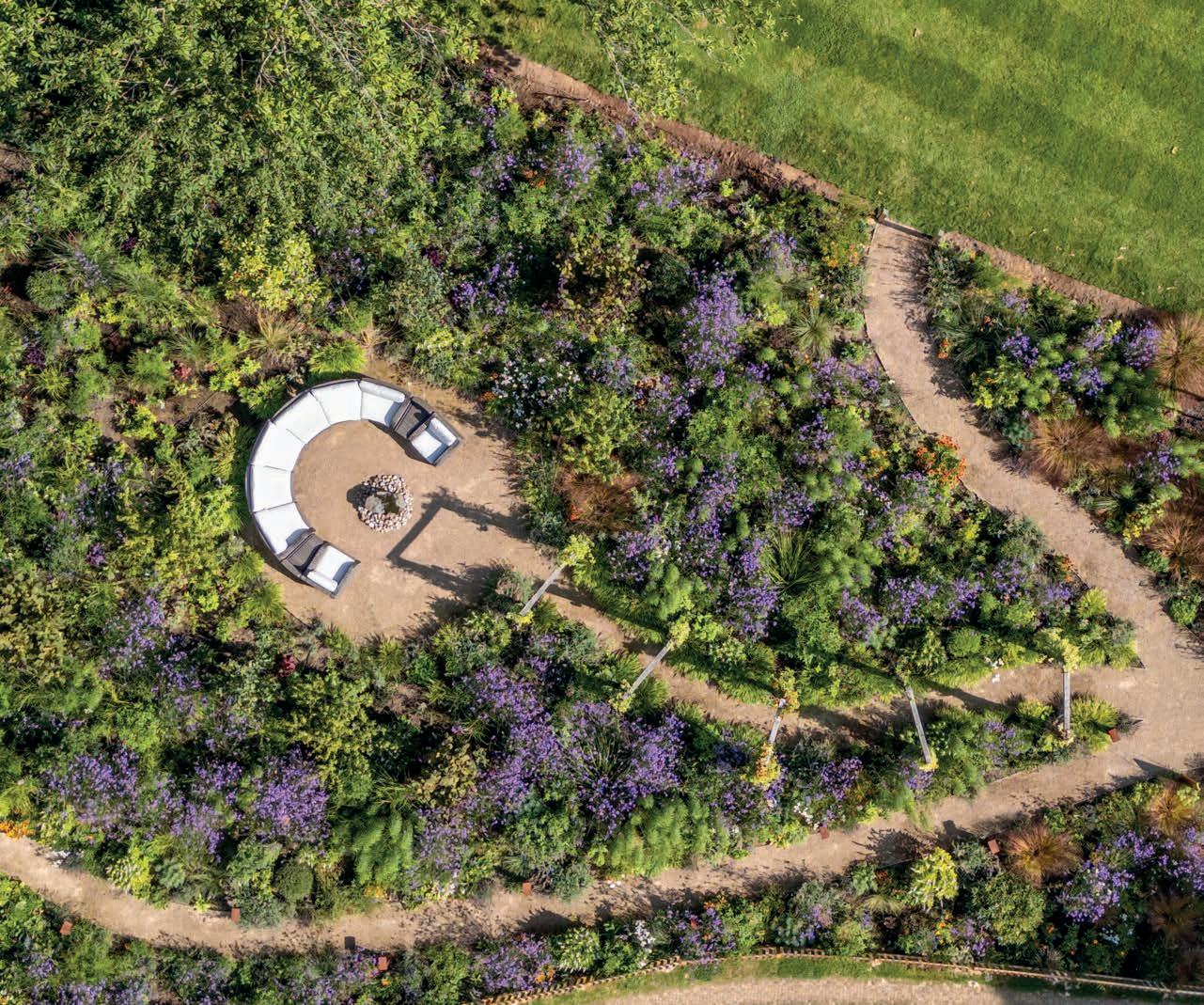




On reflection, Rother Garden Design & Build would have spaced out the deliveries across the day, allowing more time to plant in between. But they managed to overcome the problem by putting a sprinkler on the perennials for most of the day whilst trying to keep all plants shaded from the heat of the sun.
Rother also created a wave planting effect throughout the garden using different grasses and a variation of colours to keep the space vibrant as you stroll through the meandering paths.
Despite planting a vast number of perennials and biennials, Rother still chose species that will self-seed to ensure the garden will look wonderful year after year. The clients also had a maintenance team that already manages the property’s gardens and who had been taking cuttings of various perennials to plant into the garden next year.
1 A snap shot of the vast estate
2 Example of the colour contrasts used throughout the garden
3 Coruss Controversa taking centre stage
4 Birds eye view of the Friendship Garden
5 Path taking you to other areas
6 The beautiful Welsh slate water feature
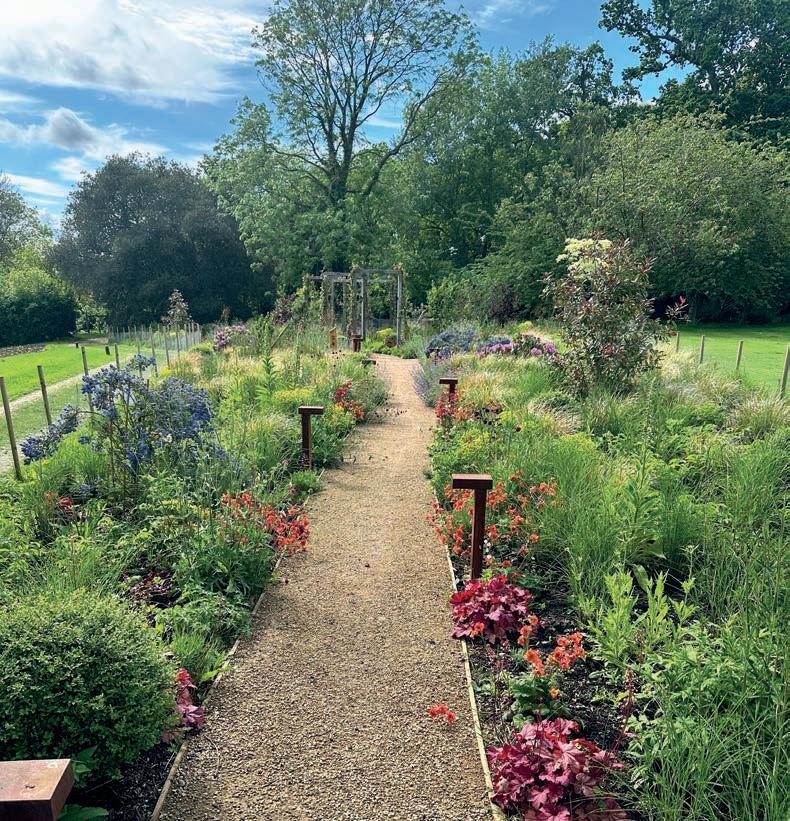
The two biggest challenges Rother faced were irrigation and a severe rabbit problem. Designing the irrigation over a garden this size was difficult; ensuring that all 4,000 plants are watered regularly in the summer months was hard enough, but with all the paths running in different directions, it took careful a lot of careful consideration.

Rother decided to go for a sprinkler irrigation system that enabled it to control the direction of the heads so it could be ensured that water was not being wasted on the paths, the grass, or around the outside of the bed. This system was proven to be very productive, and both Rother and the client were pleased with the results.
In contrast, the rabbit problem was easy to solve, and Rother felt it necessary to install a rabbit fence around the perimeter. The difficult part was trying to make sure the fence felt in keeping with the garden whilst being impenetrable to the furry friends. Rother decided to use a picket fence to give a cottage garden feel and chicken wire on the lower half of the fence dug into the ground for a secondary line of defence.
The clients were delighted with the end result of the project and have even had a public open day for friends, family, and other local people from the area to visit and enjoy this beautiful space.
7 View as you enter the Friendship Garden
8 Great progress photo of the hidden seating area Photographs ©Rob Curd, Got The Shot Media
Plants
How Green Nursery
howgreennursery.co.uk
Aggregates and compost
Homeleigh timber and building suppliers
homeleighgroup.co.uk
Trees and shrubs
English Woodlands ewburrownursery.co.uk
Lights SLV Lighting direct slvlightingdirect.com
Lights installation
Kings Electrical kingselectrical services.co.uk
Beehives
Matt Summerville at Bee Kind Hives beekindhives.uk
Water feature
Welsh Slate Water Features welshslatewater features.com
Rother Garden Design and Build Ltd was established in 2023 by two brothers, Adam and Josh Earland. With both having a passion for landscaping, garden design and over 17 years of carpentry and building experience it was time to join together to create elegant and exceptional outdoor spaces. rothergardendesign.com ABOUT



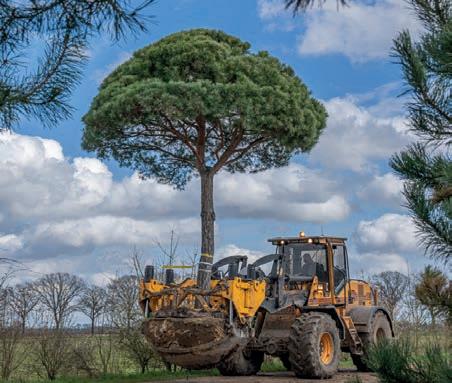

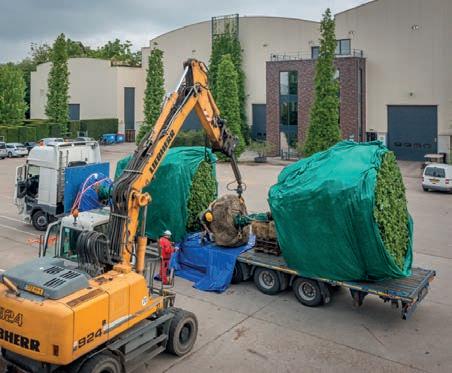

Boomkwekerij Ebben in Cuijk is sinds 1862 actief als producent van duurzaam geteelde bomen en andere beplanting voor de realisatie van nationale en internationale groenprojecten. Met een veelzijdige en bijzondere collectie bomen en heesters voor elk denkbare toepassing weten we ieder groenproject te transformeren tot een buitenruimte van formaat.
Boomkwekerij Ebben in Cuijk is sinds 1862 actief als producent van duurzaam geteelde bomen en andere beplanting voor de realisatie van nationale en internationale groenprojecten. Met een veelzijdige en bijzondere collectie bomen en heesters voor elk denkbare toepassing weten we ieder groenproject te transformeren tot een buitenruimte van formaat.
Boomkwekerij Ebben in Cuijk is sinds 1862 actief als producent van duurzaam geteelde bomen en andere beplanting voor de realisatie van nationale en internationale groenprojecten. Met een veelzijdige en bijzondere collectie bomen en heesters voor elk denkbare toepassing weten we ieder groenproject te transformeren tot een buitenruimte van formaat.
Ebben Tree nursery has been active since 1862 as a producer of sustainably cultivated trees and other planting for the realisation of national and international green projects. With a versatile and special collection of trees and shrubs for every conceivable application, we know how to transform every green project into an outdoor space that makes an impact.
Boomkwekerij Ebben in Cuijk is sinds 1862 actief als producent van duurzaam geteelde bomen en andere beplanting voor de realisatie van nationale en internationale groenprojecten. Met een veelzijdige en bijzondere collectie bomen en heesters voor elk denkbare toepassing weten we ieder groenproject te transformeren tot een buitenruimte van formaat.
Vraag onze experts voor advies over het juiste groen voor uw project. Klimaatbomen, klimbomen of bomen met een speciale kleur, vorm, hoogte of breedte; we helpen u graag. Zelf aan de slag? Stel met enkele klikken het perfecte assortiment samen met de bomentool treeebb.com
Vraag onze experts voor advies over het juiste groen voor uw project. Klimaatbomen, klimbomen of bomen met een speciale kleur, vorm, hoogte of breedte; we helpen u graag. Zelf aan de slag? Stel met enkele klikken het perfecte assortiment samen met de bomentool treeebb.com
Vraag onze experts voor advies over het juiste groen voor uw project. Klimaatbomen, klimbomen of bomen met een speciale kleur, vorm, hoogte of breedte; we helpen u graag. Zelf aan de slag? Stel met enkele klikken het perfecte assortiment samen met de bomentool treeebb.com
Want to get to know us? Come and visit our 550-hectare nurseries and experience our 1.400 m2 of roof gardens with fruit trees, herbs and a tree house. We invite you to step into our green world and ask our experts for advice on the right greenery for your project. Climate trees, climbing trees or trees with a special colour, shape or characteristics; we are happy to help you. You can also put together the perfect assortment yourself in just a few clicks with the tree moodboard tool treeebb.com
Vraag onze experts voor advies over het juiste groen voor uw project. Klimaatbomen, klimbomen of bomen met een speciale kleur, vorm, hoogte of breedte; we helpen u graag. Zelf aan de slag? Stel met enkele klikken het perfecte assortiment samen met de bomentool treeebb.com


Boomkwekerij Ebben | Beerseweg 45 | 5431 LB Cuijk T +31 485 312021 | info@ebben.nl
Ebben Tree Nursery | Beerseweg 45 | 5431 LB Cuijk – The Netherlands
Boomkwekerij Ebben | Beerseweg 45 | 5431 LB Cuijk
www.treeebb.com
T +31 485 312021 | info@ebben.nl | www.ebben.nl | www.treeebb.nl

Hard landscaping materials supplier London Stone, has been a mainstay in the sector for over a decade. Managing director, Steve Walley, talks to us about exciting developments for the business this year, and their plans for 2025.

How has 2024 been for London Stone?
2024 has been a challenging year, without doubt. There has been a lot of uncertainty around shipping rates due to various issues in the Middle East, and that's kept our logistic teams on their toes. Despite these setbacks though, we’ve stayed focused on our goal to keep delivering value to customers.
What did London Stone deliver to customers this year?
We set out our stall in January with a price freeze across our materials and have kept that promise. It's important to us that our
landscape clients can mark up our materials and make a decent amount of profit on their projects. To help with this, we temporarily increased our online trade discount to 20% in October 2023 and I am happy to say that we’ve made that increase permanent. We’re committed to playing our part in helping to make your projects as profitable as possible. This year has seen us bring a raft of new products to the market. We recently launched our range of Deluxe Pergolas, which were showcased at last month's FutureScape. We’ve seen a brilliant response so far to the new pergolas. We also launched a range of natural stone pavers, which quickly established themselves in projects across the country. They’re priced super-competitively and look great when paired alongside sawn paving materials and porcelain. Tactile materials and contrasting textures are the order of the day right now and it’s a trend that I really like.
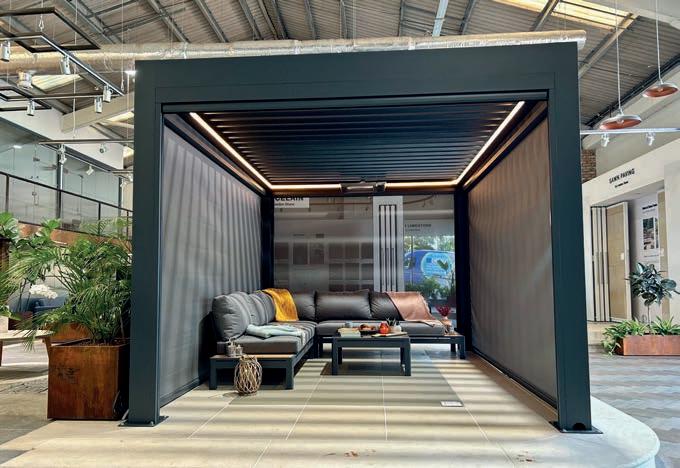
Can you tell us more about the new Deluxe Pergolas?
After supplying various pergola brands as a third-party seller, we were seriously underwhelmed with the service levels and product quality we experienced. Having full control of the supply chain is critically

important to our business model, so we bit the bullet, found a manufacturer, and developed our own range of pergolas. We’ve worked on this for the past 18 months and the collection is now available on our website.
Offered in a range of modular sizes, from a 3 x 3 x 2.5m model up to 5 x 4 x 2.5m, the pergolas represent outstanding value, starting at just £7,360 (excl. VAT) for trade customers when bought online. The pergolas are supplied with a 10-year warranty, and have in-built LED lighting, electronic louvred roofs, and Somfy control systems, which can be controlled via a mobile app or linked to existing home automation systems.
Electronic shade blinds and heaters can also be added to the spec. The pergolas are in stock and can be ordered online with the standard London Stone 20% trade-only discount. When you buy one of our Deluxe Pergolas, we will be there to help you with any installation queries and aftercare advice.
What other new products are on the horizon?
The popularity of porcelain continues to grow, as many homeowners prefer lower maintenance, colour-consistent paving materials. We’re about to add two more porcelain products to our range, which emulate the prestigious Grey Yorkstone, and the modernity of Sawn Sandstone. These materials give customers even more choice when selecting materials and won’t break the bank.

Are there any new natural stone materials on the horizon?
Yes! We love natural stone. We’re currently curating a 'Prestige' natural stone range, tailored towards the quality natural materials of the UK and Europe.

Garden designers and landscape architects won’t want to miss this premium collection, so stay tuned for further details.
Craig Potter, whom many readers will know, has also returned to London Stone to introduce this new natural stone range, so keep your eyes open for him.

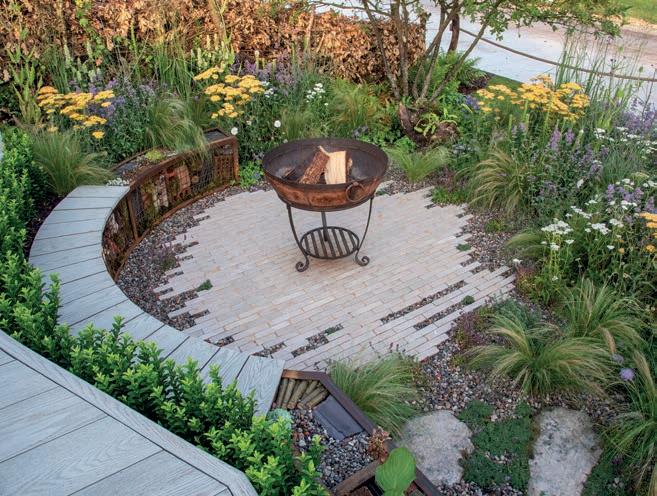
How is your network of nationwide showrooms?
The showroom expansion continues. We are currently putting the finishing touches to our brand-new Milton Keynes showroom which opens in early 2025. We’re looking forward to having a permanent base to serve Buckinghamshire, Oxfordshire, Northamptonshire, and Hertfordshire.
Unfortunately, we had to close our Essex showroom this year due to the sale of the land. However, we’re actively seeking a new location to serve the region.
In the meantime, our existing showrooms have undergone refurbishment this year, ensuring that they remain relevant, inspirational hubs for both trade professionals and homeowners alike. Many of our
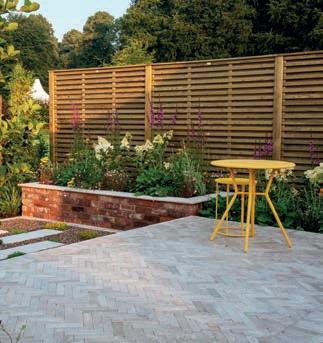
showrooms are geared-up to host industry events like training, seminars, or workshops. We’ll never charge you to use our facilities, so please do get in touch.
Here’s to a busy end of 2024, and a prosperous 2025 for the sector!
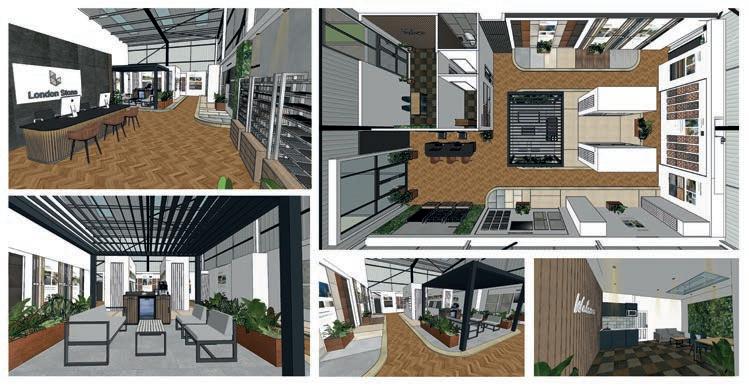
London Stone –How Beautiful Gardens Begin
For more information on how London Stone can enhance your next scheme: londonstone.co.uk
info@londonstone.co.uk 01753 212 950


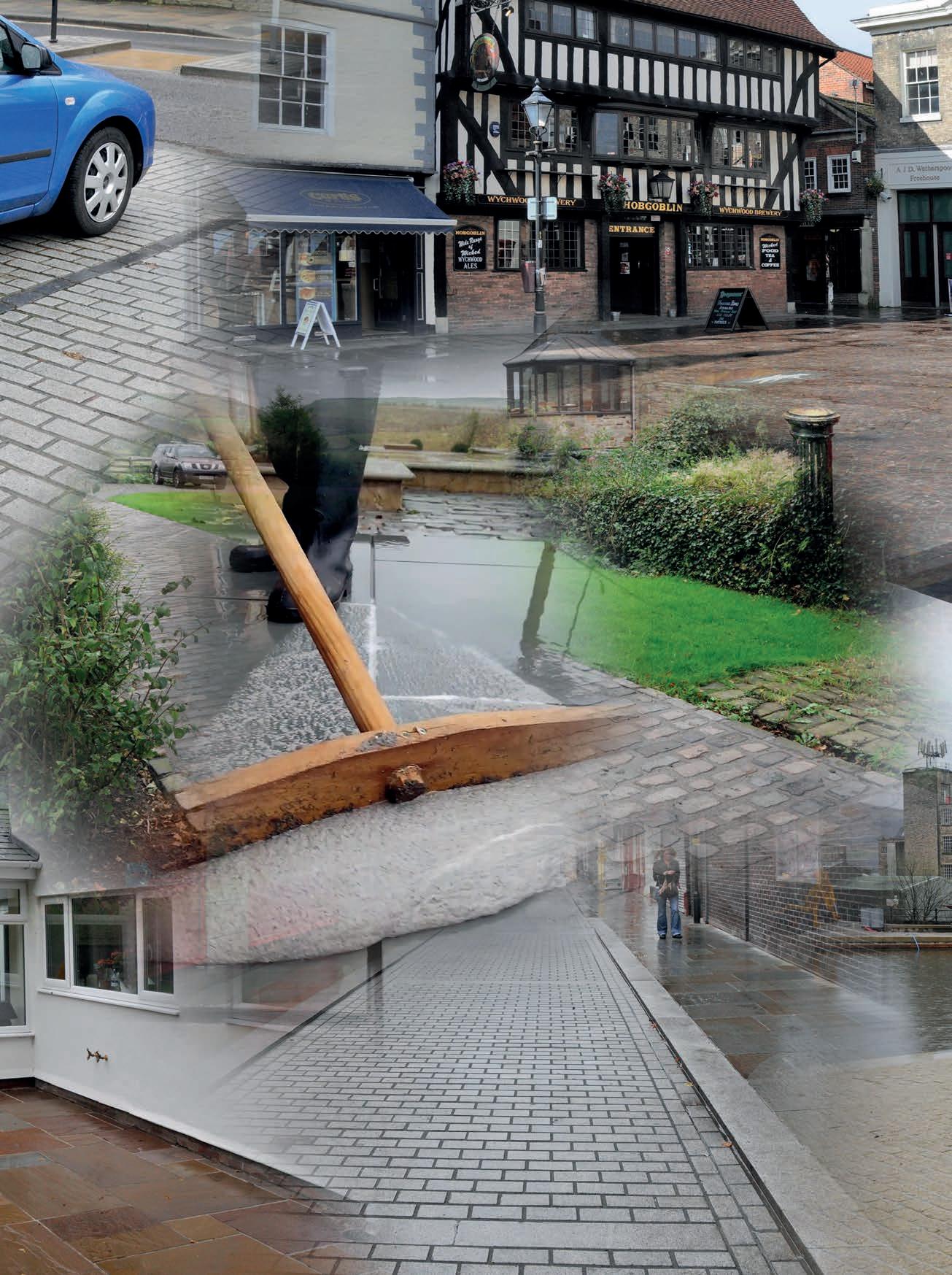







• Keep jointing in cold (> 3oC)
• Keep jointing in wet weather
• No delays - No waiting to joint
• No concerns over water in joints
• No waiting to clean off
• No washboy required
• No haze & No efflorescence +
• Easy wet-slurry application
• Very high flow & self-compacting
• No tooling or finishing required
• Fast curing & hardening +
• No shrinkage cracks
• Highest joint performance
• Optimum strengths & flexibility
• Fully resistant to traffic, de-icing salts, and jet-washing

Project value
Undisclosed
Build time
7 months
Size of project 2 acres
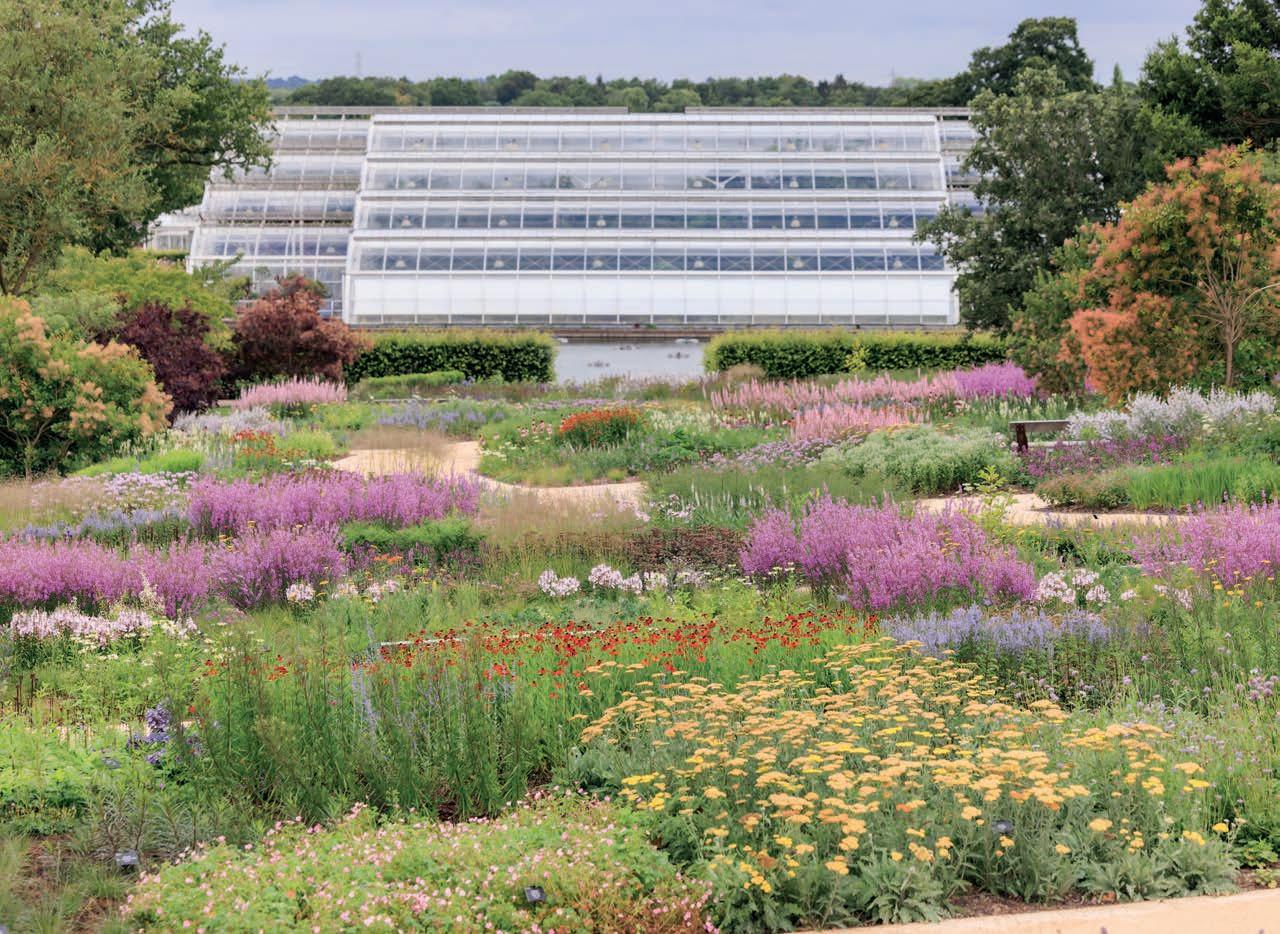
RHS Garden Wisley, a designated Grade II Historic Park and Gardens, is the flagship of the Royal Horticultural Society (RHS). Covering 240 acres, it is one of the UK's most visited and best-loved gardens, drawing about one million visitors each year. To keep them modern and revitalised, the RHS continually undertakes rejuvenation projects across its gardens and the new Oudolf Landscape is a prime example of this.
The Glasshouse Borders have provided an avenue linking the Bicentenary Glasshouse to the Viewing Mount for many years, and the Oudolf Landscape is a key initiative that has invigorated the borders and created a more flowing network of paths and planting that offers significant interest in its own right.
In 2001, Piet Oudolf, the iconic landscape designer and pioneer of the new perennial movement, designed the original Glasshouse Borders at RHS Garden Wisley. Fast-forward 22 years, and the brief was to transform these borders into a fresh landscape that immerses visitors in Piet Oudolf’s signature planting style. The new design also needed to be environmentally sustainable and educational, focusing on climate-resilient gardening while inspiring visitors to learn about sustainable practices.
The design for the Oudolf Landscape was a collaborative effort between Piet Oudolf and the RHS Garden Wisley team, with Blakedown Landscapes acting as principal contractor. There wasn't a fixed design;
1 Four months on and the garden is maturing beautifully ©RHS/Oliver Dixon
instead, the team worked with an evolving 2D plan, with changes made in real-time as the landscape took shape. This flexible approach allowed the landscape to grow organically, following Piet Oudolf's vision and the natural contours of the land. The result is a fluid network of paths and planting beds, offering continuous discoveries for visitors as they wander and explore.
Blakedown worked closely with the RHS Garden Wisley team, Piet Oudolf, and other stakeholders to ensure a smooth project execution. Their expertise in landscape construction, combined with adaptability, made sure the highest standards were met at every stage, ensuring the final landscape exceeded expectations.
The Oudolf Landscape planting design strikes a balance between spontaneity and control, a hallmark of Piet Oudolf’s approach. The matrix planting system features one or two dominant varieties, complemented by other plants for a seemingly effortless yet structured look. Piet Oudolf emphasises that planting is the exciting part, saying: "I want to make it interesting for people, give them something to talk about."


Around one quarter of the 36,000 perennials were propagated at RHS Garden Wisley, tying the landscape back to its horticultural roots. The design also introduced 117 new species and cultivars, selected for their beauty, resilience, and wildlife benefits. Signature plants like Hylotelephium ‘Sunkissed’, Salvia x sylvestris ‘Rhapsody in Blue’, Sporobolus heterolepis and Echinacea purpurea ‘Fatal Attraction’ ensure a visually striking and ecologically harmonious landscape.
Central to the project was the installation of 1,556m2 of Gold CEDEC self-binding gravel footpaths, which formed the backbone of the new landscape. These footpaths demanded precision in setting out, creating varied levels and sculpting the land to actualise Piet Oudolf’s vision and to add depth and movement to the landscape.
To define the borders and enhance the garden’s structure, over 1,200m of Corten steel edging and 300m of timber edging were installed. These edges required
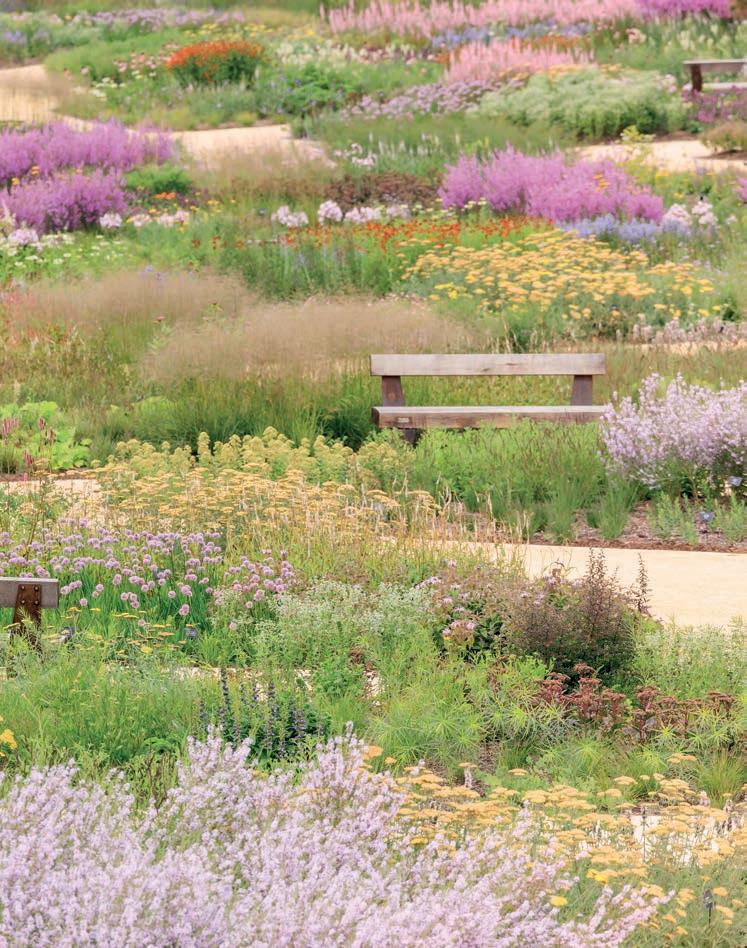
precise planning and execution to achieve the smooth curves and seamless radii that Piet Oudolf is known for.
In preparing for the extensive planting, 3,000m2 of planting beds were graded and shaped, preparing the soil with RHS Garden Wisley's proprietary compost to create the perfect conditions for growth.
Water management was a key focus with an ACO drain system installed along the pathways and in the apron area to the north of the garden, with soakaways integrated into the planting beds to efficiently manage stormwater runoff.
The hard landscaping elements added structure and function to the garden. Block paving was strategically placed at key points, such as path thresholds and seating areas, to ensure smooth access and a polished finish. Additionally, 171m of tar and chip surfacing was laid in the northern apron area, providing a durable yet aesthetically pleasing surface to complement the natural beauty of the planting.
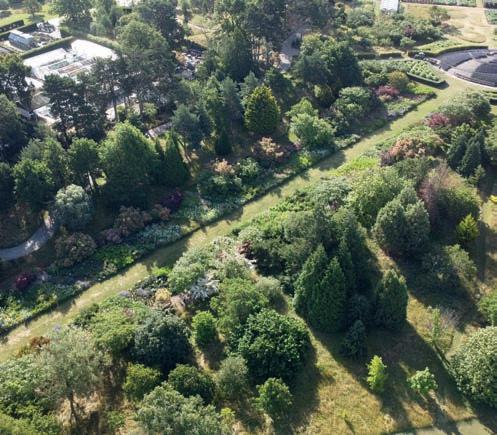
THE
RHS
BY
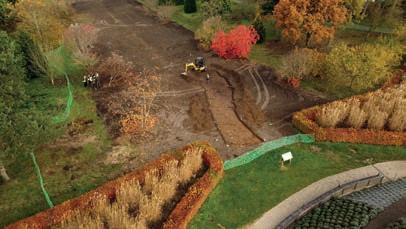
PINNING OUT THE RADII AND CURVES FOR THE SERPENTINE FOOTPATHS
Sustainability was a key priority and RHS Garden Wisley was determined to make the Oudolf Landscape not only beautiful but also climate-resilient and ecologically beneficial. This meant reusing the original soil, enriching it with high quality compost to ensure a healthy growing environment.
To further promote sustainability, eco-weed biodegradable matting was applied to around one-third of the planting beds. This matting helps suppress weed growth and retain moisture, contributing to the garden’s long-term environmental resilience.
The project faced several challenges, including the evolving design, which required Blakedown to stay flexible and adapt as ideas developed, with refinements incorporated smoothly, without delay to the project.
2 Pathway meanders through vibrant garden blooms ©RHS/Oliver Dixon
3 Curved paths complement naturalistic design ©RHS
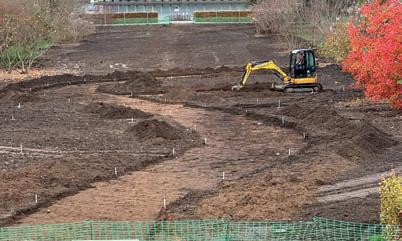
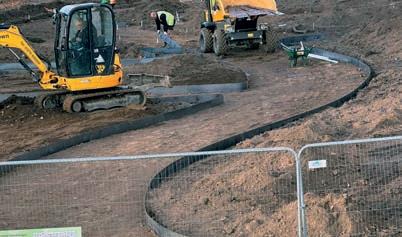
AND
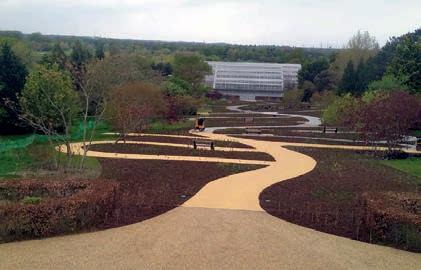
CEDEC GRAVEL TO THE PATHWAYS
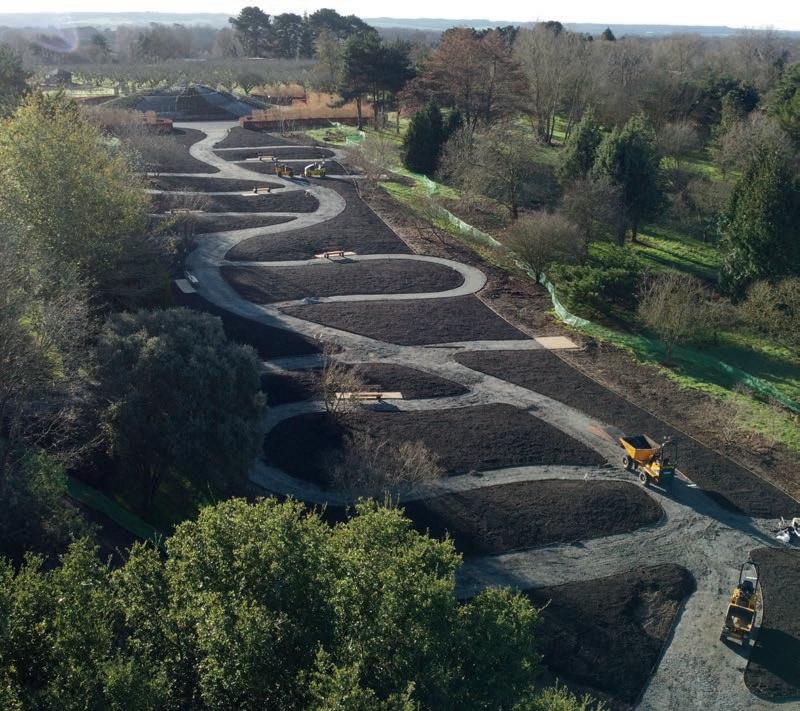
Another challenge was the absence of a detailed levels plan. Blakedown had to design the levels in real time, shaping the land as they went and working closely with the design team to ensure the finished landscape was both functional and visually appealing.
Appalling weather conditions during the winter months also posed difficulties, requiring the Blakedown team to shift to more manual work to keep the project on track.
The Oudolf Landscape at RHS Garden Wisley is a triumph of collaboration, craftsmanship, and creativity. What started as a vision to refresh the Glasshouse Borders has blossomed into a dynamic and immersive landscape that invites visitors to explore, learn, and connect with nature.
Thanks to the combined efforts of Piet Oudolf, the RHS Garden Wisley team and Blakedown, the result is not only a visual delight but also an educational experience in sustainable gardening. The Oudolf Landscape is now an integral part of Wisley, offering a fresh perspective and a dynamic experience for visitors for years to come.
4 Finishing the planting beds with RHS Garden Wisley’s homemade compost ©RHS
5 Geoff Barber, Blakedown operative, planting ©RHS
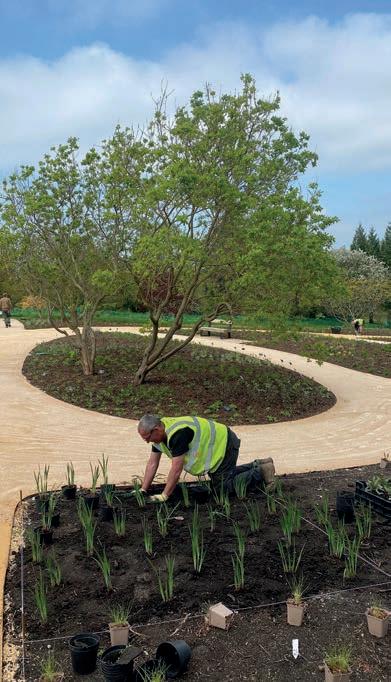
Landscape designer Piet Oudolf oudolf.com
CEDEC path surfacing CED Stone Group cedstone.co.uk
Corten steel edging EverEdge everedge.co.uk
Clay pavers Country Supplies countrysupplies.uk.com
Weed membrane Hy-tex UK hy-tex.co.uk
Timber edging The Timber Group thetimbergroup.co.uk
Blakedown Landscapes is an award-winning landscaping and civil engineering specialist delivering high quality projects throughout the UK. With over five decades of experience, its extensive knowledge spans all sectors including local authorities, royal parks, commercial developers, educational facilities and historic park restorations. Its team of highly skilled in-house experts works collaboratively with clients offering best practice advice and innovative value engineering solutions to ensure the optimal outcome for every project. blakedown.co.uk










ould you ever build a house without heating? Probably not. So why leave it out of your garden design?
Heating isn’t just a luxury – it's the key to enjoying your garden well beyond the summer months. Imagine being able to entertain, dine, or simply relax in your outdoor space even when the temperature dips. At Consilium Hortus, heating is often one of the most important elements we discuss when helping our clients shape their dream gardens. It becomes an essential feature, transforming how they envision using their space.
In fact, heating is almost always on our clients' wish lists right from the start. When we present our CGI designs and 2D spatial plans, heating is a focal point of the concept, often playing a central role in creating a cosy, inviting atmosphere.
Outdoor heating is key for creating gardens that can be used throughout the seasons, explains Samuel Moore
But the question remains: what kind of fire or heating feature is right for your garden? With so many options available, it can be tricky to decide. Let me break down some of the most popular choices and help you figure out what works best for your garden.
When most people think of adding heat to their garden, a fire table often comes to mind first. It’s easy to see why. Fire tables offer warmth, soft lighting, and a focal point for social gatherings. Whether you're dining, lounging, or chatting with friends around it, the fire table creates a hub for interaction and relaxation.
There are many options when it comes to size, height, and design. You can choose from
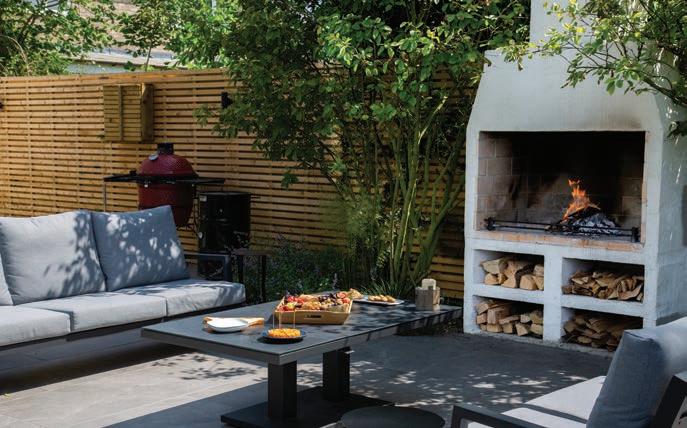

dining table-sized versions, coffee table heights, or even a bar-style table. One of the most popular options we often recommend is the coffee table-sized variant from our trusted supplier, Luume Fires. It's the perfect height for gathering around while still being functional and aesthetically pleasing.
For those looking to make a bold statement, outdoor fireplaces are a fantastic option. These create a dramatic focal point that can anchor the entire garden design. Fireplaces offer not just warmth but also a striking visual element, providing structure and style to the outdoor space.
A fireplace can turn an ordinary garden into an enchanting retreat. You have a lot of flexibility in terms of materials and finishes, whether you prefer the traditional charm of brick or drystone walling or the sleek, modern look of porcelain cladding. By strategically placing furniture around the fireplace, you can create a social hub that feels intimate and inviting.
LPG vs wood – which one’s right for you?
One of the biggest questions we ask our clients is whether they prefer LPG (liquefied petroleum gas) or wood as the fuel source. Both options are perfectly suited for outdoor use, but they each bring a different feel and experience.
Wood-burning fires evoke memories of campfires and cosy nights under the stars. There’s something undeniably satisfying about the crackling sound and rich scent of burning wood. However, wood fires can be a bit tricky when it comes to regulating heat output.
On the other hand, LPG offers a more controlled and convenient option. With the flick of a switch, you get instant heat, and you can easily adjust the temperature to suit your needs. No more fussing with logs or worrying about the fire going out. The one consideration with LPG is that you’ll need to store a gas bottle or run a gas line to the feature, which may not always be feasible depending on your garden layout.
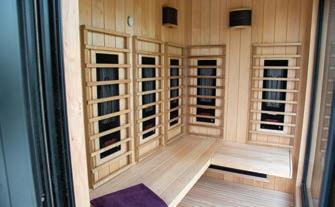
lights, perfect for hanging over a dining table. You can also find more minimalist designs, like rectangular heaters that blend seamlessly into walls or pergolas.
Whether you opt for a fire table, fireplace, or modern infrared heating, making this decision early in the design process ensures that your garden feels complete and cohesive
One interesting use of infrared heat that we’ve implemented for a client was incorporating it into a custom outdoor sauna. Not only did this add a touch of luxury, but it also provided health benefits that come with regular sauna use –truly turning the garden into a wellness retreat.
Don’t let heating be an afterthought

42 Fire Bowl
Decor’s Luna 42 fire pit combines modern design, durability, and warmth to create a stunning centrepiece for outdoor spaces. Price (incl. VAT): From £6,348 solusdecor.co.uk
Infrared heaters – sleek and functional
For those looking for a more modern, low-maintenance option, infrared heaters might be the way to go. These electric
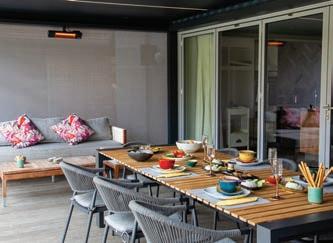
heaters provide a consistent source of warmth without the need for gas or wood. They’re also incredibly versatile in terms of design and can be easily incorporated into various garden styles without standing out as “just a heater”.
There are some stylish options on the market, including infrared heaters designed to look like oversized lamps or pendant
As gardens become more than just outdoor spaces, transforming into extensions of our living areas, heating is no longer a nice to have: it’s essential. Whether you opt for a fire table, fireplace, or modern infrared heating, making this decision early in the design process ensures that your garden feels complete and cohesive. With the right heating elements, you can enjoy your outdoor space all year long, no matter the weather.
At Consilium Hortus, we always consider how our clients want to live in their gardens – and heating is a big part of that lifestyle. Don’t wait until the last minute to add warmth to your design. It’s the key to making your garden feel like home, no matter the season.

Samuel Moore runs Consilium Hortus, an Essex-based company that creates bespoke garden design solutions for private and commercial clients. One of Pro Landscaper’s 30 Under 30: The Next Generation winners, Moore has previously worked for various award-winning design and build companies and has a degree in Landscape and Garden Design from Writtle University College. consiliumhortus.co.uk
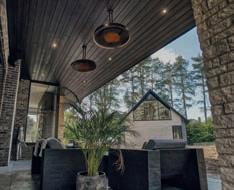
high-efficiency radiant heating, the collection is available in seven mounting options to bring warmth and light to any outdoor space.
(incl. VAT): From £2,885 bromic.co.uk gardenhousedesign.co.uk

It’s already made huge strides in the last few months, but Greenwood Plants has no intentions of slowing down – with net zero being one of its ambitious targets

Greenwood Plants isn’t afraid of a challenge. Last year, the nursery took on its largest contract to date, working with National Highways to deliver three million native trees grown from seed and without peat over a five-year period. Species such as Taxus baccata, Ilex, and field maple will be delivered to community projects, with support from The Tree Council, and to national road infrastructure projects, providing environmental and social benefits to local communities. The first batch of 450,000 trees is due to be dispatched in
November, but this will continue through the season. Greenwood is eager to take on large contracts such as this and continue on what the company believes is a massive growth trajectory for the nursery. We want to grow year on year and expand our workforce and our capabilities to clients and our flexibility.
Its goal is to be the best landscape supply nursery in Europe, specialising in perennials, trees, and shrubs. The tradeonly nursery handles more than six million plants a year, both sourced and grown – and everything it does grow is peat free as of last


October. Greenwood dedicated 18 months working towards this goal, winning numerous awards as a result, including the HTA’s Peat Free Grower of the Year in 2023 and the AIPH’s International Grower of the Year in January. It’s now encouraging its supply chain to make the switch.
On top of this, Greenwood added to its accolades in February by gaining Plant Healthy certification.“Becoming Plant Healthy and growing peat free is going to help us secure more projects like National Highways. We want to demonstrate that we can grow on a larger scale for projects such as these.”
It grows a core range of common landscaping plants with a focus on new-build properties, but a slump in the housing market toward the end of last year propelled the nursery to diversify.“We don’t want to be too dependant on one particular market. If the housing market crashes, that could have

a massive impact on us, as well as our clients.” So, Greenwood is currently expanding its operations into commercial and infrastructure schemes. It recently won a contract with Essex County Council, as well as the National Highway’s low carbon initiative to benefit both nature and communities. Some of the plants for the latter are being grown at Fresh Acres, the nursery’s flagship site in Arundel, West Sussex. This is where Greenwood undertakes a large amount of propagation. It’s also home to Greenwood’s major dispatch yard, from where most of its orders will leave to go to clients all over the country. This now uses mostly electric forklifts and oversees product from its own sites as well as other UK nurseries and its Dutch arm, Greenwood Holland, from which trucks are arriving daily ahead of the busy autumn planting season. There’s now a quarantine area at Fresh Acres too, part of gaining its Plant Healthy status.
Beehives are another recent addition. These were fruitful in their first year, but the wet weather this year has prevented the bees from foraging as much. “We also lost a number of queen bees, so unfortunately, we won’t be producing any honey this year,” says Kevin Merritt, one of the trained beekeepers who also runs the nursery’s trade sales centre, Greenwood Choice. Like a cash and carry for landscapers, the centre offers instant plants for instant impact. It’s only open to members of the horticultural trade and helps to supply smaller orders or requests for larger specimens.
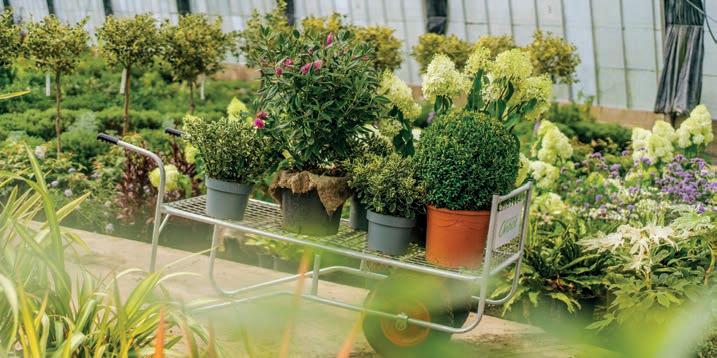
will be moved and repotted there. Also nearby is Woodpecker, where its five to 10L evergreens are grown.
The newest site is Pigeon House Farm, a 150-acre farmland where a lot of Greenwood’s bareroos will be grown and where stock for the National Highways’ project is now in the ground. It will be dedicated to growing native British trees. The idea is to shift to more homegrown than traded; that’s the way in which we’re moving – the demand is there.
The idea is to shift to more home grown than traded; that’s the way in which we’re moving – the demand is there
With biodiversity net gain, there’s going to be a shift towards British- grown native plants too.
Greenwood's business has expanded massively over the last five years. Produced 15% last year and 30% the year before that. So, we're growing our sites to account for that and because we want to grow more of our own bareroot here in the UK.
Greenwood introduced G Cycle, a “marketleading packaging recycling offer” with a 90% recycling rate. It’s a rebate scheme for wooden crates and plastic pots sent out to clients. A packaging fee is placed on all orders, which is then reimbursed when the packaging is returned.
Greenwood Plants is actively investing in its processes to reach its ultimate goal of becoming net zero. It has an industrial-scale pot washing machine that completely sanitises and cleans the pots that come back, which allows us to reuse them approximately three times,
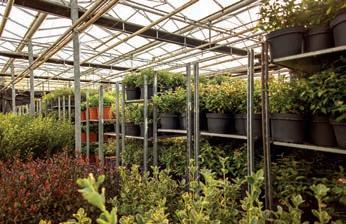
Fresh Acres is one of five sites based in Sussex. Just down the road is Maple Tree, which specialises in two- and three-litre pots. A lot of the plants propagated at Fresh Acres
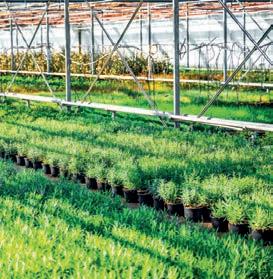
Its largest site in Sussex is Highleigh near Chichester, which specialises in twoand five-litre evergreen shrubs. This is also where Greenwood’s new plastic baling machine is being trialled. Two years ago,
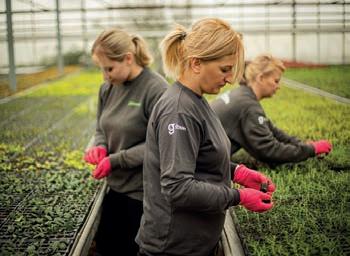
depending on how well the pot has been treated.” The pots that can’t be reused are crushed into bales, which are then accepted by a local recycling centre in Sussex.
Despite its growing presence in the south of England, Greenwood has more northern roots. It was founded in Chester in 1979 and still has two sites there today: Willaston and Acresfield.
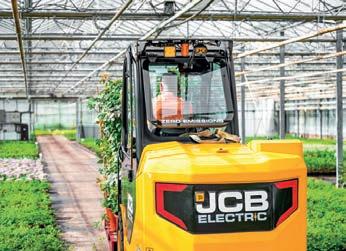

These bring the total acreage of Greenwood’s seven sites to 270, with more than 120 employees spread across them.
It was set up in West Sussex in 2010 because of the “opportunities in this area, particularly with the landscaping industry,” but also because the “temperate climate” makes it ideal for growing.
When we visit at the start of October, Fresh Acres is gearing up for the arrival of tens of thousands of bareroot hedging products from the continent. These are a large part of what Greenwood does in the winter, says Merritt. Many housing developments are granted on the basis of native hedging being planted as a perimeter to provide corridors for wildlife as well as being a valuable food source. The most economical way to plant large quantities of this is using bareroot hedging, he explains. “They are grown in big quantities in central Europe and lifted in the winter when they’re dormant. We receive them in a little bundle of twigs, which can be planted from November through to March begins to grow when the warmer weather comes in the spring.”
Fresh Acres has a series of propagation units, most of the material for which comes from cuttings, but there’s also an element of seed or plant division, depending on the type of plant.“Our production team will look at the prospective sales of certain products and feed this through to the propagation department so that they know how many cuttings of a particular plant they should be propagating at a certain time.”
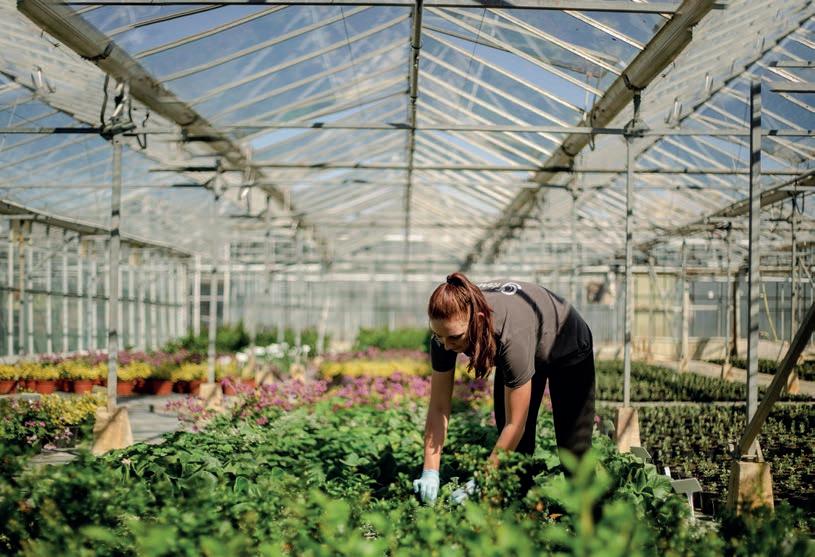
We’re always actively investing in our processes to try to reach our ultimate goal of becoming net zero
Plants that need slightly warmer conditions to root, especially going into winter, are put into a section of the greenhouse that is heated by biomass boilers and where automatic misters create rainforest conditions. Once they have sufficiently rooted in this artificial environment, they can be moved out. The next stage is being placed in ‘28s’ - trays with 28 cells –to encourage further growth. The propagation team will usually trim the tops of these plants once or twice; this creates cuttings but also produces healthier, bushier plants.
An automated potting machine helps the team place propagated plants into the trays. “We couldn’t produce the volume we do without these modern potting machines. We can process a huge batch of several thousand plants in one go, so there’s a considerable time saving.”
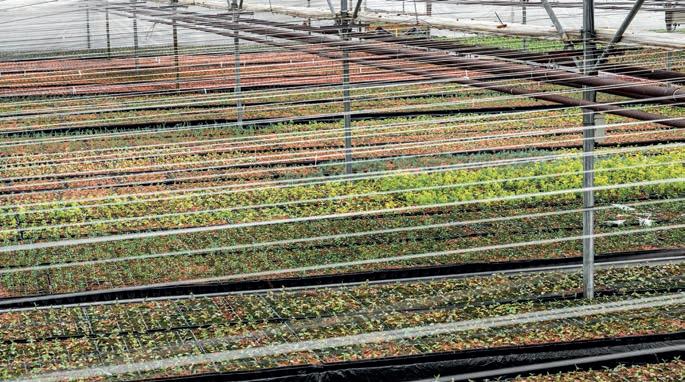
Most of these end up being transported to Maple Field down the road, where it will usually be placed in two-litre pots, and a percentage will go onto three, five, seven, and a half litres, and 10 litres. In the next three to four weeks after we visit, around 320,000 plants will be potted. Last year, Greenwood potted two and a half million across its sites.

Minimum stock levels of various plants are kept to meet short-notice orders, some from the 28s grown on-site. These potted plants are watered from beneath in flooding beds, which fill for 20 minutes before draining for reuse, minimising water waste.
Greenwood is about 85% self-sufficient in terms of water on its nursery sites, working toward 100% in the future.
“We have large water tanks that collect rainwater as well as various reservoirs on each site that pump water into the irrigation systems, and anything that is unused is drained back into the tank.”
Greenwood's focus on biosecurity to sustainability positions it well for projects like low carbon initiative, with more likely to follow.
greenwoodplants.co.uk
KönigOutdoor is a British manufacturer of bespoke outdoor kitchens, supplying luxury stone-clad cabinetry and outdoor appliances.

Alfa Forni Nano Pizza Oven Price from £1,045
• 3cm thick firebrick oven floor.
• Reinforced stainless steel cooking chamber insulated with ceramic fibre.
• Heats up in 10 minutes and uses similar energy to two gas rings.
• NG and LPG versions available.

For a stylish and simple-to-use pizza oven capable of cooking an authentic Italian-style pizza in 90 seconds, which has an innovative three-layer ceramic fibre dome that allows the oven to gain and retain heat efficiently while keeping fuel consumption low and is available in wood or gas fired options. konigoutdoor.co.uk
DeliVita woodfired pizza oven Price from £1,395
• Clay-composite interior encased in high-tech insulation and a thick fibreglass shell.

• Premium build, handmade in Yorkshire.
• Reaches temperature of 550°C in 25 minutes.
• Versatile 540x500mm cooking area.

The insulated clay lined interior can be used as an oven, allowing you to cook directly on the base or using a pan, skillet, or suitable baking tray. The premium portable ovens are made by hand in Britain and are available in a range of colours. delivita.com

Feast your eyes on the culinary movement that’s turning gardens into the next hottest pizzeria
Founded by two childhood friends, Alfresco Chef delivers the taste of wood-fired cooking straight from the garden, fuelled by a passion for quality and sustainability.
Alfresco Vita
Price £645 – if pre-ordered now for delivery in spring 2025. RRP/ cost next year will be £1,295.
uel: use wood or gas for flexible cooking.
ooth thermometer and app for effortless control.
• Safe-to-touch design with integrated ashtray for convenience.
• High grade 25mm stone ensures excellent heat retention.
• Reaches up to 550°C for perfectly crispy pizzas.
This high-quality, multi-functional outdoor oven runs on both wood and gas, with a built-in bluetooth thermometer and app for easy control. Capable of reaching a high of up to 550°C, making it perfect for crispy pizzas, its safe-to-touch design and excellent heat retention ensure top performance. alfrescochef.co.uk

• Fully stainless steel.
• A mix of 304 and 316 marine grade.
• State-of-the-art ceramic coatings to protect your oven for life.
• Unique reverse flow lid is designed to create perfect heat distribution.
• Hot Start means setting your fire is as easy as pushing a button.

At Stagforge, fire and smoke are a way of life. Born from the campfire and the beautiful chaos of the commercial kitchen, its revolutionary new ovens are the gateway to culinary excellence at home.

When paired with its reverse flow exhaust and heavy double steel walls, Stagforge’s Hot Start Hybride custom air inlet creates a fuel efficient and controllable environment, minimising hot zones. The lid has been specifically designed to create the perfect pizza. stagforge.co.uk

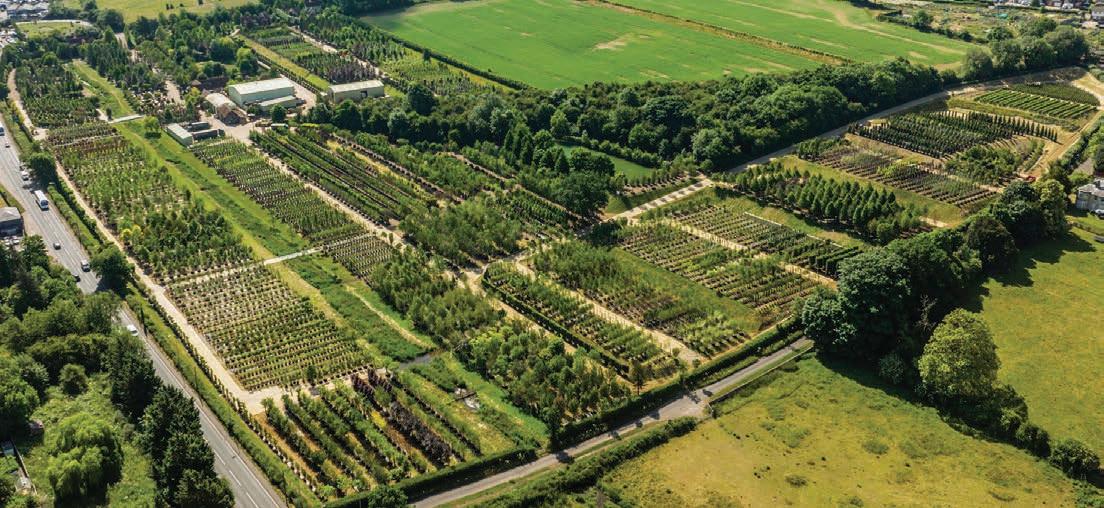



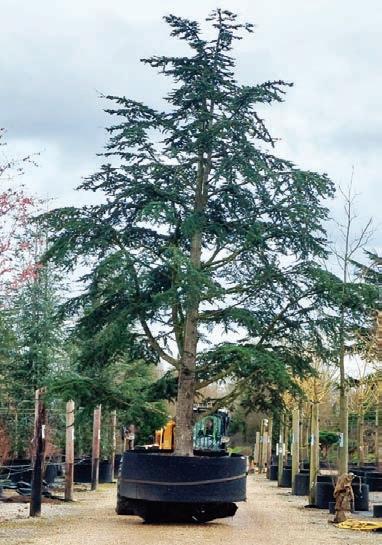
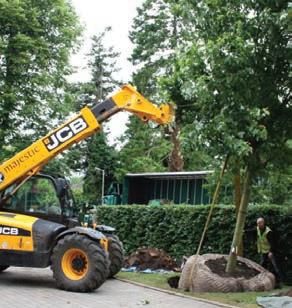
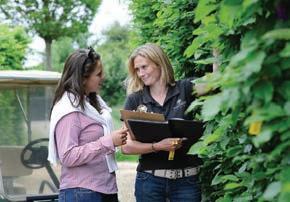
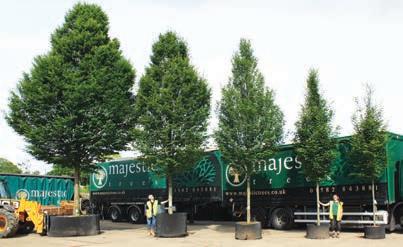
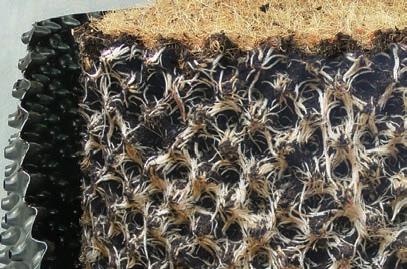
Serving as association chair can propel you into the limelight –so, what’s it like when your term comes to an end?
WORDS: NINA MASON
It’s been over a month since Tess Johnstone handed over the reins to the new chair for the British Association of Landscape Industries (BALI), and she’s somewhat difficult to pin down.
The managing director of Johnstone Landscapes is still in the process of moving over 150 miles down the road, having decided to relocate to Cornwall this year, so she understandably has a lot on her plate. It’s part of the reason she decided, having spent 18 months as chair, not to take the typical step of becoming ‘immediate past chair’ over the next two years.
She calls the role “the perfect tool to step down,” though. “It was my decision to not take that role because the timing was just not right for me and my family asked me to be realistic about my commitments – for once, I listened!
“But the past chair role is the best way to carry on with a significant and meaningful contribution – and to take

prominent, very intense role, it does have an impact on you personally, because you’re not really needed anymore, and your identity becomes sort of wrapped up with the presidency,” says Jane Findlay, immediate past chair of the Landscape Institute.
“For a lot of us, when we’re in the position to be able to participate in an organisation, we have a bit more time on our hands and have generally stood back from the business to some degree. So, for some, there can be a loss of identity and some personal loss. I can’t say I felt that enormously, but I know it has impacted on other people who have had to step back and suddenly find that they’re not in the limelight anymore.”
The past chair role is the best way to carry on with a significant and meaningful contribution – and to take the sting out of leaving the limelight
Tess Johnstone, owner of Johnstone Landscapes
There’s a “sense of diminished influence” when you’re no longer at the forefront of decision making and representing your industry publicly, she adds. “When you take on the role, you have to be mindful that is going to happen.”
Her predecessor Adam White handed over the reins during lockdown, which meant her presidency was arguably even more intense, with associations being in high demand during that time. “It really is full on because, at the LI, you’re president, chair of the board and also chair of the advisory council. So, whilst you have the ambassadorial role with 6,000 members who come to you if they have an issue because they see you as their representative, you’ve also got the governance going on in the background, making sure that the board of trustees is working efficiently and collaborating with the staff team and everything. So, I found it to be a much bigger role than I originally expected and more time consuming.”
At the Landscape Institute, a president will typically spend four years on the board, spending one year as president elect, two years as president, followed by one year as immediate past president. So, there’s a year where the current president overlaps with their predecessor, which is a “nice balance”. But the vice chair role could perhaps be better utilised, suggests Findlay. “There could be more sharing of responsibilities because it’s almost too much, what is expected of you as president; this could potentially put off some candidates because it’s quite an onerous role.”
Johnstone's 18-month term at BALI is somewhat unusual for the association. The chair would typically spend two years in the role, having spent two years as vice-chair. But her tenure began sooner than expected when her predecessor had to step down early due to ill health.
“The board probably wasn’t ready for me nor me ready for the role...I had felt like I was trying to support getting the board ready for the next bit; because my tenure was short, it was trickier to claim any great win and I felt my win was ramping a few things up a little. Just from the
A lot of people come onto the board when their business is in a sensible place and position to be able to do that. It’s about choosing the right time, rather than glory hunting
Wayne Grills. CEO, BALI
energy in the room at this year’s AGM, I can tell it’s going to be an exciting chapter, and I am happy that I helped to get that energy to build.”
She calls new chair Adrian Wickham a “natural” and says she was pleased to hand over the baton. Johnstone will also continue to be involved in BALI, sitting on the South West regional committee. But under usual circumstances, she would have served as immediate past chair for two years, during the new chair’s tenure.

“This is a really important path, because it’s all about consistency,” says BALI’s CEO, Wayne Grills. “Having that change in chair is great, for a different perspective, but it's also great to have that consistency of the board with someone who has been in the post for two years.”
It’s a big commitment though, says Grills.
The typical period is six years, starting from becoming vice chair, when they’ll learn the ropes and understand how the board operates.
This usually transitions into taking on the role of chair, when it “hots up” in terms of time commitment – and that’s not easy when the role is as a volunteer.
“There is a time burden. Tessa, for instance, was concerned when she stepped in early as to whether her business was at the right point to be able to take that on. She did a great job in terms of then making that commitment and supporting me in my role as well. But it’s the same as immediate past chair
– they are still contributing and still have a role. They might not get the same event and award invitations as the chair, but they’re probably quite glad of that, to take a step back and refocus on their business.”
And people don’t become chairs for the limelight, says Grills. “I think they do it because they want to give back. A lot of people come onto the board when their business is in a sensible place and position to be able to do that. It’s about choosing the right time, rather than glory hunting.”
BALI’s board – the chair, vice chair, immediate past chair, treasurer and Grills – is at the tail end of undergoing some governance changes. “We’ve moved the board away from what could have been described as an interest in the operational activities of the association to more of a strategic input and overview.” This will avoid getting too hooked up on how many visitors there are to BALI’s website, for instance, and will instead focus on delivering the four pillars set out in its strategy two years ago.
Findlay, who built a strong relationship with Wei Yang, the president of the Royal Town Planning Institute around the same time. “We were both lockdown presidents together, so we had a good connection. Organisations can lose that as the next person comes along and has different interests or specialisms; so, there is a role for a past president.”
As you step down from that very prominent, very intense role, it does have an impact on you personally
It’s a balance between this and needing to refresh the board and the committees, but past presidents are still valuable to the association, says Findlay – in particular, for their specialisms. For instance, she was invited to be chair of the LI’s governance committee having been part of the institute’s organisational changes, which frees up the president to focus on her own advocacy. Findlay was also recently asked to help host a masterclass in November on healthcare facilities, as her expertise is on health and wellbeing and people’s interaction with nature.
Jane Findlay, immediate past chair of the Landscape Institute
The spots on the board are seemingly in demand too. There were 14 nominations for the five vacant spaces this year, and twice that had shown interest initially. “We’ve always been oversubscribed for the places that we’ve got available, but usually it’s one or two. It’s almost testament to what we’ve been doing at BALI for the last few years, with 28 people coming forward to say they were interested to hear more about the roles to then 14 people being happy to be nominated and go through voting.”
There’s a rotation process each year where a third of the board has to step down and then be re-elected, and those who have been on the board for 10 years go through this each year thereafter. “So, there’s a healthy process to ensure it’s not the same people for two or three decades – but it’s good to have those who have served for long stints on the board as well as fresh blood, as it were,” says Grills.
Continuity helps to maintain relationships built up during tenures too. “You make personal connections with other presidents and so on,” says
There’s no immediate past chair role at the Society of Garden Designers, for which chairs are in the role for three years. But the support when transitioning between chairs seems to come naturally, explains Lynne Marcus, who is speaking from experience. She took up the role as chair in September 2020, taking over from Sarah Morgan, who now reports to council as the SGD’s accreditation panel co-chair and who Marcus would regularly consult.
“It’s important to have a handover period where the past chair can continue to be involved and advise – and we have that.’
For the last year of her tenure, she shared the role with its new chair, Andrew Duff. Whilst co-chairing is “very unusual”, Marcus and Duff – as well as John Wyer, who took on the role of vice chair and treasurer – were “able to work closely together to achieve more”, and Marcus continues to sit on the council as chair of awards.
“It’s your choice as to whether you remain on the council or want to take on another role; I will have been on the council for six years come February. I was appointed chair of awards when I first joined council, before I was chair of the SGD, and I stayed even during my tenure as chair. To me, it was something that I’d worked closely on, and I was able to do both jobs, which was great. But everyone on the council is a garden designer, so we all have day jobs, and it’s very demanding to run a business at the same time.”
Marcus saw it as a “responsibility and an honour” to be chair all the same – she didn't see it as being in the limelight. “You’re able to do things that aren’t necessarily directly related to your business but are related to the business that you’re in.” Take the ‘Say No to Artificial Grass’ campaign spearheaded by Marcus during her tenure.
“I haven’t struggled to not be chair, though, because I’m still very much involved with the awards and with the overall decision making at the SGD as a member of the council; I think I would have found it hard if I wasn’t doing that, if I’d just stopped and carried on with my own business.”
There’s a limit to how much presidents or chairs should continue to be involved though, warns Findlay. “Take the LI, for instance; things have changed so much in three or four years, and in the next three or four years it’s going to change again, because you respond to political change and membership change and so on. What I can contribute might not be so relevant in three- or four years’ time.
“Everybody deserves their turn in the spotlight, if you like, and I don’t think past presidents hanging around
drawing attention to themselves is always the best for the organisation, though mentoring and advocacy are still a good thing.
It’s important to have a handover period where the past chair can continue to be involved and advise – and we have that
Lynne Marcus, Chair of awards, SGD
“Perhaps we could do more as an institute to help mentor, encourage and guide emerging leaders, and not wait until they’re towards the end of their careers before they stand for elected officer roles. More could be done to make the role of president more attractive to younger professionals too, rather than relying on those who can step out of their businesses for a while, because it’s such a big ask for somebody who is running their business. You can’t run a business or a team or deliver on a project deadline when there’s a lot going on in the organisation.”
No organisation gets it right all the time, says Findlay. “When you have changes on the board, it’s difficult to keep it going. And when you’ve given a lot of time voluntarily, you want to feel that you’re building and leaving a legacy –that's the piece that we all feel quite passionate about, that we’ve made a difference.”
And that’s understandably difficult to step away from.




Strulch was developed at Leeds University by Dr Geoff Whiteley. It is made from wheat straw, is an earthy brown colour has a neutral pH and lasts on the surface for up to two years.
Strulch stops weeds germinating by blocking light, retains moisture in the soil and the added minerals and texture deters slugs and snails.
13.5kg bags of Strulch are available on pallets of 12, 25, 40 and 48 bags.
Delivered around the UK within 4 working days.
Trade discounts available
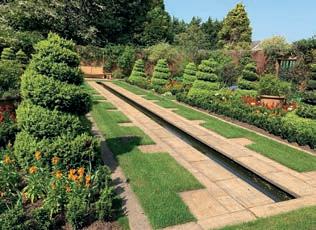

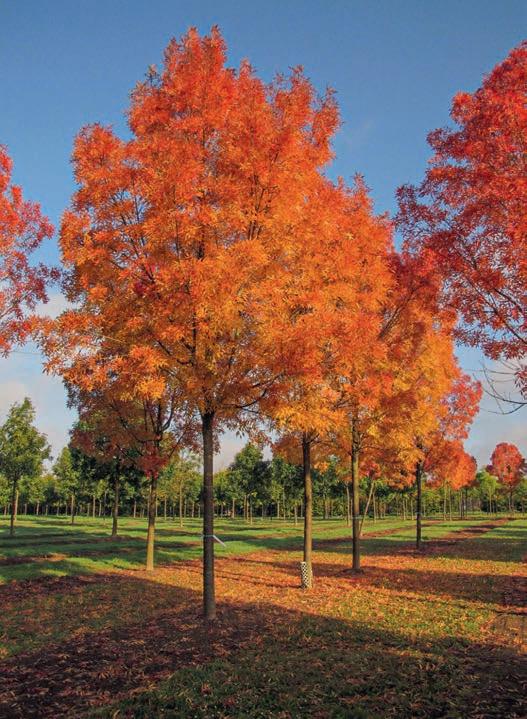
Autumn provides us with a spectacle of colours, scents, shapes and textures that have, during the summer months, remained hidden – until now. The buds have sealed, and the trees are ready to be delivered to your door. Our fields are stocked with specimen trees, solitary shrubs and conifers, multi-stems and a great variety of shaped and pre-shaped plants. With almost 1,500 acres in production and thousands of species and varieties, we are among the largest in our sector. We look forward to working with you very soon. Boom & Bonheur – because trees give life and bring happiness



Based upon the legendary CS-2511TES top handle saw, the 25cc CS-2511WES offers an unprecedented power-to-weight ratio, wrapped up in a compact, rearhandle form factor.
It is a 100% professional grade saw in a tiny package, making it perfect for carving, hedge laying, or trimming applications where space and obstacles limit access and manoeuvrability.
Find out more:
Stop Jack Frost nipping at your nose this winter with the help of protective warmers, offering versatility and comfort

er material: A robust combination of microfibre and cut/abrasion resistant material.
composite toe cap: anatomically formed and made of fibre-reinforced plastic. extended inner lining: waterproof and highly breathable.
slip sole configuration: Good grip on different terrains. Vario wide fit system: Internal width can be individually adjusted by three different insoles. haix.co.uk
MAKITA
DCV202Z 18V
LXT Heated Vest
Price £180 (incl. VAT)
• Three heat zones –back, chest, and neck.
• Windproof and water repellent for use in all weather conditions.
• Three heat settings.
• 36-hour run time at low heat level with a 6.0Ah battery.
• Integrated USB port to charge mobile devices. makitauk.com

STIHL FUNCTION
ThermoGrip
Gloves
Price £8.60
• Durable coldprotection gloves with a thick latex palm coating.
• Comfortable to wear thanks to the elasticated cuff and snug fit.

• Low temperature protection allows long periods of work.
• Thick insulation and excellent grip.
• Perfect for working with wood in cold, wet and snowy conditions.
stihl.co.uk
HAIX
Ramble GTX
Price From £204.90 (incl. VAT)
• Slip -resistant Vibram sole: optimal stability at any height and on any terrain.
• Waterproof GORE-TEX membrane: Protection against moisture while maintaining breathability.
• Robust split leather and tear-resistant textile: durability and flexibility combined.
• Perfect fit: ergonomic design for superior comfort.
• Flat eyelets: safe climbing without snagging. haix.co.uk





maintaining a space or stripping it back, these products can help get your site looking ready to go.

525iB Mark II
RRP £499 incl. VAT (without battery and charger)
• Clear large areas faster with the power of two EGO batteries.
• Designed with a larger motor for 190mph air speeds and 26N push force.
• Peak PowerTM Technology for longer run times and greater blowing force.
• Ergonomic handles with variable speed trigger and trigger lock.
• Delivers power equivalent to a 60cc petrol engine. egopowerplus.co.uk

• 11 N Blowing force.
• 2.5kg Weight (excl. battery).
• 36V Battery Voltage.
• Continuous boost power.
• Cruise control.
• Weatherproof (IPX4).
husqvarna.com/uk

• World’s powerful handheld battery-powered blower throughout the full battery charge.
• Weighing 2.7kg, the BGA 250 is lightweight and easy to manoeuvre.
• Offers a high blowing output of 26 newtons, 11 newtons higher than the BGA 86 handheld battery-powered blower.
• Simple speed level and cruise controls for efficient energy management and longer working times.
• Boost mode can provide maximum power for the toughest clearing jobs. stihl.co.uk/en
• Lightweight design for single handed operation and reduced user fatigue.
• Boost Mode increases airflow when extra power is required.
• Low noise levels for use in public places and residential areas.
• 3-stage telescopic nozzle to extend reach and cover large areas.
• Cruise control enables continuous operation at constant speed. makitauk.com


Becoming the first trade nursery in the UK to be granted Control Point status upholds our commitment to continuous improvement.
With border delays minimised, expert plant handling ensured and cost efficiency streamlined, it transforms the Provender journey from exceptional to extraordinary
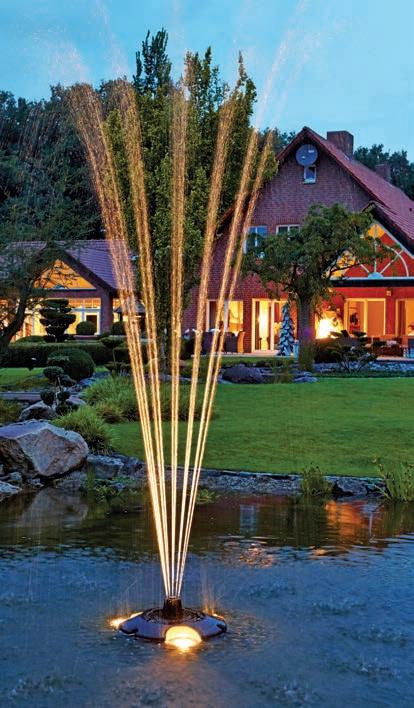
Add a stunning water display
What better way to complete a project than by adding the sound of moving water? Now it’s even easier to do this with OASE.
OASE’s PondJet Eco Floating Fountain can create displays up to 3m high. With Dynamic Function Control a variety of fountain shows are possible.
Only requiring a minimum water depth of 0.5m the fountain can be installed in a wide variety of locations and is perfect for both permanent and temporary installation.
White and RGB lights are available to ensure the feature creates wonder once night falls.
Discover more at oase.com



MS 500i W 25” (heated handles)
Price £1,774
• High performance professional chainsaw with electronic fuel injection
• Heated handle versions available for comfortable winter working
• 6.8hp power output and high torque for faster working
• Excellent power-to-weight ratio and compact design
• Easy starting thanks to purger and decompression valve stihl.co.uk
542i XP G
Price RRP £799 (incl. VAT)

CS-2511WES
Price From £499 (incl. VAT)
• 25cc two-stroke engine
• Weighs just 2.6kg
• ES Easy Starting system
• Comes with 30cm (12”) bar and chain or 25cm (10”) carving bar echo-tools.co.uk

DUC150Z 18V LXT
Brushless 150mm
Pruning Saw
Price £180 (incl. VAT)
• Lightweight and compact, ideal for tree pruning and limbing applications
• Tool-less chain tensioner for easy saw chain adjustment
• Automatic lubrication minimises chance of chain seizure and excessive wear
• Electric brake for maximum productivity and increased operator safety
• Brushless motor for extended runtimes and reduced maintenance. makitauk.com
George Trott sets out how to maintain trees ahead of stormier seasons
• Regular inspections


Mature trees should undergo periodic inspections by an arboricultural consultant to identify signs of decay, structural weaknesses, or pathogens like fungi. Early detection of these issues is crucial for preventing catastrophic failures during storms. Addressing problems before winter ensures that trees are in the best possible condition to withstand severe weather.
• Identifying potential targets
It’s important to assess the area around mature trees to identify potential targets such as buildings, roads, or pedestrian routes that could be harmed if a tree or branch falls. Prioritising trees based on the risks they pose allows for focused attention on those most in need. Avoiding unnecessary pruning is also key, as each cut can expose trees to pathogens and sap their energy.
• Managing or moving targets
When trees present risks, consider managing or relocating potential targets instead of opting for tree surgery. Moving benches, signage, or rerouting pedestrian routes can mitigate risks without harming the tree. This approach preserves tree health and structure while being cost-effective, reducing the need for drastic pruning or removal, and helping maintain the tree’s longevity.
• Implementing remedial works

Any necessary remedial work, such as pruning dead or weak branches or installing structural supports, should be completed well before winter. These measures reduce the risk of branches breaking or trees toppling during storms, thereby strengthening the tree’s overall health and resilience.
Winter can be harsh to trees, but with proactive management, risks can be minimised. Here are essential tips for managing both mature and newly planted trees to ensure they remain healthy and resilient during harsh winter conditions.
• Preventing abrasion damage
Newly planted trees are particularly vulnerable to abrasion damage from tight staking systems or protective guards. Regular checks and adjustments prevent wounds on the trunk, which can become entry points for pests and diseases. Proper care ensures young trees develop into healthy, resilient structures capable of withstanding storms.
• Topping up mulch
A fresh layer of mulch around the base of young trees helps retain moisture, regulate soil temperature, and protect roots from extreme cold. Mulching supports root health, providing a strong foundation that enhances the tree’s ability to withstand adverse weather and thrive in the long term.
• Removing redundant supports
As young trees establish, it’s important to remove unnecessary support systems. Staking systems left in place too long can restrict growth and cause damage. Removing these supports allows the tree to develop natural strength and flexibility, promoting a healthier structure better suited to enduring storm conditions.

• Protecting from salinisation
In urban areas, newly planted trees may face risks from soil salinisation due to runoff from salt bins and gritted roads. This can harm young roots and hinder water and nutrient absorption. Using barriers or strategically placing trees away from such runoff reduces exposure, protecting soil quality and ensuring healthy establishment.
Proactive tree management is essential for preparing trees for winter storms. Regular inspections, careful management of potential risks, and proper care of both mature and young trees can significantly reduce the likelihood of winter damage. By taking these steps, those responsible for trees can protect both public safety and property while ensuring the long-term health and resilience of their trees.

George Trott, an experienced arboricultural consultant and founder of G Trott Tree Consultancy, brings a wealth of knowledge in tree risk management and health assessments. With advanced certifications and a passion for sustainable tree care, Trott provides comprehensive arboricultural solutions throughout the South of England. To discover more, visit his website or connect with him on LinkedIn. gtrotttreeconsultancy.co.uk


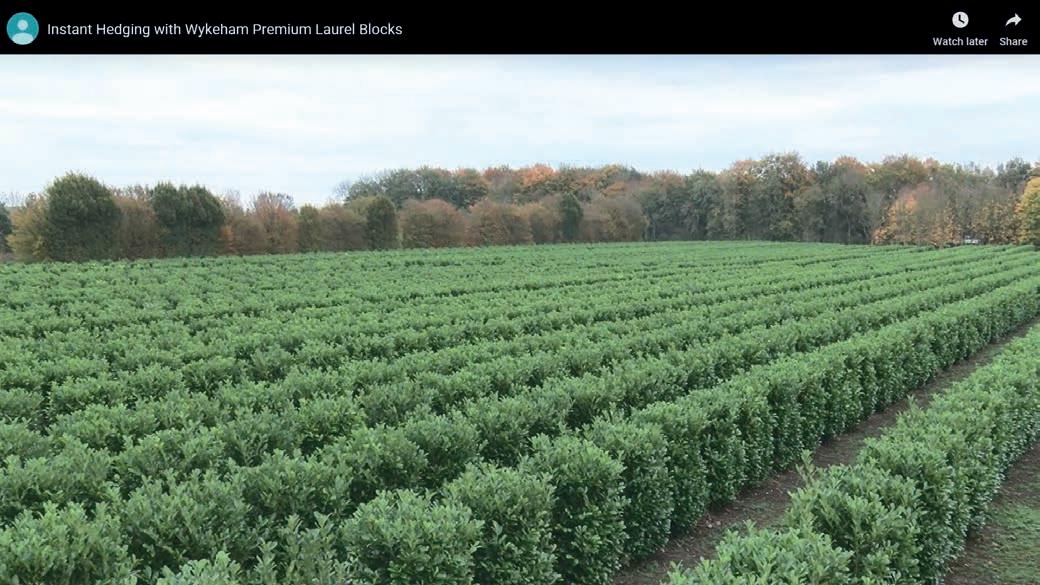
enquiries@wykeham.co.uk



Having recently stepped down as BALI’s chair, Tess Johnstone encourages more women to put themselves forward for leadership roles
The year 1990 saw the first female chair of the British Association of Landscape Industries (BALI), Jean Brent of Dulford Nurseries, step into the role. Then in 1999, Rosemary Latter filled the position.
I joined the board in 2019 and, some 22 years after the last female chair held office and completing a run of 12 consecutive chairmen, I took on the chair position, recently passing on the baton to Adrian Wickham of Glendale.
Being chair wasn’t a role I had aspired to originally but, once I had immersed myself in the ED&I agenda for BALI and found all around the table to be immensely friendly, helpful and keen to share information, I started to think, “Why not me?” and challenging myself to not even entertain imposter syndrome. I hope we see more women coming through to sit on the board and ensuring that we balance things out a little. There are plenty of women in the industry and many who are perhaps yet to explore contributing outside of their own businesses or roles, in ways that could really make it easier for women in the future to join landscaping and horticulture and for them to make meaningful contributions.
having to keep to time! Your role is also to ensure consensus is achieved – not everyone behaves like a grown-up around a table, and it is imperative that posturing is not entertained should it raise its head.
My five years on the board at BALI have taught me a lot. And I hope that I have, in some small way, contributed to BALI’s story. CEO Wayne Grills was able to see that what I wanted to support was not always the easy win items; they were long haul and Wayne was consistently supportive and keen to invest time and strategically thought-through funds in areas that wouldn’t necessarily reap those instantly gratifying PR moments.
There are many businesses where women are just as welcome in those lead
positions,
and we need to apply for these roles if we are to continue to make progress
I feel confident that having just had the 2024 AGM – where we faced a packed room – then all of us listening to Lucy Fisher, operations director from idverde, speaking so eloquently and confidently and holding the audience’s attention as she led them through her sustainability journey, to electing five new board members (one female) from the largest ever number of board applicants, that the industry is in good shape going forward and is becoming a more natural fit for women to not only be part of but to contribute meaningfully.
Rhetoric is branded and exchanged in all industries. Formidable is a term which is regularly assigned to women who supposedly dare to ignore the white noise and head to the top position at the table. Shift that paradigm – one does not need to be formidable; one just needs to possess the qualities to lead a team. There are many businesses where women are just as welcome in those lead positions, and we need to apply for these roles if we are to continue to make progress.
When undertaking a place on a board in any industry, one needs to build relationships – it is not enough just to turn up and then walk away until the next meeting. As chair, listen to everyone at the table before you have your say. Be the last to speak – no mean feat whilst
If you have ever thought about serving on a board, get involved at a grass roots level – join a regional committee and then make that application. You deserve a place at the table.

Tess Johnstone is joint owner and new business lead of Johnstone Landscapes Ltd, based in Wiltshire and now with a new set up in South Cornwall, serving the two areas in high-end residential landscaping and maintenance. Johnstone is passionate about ensuring more people feel able to join the industry and works with BALI in this area.
johnstonelandscapes.co.uk
Replacing wooden decking with bamboo provided a durable solution by Castle Composites
The client had an existing wooden deck that had been in place for over a decade. The deck had originally been installed as a gathering space for family activities and outdoor entertainment. However, over the years, the wooden decking had deteriorated due to exposure to the elements, leading the client to seek an alternative that would not only restore the functionality and aesthetics of their outdoor space but also provide a more sustainable and long-lasting solution.

The wooden deck, constructed from traditional pressure-treated timber, had several issues that made it less desirable over time:
1. Weathering and decay
The wood had become weathered, with significant cracking, warping, and splintering. Despite regular maintenance, including staining and sealing, the wood showed signs of rot, particularly in shaded and moisture-prone areas.
2. Maintenance requirements
Wooden decking requires ongoing maintenance, including six- to 12-month staining and frequent repairs.
Traditional wooden decking contributes to deforestation and can be less environmentally friendly, especially if the wood is not sourced from sustainably managed forests.
4. Pest issues
The client experienced problems with termites and other woodboring insects, which further compromised the integrity of the decking.
After researching various decking materials, the Smiths decided to replace their old wooden deck with bamboo, which offered several advantages:
1. Durability and longevity
Bamboo decking is highly resistant to weathering, with strong tensile strength, making it less likely to warp, crack, or splinter, even in extreme conditions.
2. Low maintenance
Bamboo decking requires minimal maintenance compared to wood, no need for regular sealing or staining (every three to five years), and its natural pest resistance eliminates the need for chemical treatments.
3. Sustainability
Bamboo is a highly sustainable building material, growing much faster than traditional wood, with some species maturing in three to five years. It can also be harvested
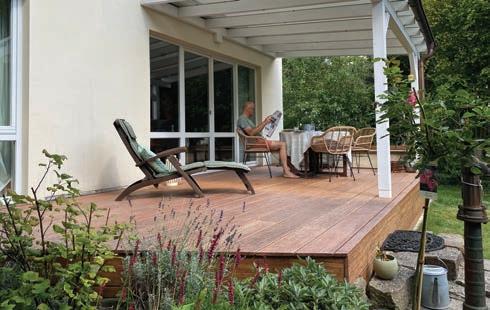
without killing the plant, enabling quick regeneration.
4. Aesthetic appeal
Bamboo decking provides a modern, sleek look that enhances outdoor aesthetics, with its uniform appearance and rich color options appealing to the client.
5. Repairability
Unlike composite decking, bamboo decking can be repaired if issues arise, with options such as sanding, resealing or restaining. It can even be stained in a different colour to change the aesthetics.

The project began with the removal of the old wooden decking, followed by inspecting and preparing the structure. New bamboo decking was installed on bamboo joists, with planks fitting seamlessly. The client chose a natural finish that complements the outdoor space. The transition to bamboo decking was successful, providing a durable, low-maintenance solution that enhances the deck’s appearance and aligns with the client’s sustainability values.
Client feedback
The customer and contractor were pleased with the outcome of the project. They noted several key benefits of their new bamboo decking:
• Reduced maintenance: "It's amazing how little we have to worry about maintaining the deck . Less staining and sealing —we just enjoy it!"
• Aesthetics: "The bamboo decking looks fantastic and revitalised our deck. We've received compliments from friends and neighbours."
• Comfort and safety: "The deck feels smoother, underfoot, and no more worries about splinters. It’s a great improvement, especially for the kids."
• Sustainability: "We feel good knowing that we've made an environmentally friendly choice. The bamboo is not only beautiful but also sustainable, which was important to us."

AFTER

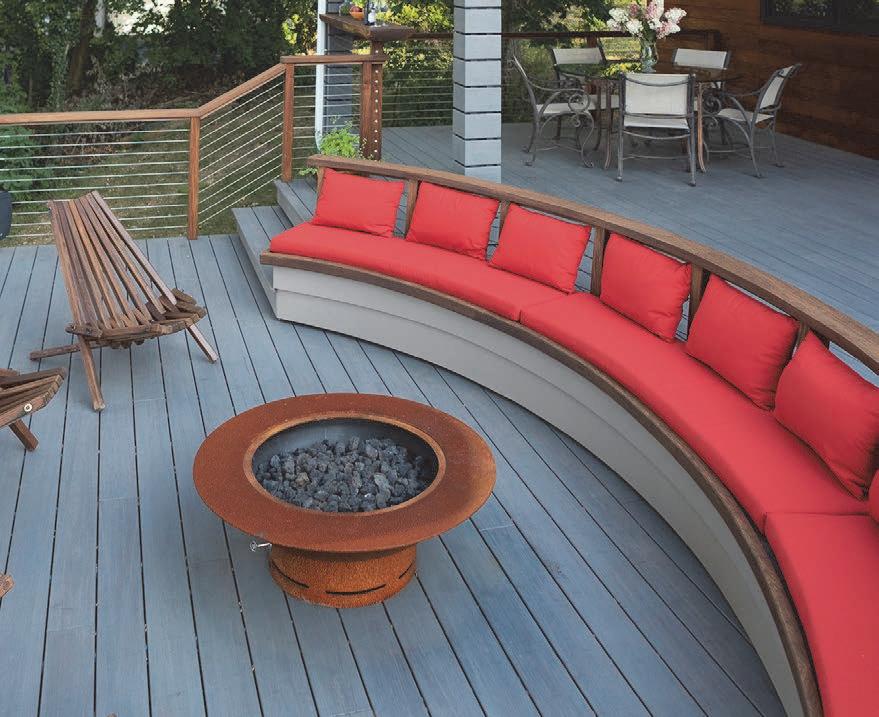

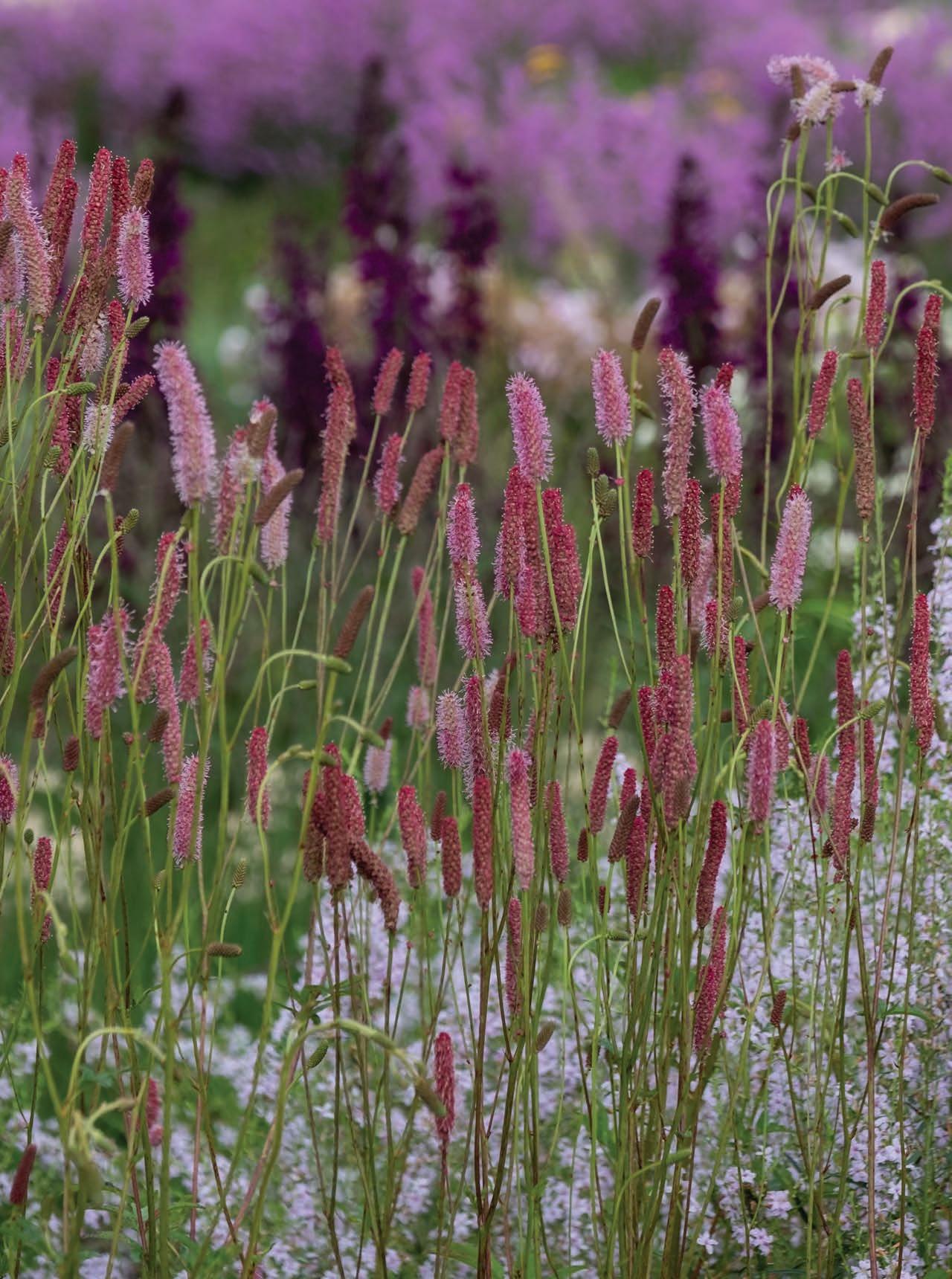
Gardens can be important test beds for wider landscapes, suggests Noel Kingsbury
The boundary between 'garden' and 'landscape' is never clear. To those outside the profession, the distinction is often meaningless; for example, landscape professionals are generally assumed to know about plants and gardening. Many landscape people, however, resent the connection with gardens. I have been told frequently that landscape professionals will not look at our education website because it's called 'Garden Masterclass'. Why are we caught up in this linguistic and categorical mess?
Taking planting design seriously is at the core of achieving a better mutual understanding between landscape design and management and horticulture
Landscape architects have historically felt somewhat inferior to architects, a profession not noted for its modesty. And in turn, landscape architects have frequently tended to look down on horticulturists. Much has to do with the relatively low status of gardening and landscape management. Too often seen as simply a hobby activity, a pastime for older relatives with their rows of cabbages and hanging baskets of begonias, gardening is clearly something of an embarrassment. Meanwhile the horticultural activities involved in most landscape maintenance are low paid and low status – and in any case, mowing grass and keeping down shrubs with hedge trimmers is not work that attracts highflyers. The level of knowledge and skill involved in horticulture is rarely appreciated.

There is a trap here: clients will not pay for more sophisticated landscaping because they worry about maintenance costs, so much planting continues to be unadventurous and designed to need as little care as possible. Much landscape planting is, as a result, uninspiring, and gives the profession a poor public image. The result is a catch-22 where nothing moves forward.
In Britain, we make a professional distinction between garden designers and landscape architects, which arguably does little to heal the rift between the two. But garden design can act as landscape's R&D department. An example here might be the work of Piet Oudolf, a garden designer whose work is more usually on the landscape scale. Prominent commissions for public spaces and the attention of the contemporary art world (another professional group not noted for humility) built his reputation and, with it, that of planting design – and hopefully landscape design more generally. Part of the 'Oudolf effect' is the far greater diversity of planting we are now seeing, often using perennials and grasses, in public greenspace and other landscape-scale projects. We can only hope that this is the start of a process of evolution and not just a one-off. The biggest change in private gardening over the last 30 years has been the growth in awareness of gardens as sites for nature.
'Wildlife gardening' has evolved into an increasingly sophisticated appreciation of just how much gardens can be great places for nature. There is a lot going on here which can inform work in the landscape sphere. Increasingly there is a recognition that the green infrastructure of urban areas can be an important biodiversity habitat.
Taking planting design seriously is at the core of achieving a better mutual understanding between landscape design and management and horticulture. Landscape professionals need to recognise that their training rarely gives them much plant knowledge, and they rarely have the time (or interest) to pursue this as their career develops. Design and construction projects that involve horticulturists in the design of planting and, crucially, consider the implications of ongoing management at an early stage are far more likely to succeed. Gardens have a role here – laboratories for evaluating plants, and they deserve more attention and recognition.
Planting design itself is evolving, increasingly willing to blur the boundaries between spontaneous growth and design, a process largely driven by a biodiversity agenda.

Noel Kingsbury is a freelance designer, writer and researcher who has long promoted naturalistic planting design. He also runs the education website gardenmasterclass.org. noelkingsbury.com

We need to be more strategic in our approach, encourages Lewis Normand
As I write, the sun is streaming in through my home office windows and there are beautiful, warm and clear blue skies outside. The weather for much of this year has been unpredictable. While southern England had a soaking wet spring, it was quite dry up here in central Scotland. Through the highs of summer, though, it was far cooler than I had hoped for, and I will admit to having been a tad jealous of the glorious sunny weather we saw far more intermittently than I would have liked. Like most people across the UK, my vegetables were and remain disappointing, and it has been a struggle this year to get many delicious delights from the garden.
The late sun and warmth are an illicit joy and something I hope will stay a while, but it has got me thinking (again) about climate change and weather patterns. Specifically, I have been thinking about long-term plant survival. While the highest temperature of 35°C+ brings me no joy – and I recall the sapping discomfort of working in Dubai and in Tuscany, Italy at 48°C – there is a place in central Scotland for more of the 25-30°C glorious scorchers!
As we see summer temperatures in central Europe breaking 40°C with some regularity now and a constantly increasing summer high temperature across southern and central England, we must prepare for long-term change.
We know that many of our native tree species cannot tolerate the very high summer heat and mild yet very wet winters which are becoming a more predictable pattern of UK climate
If, as the proverb goes, ‘Wise men plant trees under whose shade they know they shall never sit’, then it is very wise people who know what trees to plant to ensure they grow big enough to cast shade under which future generations may sit. We know that many of our native tree species cannot tolerate the very high summer heat and mild yet very wet winters which are becoming a more predictable pattern of UK climate. Early thoughts were to select Mediterranean climate-friendly tree species, like Albizia, Jacaranda, Ailanthus and others. These would do well with the heat but, somewhat obviously, they fail to thrive in cool wet winters we are having.
In truth, very few trees like these two extremes, with many preferring high summer temperatures while being tolerant of very cold, but drier winters. So, this takes me back to my title question,
should we bother to plant trees? It is a glib question and of course the answer is, yes, we should plant trees. The reality of the yes, however, is that we need to develop better strategies to determine what to plant, where to plant them and how to grow trees for our future.
For some years now, the Westminster and devolved governments have set and largely failed to meet tree planting targets to offset carbon emissions as we aim to move towards net zero emissions. These trees are typically forestry trees or native and non-native conifers. A broader range of mixed deciduous tree planting is happening in the UK, but typically through the work of organisations like the Woodland Trust, Forestry England, Trees for Cities, Trees for Life, the National Trust and Scottish governmental division Forestry and Land Scotland. I would never decry or devalue the great work being done here, just as I wouldn’t bemoan anyone planting a tree or woodland in their own
land – all these plantings benefit the local and wider environment and are a good thing for people and wildlife.
We must push for a nature-led approach to design and for the benefit to the environment to be at the forefront of all developments
What I do want to see is more strategic thinking and plant trialling of potential future species for trees that we should be looking to integrate into our plantings to ensure longevity in a changing climate. In August, Dundee Botanic Gardens hosted an international conference called Urban Releaf. Sadly, I couldn’t take up my invite due to other commitments, but I will be supporting this initiative to look at nature-led solutions to design problems.
For anyone in the landscape industry, a nature-led solution to design problems will likely seem like the obvious choice, but you will also most probably recognise how often horticulture is the last thought and value engineered element of a new space. Here, we see landscape being the cheapened and devalued element to make savings on at the end of the process. We must push for a nature-led approach to design
and for the benefit to the environment to be at the forefront of all developments, be it residential, commercial, industrial or urban planning.
We must also look to develop data-led planting strategies formed from good research on what plants will suit our changing climate in 10, 20, even 100 years. We need to plant trial woodlands of native and non-native species on several sites across the UK to assess what we should be looking to plant for long-term success and provide that cool shade for our descendants.
I encourage you to look up the Urban Releaf Project. It is starting this vital work and will thrive on engagement and research data to produce meaningful results and direct strategy going forward.

Lewis Normand has worked in a wide variety of roles within horticulture over a 20-year career. He has lectured on garden design and horticulture, and designed gardens in the UK, Europe and the Middle East. Since 2011, Lewis has focused on nursery sales, now working as sales manager at Bernhard’s Nurseries, and has helped to launch a number of new plants into the UK plant market. He is a specialist supplier to show gardens, supplying more than 100 gardens at major shows.
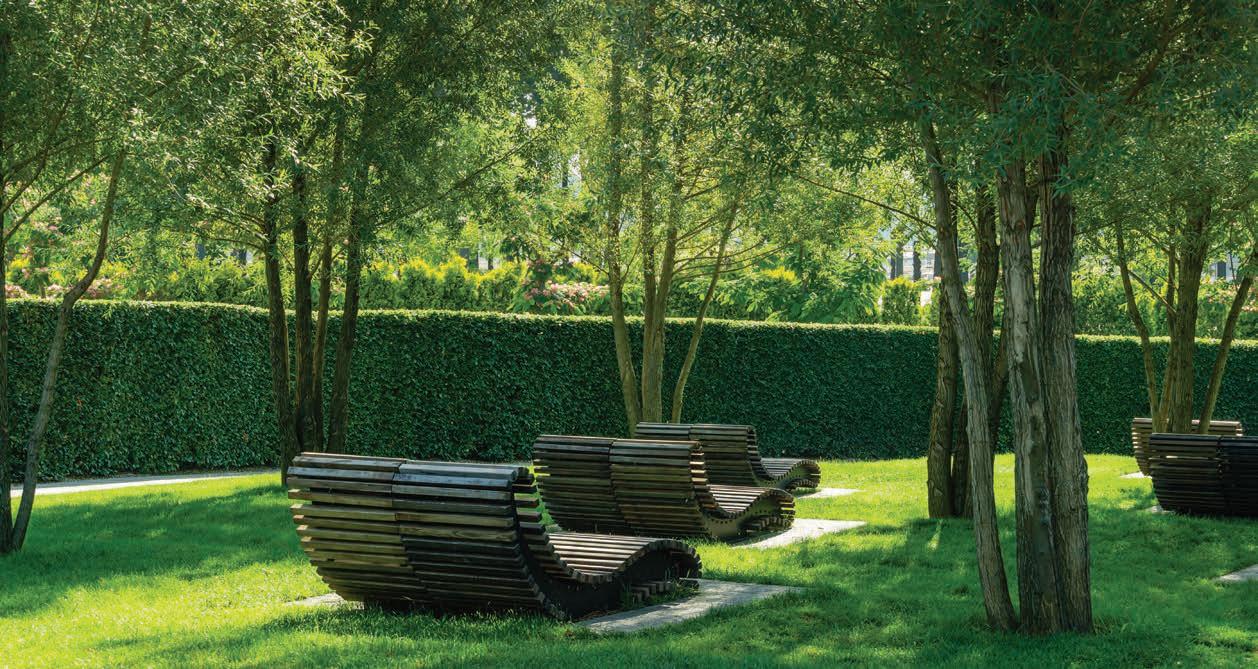



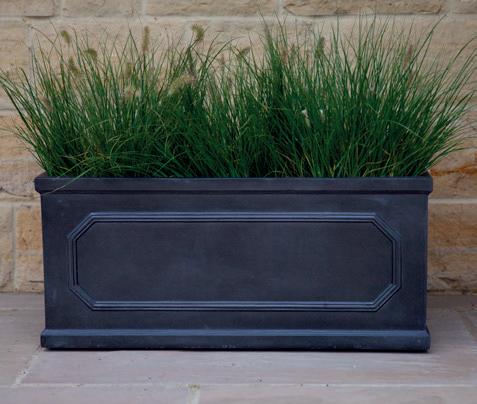
Known for cultivating high-quality, diverse tree species, Ebben has played a vital role in transforming urban and green spaces across Europe. In cooperation with landscape architects, urban planners, green contractors and arborists, the team realises all sorts of projects throughout Europe. From public parks to private gardens and large-scale landscaping projects, the nursery focuses on environmental sustainability, offering plants big and small that contribute to biodiversity, air quality, and aesthetic appeal.
By attending SALTEX, Ebben aims to connect with professionals in landscape

architecture, park maintenance, and sports ground management. With the rising demand for greener urban environments, the company’s sustainable approach resonates well with modern landscaping needs.
By constantly looking closely at nature – how it develops and sustains itself – the 'know-how to
grow' of team Ebben grows. Their professionals advise on application, biodiversity, ecological value, colour, shape and texture. For the nursery, 'know-how to grow' also means thinking and looking beyond
growing and delivering trees. Climate change, more extreme weather, heavy rainfall or prolonged dry periods, these are issues that call for a different design of our living environment and this is what Ebben Trees is working on every day.
Attendees will have the opportunity to learn about Ebben's unique methods and the team will also provide expert guidance on choosing the right tree species to optimise park and garden spaces. Come and visit them at stand L50. ebben.co.uk

Neil Parslow talks us through why good landscape lighting should not be included in the ordinance of Dark Skies
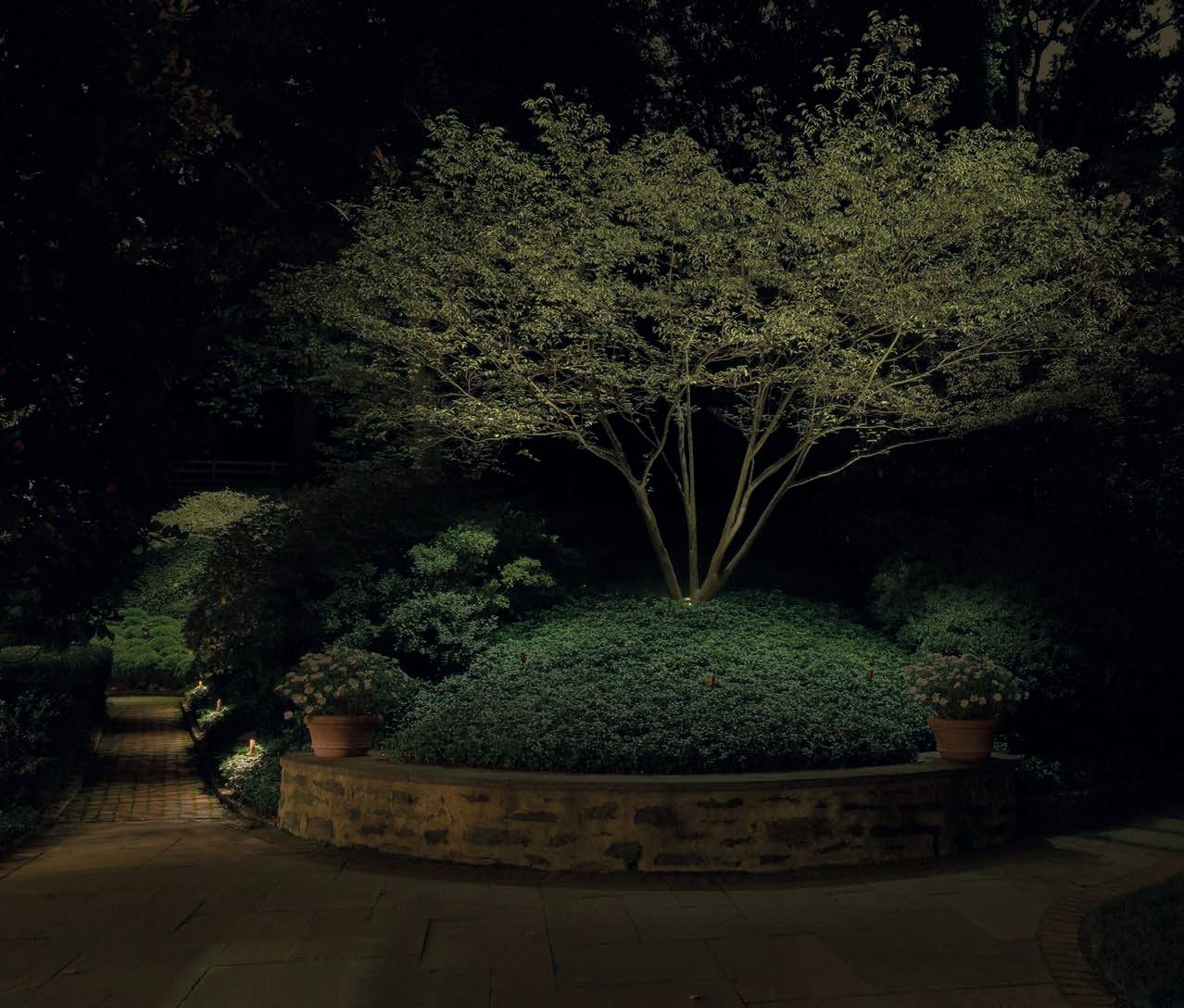
Light pollution is an ever-growing problem in cities, towns and rural locations around the world.
Commercial and domestic lighting-class LEDs have been in use now for a little over 15 years, with lamp and chip manufacturers continually producing more efficient products. This is partly to satisfy government requirements to reduce fossil fuel consumption, and new advancements in technology. While this is widely seen as making progress from the use of incandescent, there is the under-publicised negative issue that certain LED products are having on our health – and the environment.
and reduce the harmful effects of light pollution on humans and wildlife.
The main culprits of sky glow and light pollution are streetlights, electronic advertising boards, car parks, sports lighting, commercial greenhouses and factories, with many other sectors also polluting our starry night skies.
Streetlights (as an example) use colour temperatures between 4000ºK and 6500ºK and with varying light intensities dependent on location and intended use. These can vary between 3000 lumens and 100,000 lumens per fixture.
Although flood lights tend to be controlled via motion sensors, they can usually be substituted with good landscape lighting design
DarkSky International is a non-profit organisation that is the world authority on light pollution. Its focus is to reduce light pollution of our night skies
Another source of light pollution is high-powered LED floodlights, which are widely used in all areas of exterior lighting, from residential and commercial security to heavy industrial, and are used in their millions. These products use very cool colour temperatures
ranging from 4000ºK to 6500ºK or 7000ºK and beyond. They typically have a beam spread of 120°, which is the standard for Chip On Board (COB) LEDs, but rarely have the aiming of the product set correctly.
Too much light can cause veiling luminance, which is the measurement of disability glare within a scene. The incorrect EXAMPLE OF


use of luminaire type, mounting location and aiming can make a greater hazard, and where such luminaires would be used for security purposes would mask the hazard, rather than highlight it. Flood lights tend to be controlled via motion sensors, they can usually be substituted with good landscape lighting design.
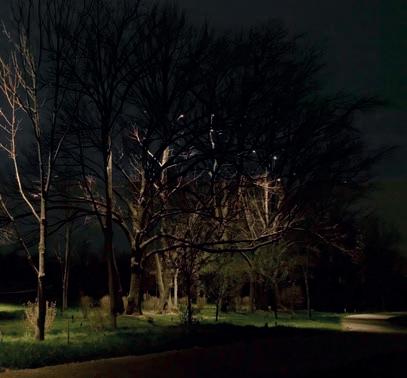
DOWNLIGHTING ONLY DOES NOT WORK WELL –THE LIGHTING DOES NOT LOOK COMPLETE
UP AND DOWNLIGHTING WORKS WELL TOGETHER AND COMPLETES THE COMPOSITION
By following a few simple steps, we can all play a part in using lighting in a more considerate and responsible way.
(Including good landscape lighting design principles)
Useful – every light we use has a purpose in the overall composition.
Targeted – all lights are aimed with accuracy.
Low level – lights can be as little as 30 lumens or less.
Controlled – dimmed, sensors, timers, or simply off when not being used.
Warm CCT – 3000ºK and 2700ºK is perfect for landscape lighting.
In landscape lighting, we also use several different accessories, including glare shields, hex louvres, and internal filters. These all help us to create the beautiful designs we do, but also further reduce light spill, unwanted glare, and potential light trespass.
The human eye is extremely good at adjusting to very low light levels, but high contrast levels need to be carefully decreased through thoughtful design.
Studies have shown that streetlights installed close to trees, and which use unnecessarily high light outputs with cool blue daylight colour temperatures, can often cause growth anomalies and unseasonal leaf
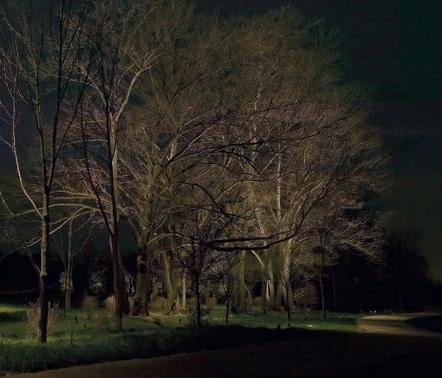
drop through confusion. This repeating cycle can have a long term and devastating effect on trees and can eventually lead to death.
Plants and trees require all three ultraviolet wavelengths for natural growth, but the amount and quantity that is used in good landscape lighting design is nowhere near enough to do any harm to growth. Commercial greenhouse growing, on the other hand, requires carefully controlled lighting for both growth and flowering. It is these types of installations which use high outputs for efficiency and maximise growth. Growth inhibition, disruption of circadian rhythms, or stress response are all referred to with the excessive exposure of blue light, which applies to high colour temperature and output luminaires. Any other information to the contrary should be taken with consideration and further investigation.
A trained and experienced landscape lighting designer would use an artistic approach rather than a prescriptive one. This design principle would include safety, security and aesthetics within the overall design, meaning high-powered floodlights are not usually required.
Good landscape lighting design will typically use fixtures with wattage outputs of between 0.5w to six watts, which equates to around 30 to 600 lumens per fixture, with many fixtures being used at around the one-to-three-watt range, or 90 to 300 lumens. These ultra-low outputs are far lower than a streetlight which starts at around 3000 lumens.
Garden and landscape lighting colour temperatures between 2700ºK and 3000ºK provide the most realistic results. These colour temperatures highlight the natural colours that already exist within the landscape. 3000ºK in particular, is my preferred choice of colour temperature, with other leading
landscape lighting designers around the world preferring this colour also, as it highlights most tree and shrub foliage the best due to saturation levels. This is our choice of colour as it works extremely well throughout the seasons with the ever-changing leaf colours.
From spring 2025, Foxholes Care Home in Hitchin, Hertfordshire will be opening its newly landscaped main front gardens each night for people to visit and see for themselves how good lighting design using extra low voltage and low wattage lights can enhance an area without causing damage to the night environment and surrounding wildlife.
This project will include a combination of 2700ºK with mostly 3000ºK being used via up and downlighting throughout the project. There will also be a Dark Sky setting for most areas after 10pm when the main lighting will be turned off via timed controllers. No booking will be required, so please feel free to visit. Seeing is believing. (Please note: These settings and descriptions are subject to final approval).

Neil Parslow is highly regarded as one of the UK’s leading landscape lighting designers. He has undertaken projects of various scales, both in the UK and internationally. Parslow has received extensive training and collaborated with renowned lighting designers from the US. His expertise encompasses designing and specifying installation requirements. Additionally, he holds certifications as a qualified tree climber (NPTC CS38 Tree climbing and Aerial Rescue) and is an NVQ3 Electrician to BS7671. He is a member of the Professional Garden Consultants Association and an affiliated business partner of the SGD. neilparslowdesign.com lightvisuals.co.uk


For all your Autumn planting projects and beyond why not give Spring Reach Nursery a try. Based in Surrey with over 25 years growing experience supplying leading garden designers and domestic landscapers you can expect a top quality service from initial enquiry through to delivery to site or collection. We have a superb choice of hardy nursery stock including some varieties that are not freely available.
• Always holding good stocks of those ever popular lines for immediate impact from large evergreen screening trees pleached panelled trees and multi-stems and specimen shrubs for immediate impact
• Thousands of Herbaceous perennials, Roses and Grasses for giving your design the wow in Summer and Autumn
• Conveniently situated just 10 Minutes from Junction 10 of the M25
• Deliveries made using own transport up to 150 miles or further a field by the pallet network.
Contact 01483 284769 | email info@springreachnursery.co.uk
Long Reach Ockham Surrey Gu23 6PG www.springreachnursery.co.uk


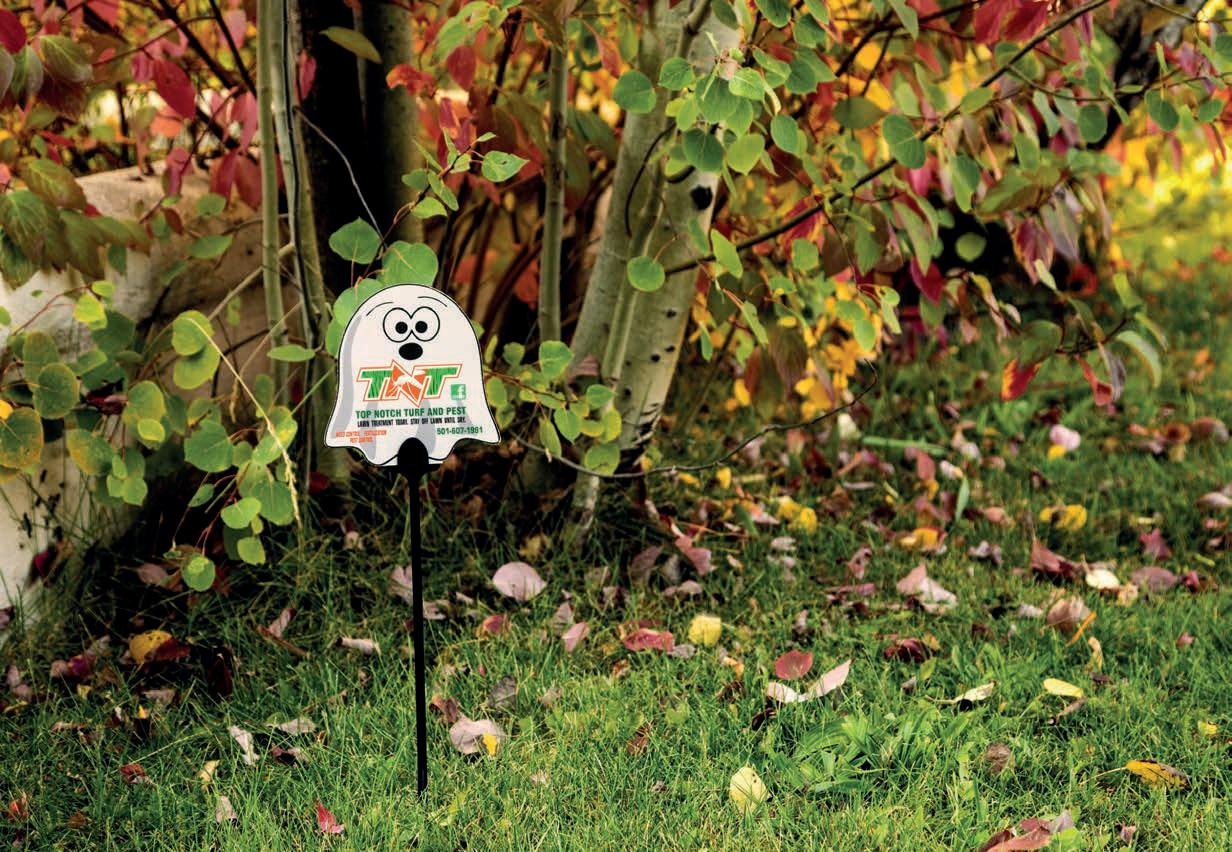

Whilst natural stone is undoubtedly a great option, David Keegan shares why porcelain paving has become his ideal choice when designing gardens in the northwest
When it comes to choosing the right paving material for outdoor spaces in the northwest of the UK, where the climate is typically wet and unpredictable, porcelain paving from my perspective as a designer offers a range of benefits that make it a superior choice over natural stone. While natural stone has been a traditional favourite in landscaping – and mine for many years too – porcelain paving brings modern technology and practicality together, making it an ideal solution for this region’s specific environmental conditions.
Porcelain is non-porous, meaning it doesn’t absorb water like some types of natural stone. This significantly reduces the risk of water damage, cracking, and the growth of moss or algae, which are common issues with porous materials in damp environments and a past bug bear of many clients. Natural stone, particularly sandstone or limestone, can absorb water and become slippery or stained over time. In contrast, porcelain’s water resistance ensures that it remains safe, durable, and easy to maintain in wet conditions.


Low maintenance
Maintaining outdoor spaces can be tricky where rainfall is frequent, but porcelain paving requires minimal upkeep. Its impermeability prevents stains from mud, water, and organic matter from seeping into the surface, which means it can be easily cleaned with a simple wipe or wash. Natural stone, on the other hand, often requires regular sealing and cleaning to prevent moss and algae build-up, particularly in shaded or damp areas.
Durability and longevity
Fired at extremely high temperatures, porcelain tiles are exceptionally strong, making them resistant to frost, fading, and cracking. Natural stone, while also durable, is more susceptible to weathering over time. Freeze-thaw cycles can cause cracks in more porous stones, leading to higher long-term maintenance costs. Porcelain, with its low absorption rate and tough surface, is far less likely to suffer damage, ensuring that it looks good and performs well for decades.
While natural stone offers a timeless, organic appeal, porcelain paving is available in an astonishing variety of designs, colours, and finishes, many of which are designed to replicate the look of natural stone. For example, you can achieve the luxurious aesthetic of marble or slate without the associated maintenance challenges. Porcelain tiles can be tailored to fit a modern, sleek garden design or a more rustic, natural look, allowing me, the designer, greater flexibility in landscaping projects. Its ability to mimic various textures while offering a range of colour options means that we can offer our clients a product that can achieve their desired look while benefitting from porcelain’s practical advantages.


Though porcelain production involves high-energy processes, many manufacturers are now moving towards more sustainable practices, such as using recycled materials and reducing emissions during production. And because porcelain lasts longer and requires less maintenance, it reduces the need for chemical treatments, frequent replacements and constant jet washing, thereby minimising its overall environmental impact.
For me, while natural stone has its merits, porcelain paving offers significant advantages in the northwest. However, if I was to caveat all I have just written, it would be that not all porcelain is created equal, and for me, it must have been manufactured in Italy.

DAVID KEEGAN
David Keegan is a multi-award-winning garden designer and writer. His work has, over the years, achieved international recognition, winning awards at the International Landscape Design Awards in the USA. He also writes extensively on garden and landscape design for magazines and book publishers in the UK and overseas. He describes his approach to garden design as tailored to each client rather than having a particular house style, with emphasis on the connection between plants, hard surfaces, and the garden users’ interaction with both. His motto would be ‘It’s All About the Plants’. dkgardendesign.co.uk


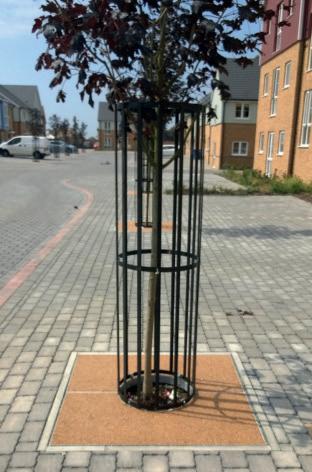
CIS Street Furniture offer a diverse range of street furniture which will complement any
As a result of the built environment compaction can inhibit or prevent natural root growth of trees. CIS SUDs compliant resin bound tree grilles are a great way of enhancing the sustainability of your project for future generations. Find out more at our website below.
Tel: 01483 203388 www.cis-streetfurniture.co.uk













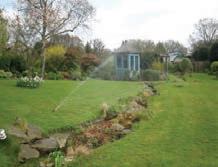












Pro Landscaper asks quick-fire questions to gain a small insight into the people who make up our industry. To take part, email content@eljays44.com

Garden designer and author, Debbie Carroll Garden Designs & Step Change Design Ltd
FUTURESCAPE 2024 Pro Landscaper Theatre Finding Your Niche: Passion | Anger | Mission
Why did you feel it was important to speak at FutureScape?
I was keen for people joining the industry to realise just how wide ranging the opportunities are and my own journey to be an expert on care and dementia gardens was not what I expected when I began. I wanted to share some of the highs and lows and some insights that have helped me along the way, and that may be helpful to others.
What do you hope people took away from the seminar?
Anything is possible if you choose to give it a go. Be prepared to be adaptable and to take a risk. Find and build your support network.
What advice would you give those seeking a niche? Follow your passions while keeping an open mind to the unexpected opportunities and an evolving world with
new needs we may not have even considered yet.
How did you find your niche in the industry?
I was asked to redesign three dementia care home gardens that had been designed before but fallen out of use. This felt like there was something missing from the design guidance out there. I didn’t want my gardens to fail too, so I undertook a research project with fellow designer Mark Rendell. The rest as they say is history; with Step Change Design formed to share the findings in both the care and design sectors, two books written and a range of other support provided to enable those who live in care homes to continue to enjoy stepping into the garden when they wish to. Strangely, I am now finding I am being drawn back into wildlife and productive gardens – which is where I thought I’d end up 20 years ago. So who knows which niche I’ll retire from in 10 years time!

Landscape architecture and garden designer, Peter Donegan Garden Design
FUTURESCAPE 2024 Pro Landscaper Theatre Going International: Broadening Your Horizons
Why did you feel it was important to speak at FutureScape?
You hope when you're 24 years of age that you'll do a gardening talk where three people turn up and your fee is a cup of tea or a bottle of wine. Then to get to a point where a publication like Pro Landscaper says, would you like to speak at FutureScape? It's a humbling honour.
What do you hope people took away from the seminar?
Hopefully people liked what I had to say, and if only one person had turned up but it made them smile, then you know, that's good.
How do you navigate the challenges of managing a project abroad?
Suppliers aren't always listed, or their products aren’t always listed. So take the time to just drive around the area and explore. Find the suppliers you need, do your research on
them, and you’ll likely find they're one of the largest kind of, say, manufacturers of natural stone.
What is the best advice for managing a project abroad? It's different everywhere you go. You’ve got to take a step back and just listen. The build is not the difficult part, it's about being respectful to how things are done locally, and the local changes when you're in Istanbul and equally Melbourne and equally France and equally London.
I think the difficulty as a designer is to do the right thing by the town and to eloquently do it so that you can stroll back in four years later and be remembered for all of the right reasons. Do your job, do your research, say hello and thank you. Ultimately be respectful, and once you do your job and they do their job, then everyone tends to work their magic.
